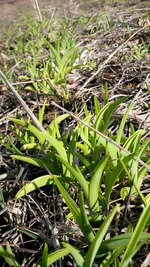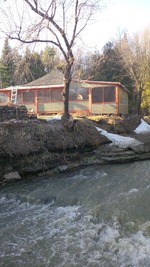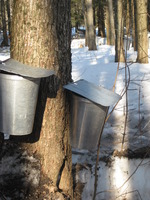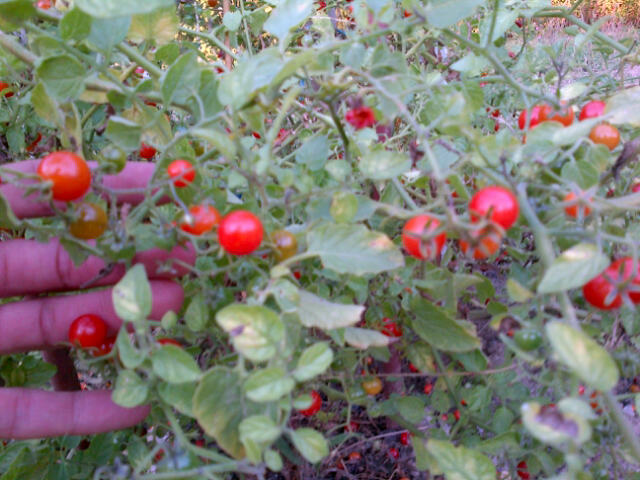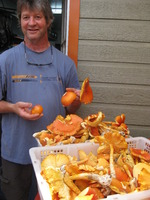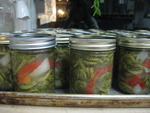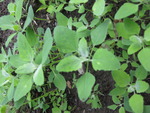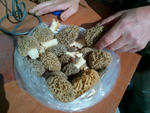August, Good eats
For a minute in August, I always get sad as many wild plants go to seed (the cycle over), which means fewer tender leaves for picking, but also that the array of beautiful flowers (some tasty too!) dwindles to a measly palette of golden rod, wild parsnip and aster for the tables, some yarrow for medicinal purposes.. You see, beyond cooking the wild edibles, picking wild summer flowers makes me happy – being surounded by the scents and colours, arranging bouquets for the house and restaurant.
Thankfully it’s always around the same time that mushroom season starts kicking so I don’t have much time to wallow. Not that ‘normal’ means anything anymore in terms of nature’s timeline apart from that. You’d think with all the rain and intermittent nice weather, it would be a good mushroom season, but apparently it's not a given yet. Like with many summer plants, marine greens and berries, everything is late. Looks like a good berry season though thanks to the water. The blueberries are amazing; we’re picking the first wild blackberries and sarsaparilla.
As for the shrooms, around here, the early summer boletes (like yellow granulee, pied rouge and glabrescent) are on their way out while the lobsters, lactaires delicieux are showing up. Chanterelles and porcini have been present for a couple of weeks, the Flocons and Black trumpets appearing now. Puffballs and Hedgehogs won’t be far off. Some Chicken mushroom, so Hen of the Woods soon too. Looks like it might be a better fall season, fingers crossed.
Some photos:
Other things that make me happy in August, not just wild:
Ontario peaches and they are good this year. Especially when you have a forager guy that can choose fruit like François. Peaches are best eaten as is, but during the season, inspiring to cook with too. I put some in my berrry chaussons and some compound salads at home (with something salty, think melon proscuito).
Fresh peas and favas, however a bad season for them, but the few sacs we were lucky to get were good, always labour intensive but worth it.
Corn – you need to buy (Denault’s) yellow at Jean Talon Market, so good. Look for Le Roi du Mais.. Corn on the cob, a rite of summer; great in salsas and compound salads, in soup.. A favourite sidedish this summer has been a new potato salad with corn, yellow beans, sweet pepper, sea spinach and our wild herb chimichurri.. Corn is a sure crowd pleaser in soup too: I nowhave a corn and wild mushroom chowder on the menu at the restaurant, a good way to use up all the broth I make from the empty cobs.
Back to the wild: sea spinach of course! My absolute favourite wild green, raw or cooked, especially just wilted with garlic, EVOO and butter or chopped up and added to a salad or pasta/rice dish/omelet... If you've never tasted it, it's just like 'super duper' spinach - more flavour and a touch of salt and pepper built in.. Like with spinach, I prefer the bigger leaves of late season available now and for another week.. Hopefully I won't be sick of it by week's end, the last stretch in my race of putting up for the year, hundreds of pounds, a good chunk for Joe La Croute's popular Popeye bread.
The sea rocket and salicorne are good this year too, if hard to find; the stormy weather and tides having completely transformed the landscape, forcing Francois, Claudie and team to hunt far and wide.
The downside to the foraging trend
La Faune et La Flore
Another hurdle for Les Jardins Sauvages
Good thing we’re made strong and love what we do!
Profile: Les Jardins Sauvages, Pioneer and leader in Quebec Wild Edibles. 28 years in business, constantly evolving.. Now with a permanent stall at Jean Talon Market in Montreal & acclaimed Country Restaurant in St-Roch de l’Achigan; 100+ products fresh, 100+ products preserved; A Forager and Chef team with experience, long committed to quality, local and wild, artisanal and sustainable food..
I'm told I don't toot my own horn enough, see I'm practicing..
In case you don’t know, Jardins Sauvages is the original wild foods business in Quebec. Long before anyone heard of Noma, François was foraging, the first to introduce chefs to wild greens and many local wild mushrooms. He spent years of walking the through the weeds & woods of Quebec to find healthiest spots to harvest each species; he intimately knows nature and how to pick for quality and sustainability – where, when, what time of day, what stage in the cycle. Working with Quebec’s top chefs, he refined his skills, learning what was best picked young, cooked in numerous ways. And now, I’ve been cooking his wild stuff for 13 years since I met him at L’Eau, on a full time basis since 2005. I’ve figured out what’s best how, say raw or cooked or dried, savoury or sweet, what mushrooms benefit from a sauté or a slow braise, how to put them up. We were the first to make mushroom ice cream and chocolate, to smoke mushrooms, to cook with cattail pollen, promote local teas & spices or pick and cook marine greens in so many ways - paving the way, showing people what could be eaten and how. Unlike some of the newcomers jumping on the foraging bandwagon, we know what we’re doing.
Nonetheless.. a few weeks ago, we got a visit from a couple of officials from La Faune et La Flore, a governmental arm that regulates the environment, forests and fishing. We should have nothing to fear, buy nay and yay, another battle is before us. They are banning crinkleroot and wild ginger, among other things, but these two affect us most, a dozen of our products, our menus.
The funny thing is that they were especially eager to pay us a visit because I had put wild garlic (ramps/ail des bois) on my menu this spring. In ten years, I never dared, but then I saw all Montreal chefs with ramps on their menu, and I figured if anyone should have them on the menu it should be us, given that the wild thing is our deal, we have tons on our property, and know how to harvest sustainably and all. Not to mention that it was just a few leaves from our field, ciselé as a garnish for a soup for 10 clients. Meanwhile, restaurants serving 100+ clients a night with anonymously sourced and less sustainable garlic don’t have an inspector in sight. BTW apparently, whether it’s from Ontario or New York, the law stands, not allowed. Anyway, it’s not like I’m tattling on other chefs, I just want to be able to do what we do. I have never even ever heard of a Montreal chef bothered by the F&F. It’s such a joke that they’re at our door.
Like with wild garlic, they have decided that crinkleroot and wild ginger are endangered species and need to be protected. We agree that they need to be protected, in that they need to be harvested with care and knowledge first and foremost, not completely ripping out the plants. Especially that the foraging trend means that there are new players in the game (many uninformed, unconscious or overly ambitious), evidently, some kind of general regulation is in order, maybe permits? In any case, there needs to be an official protocol for wild edibles, all above board, a traceability, an approved list of what can be harvested and how, where, by who, sold how and for what price, all registered. A common code of ethics was enough before, but given the current climate, we are all for this. However, it is complicated to regulate; for the govt, much easier to ban.
In the meantime, it certainly isn’t fair for us, for François who has been doing it properly for 28 years professionally and plus. He was the first to put most wild edibles on Quebec menus - before they were being imported from France (like salicorne, mushrooms) or simply weren’t known to chefs (like wild ginger, orpin, day lily buds, milkweed, arroche de mer, caquiller, the list is long..). He is in the same patches year after year, observing and taking care of nature while he harvests; he gardens the forest. We have more crinkleroot every year, more than enough wild ginger for our needs. He has seen the progress of the crinkleroot for 50 yrs+ because they are family spots. His family has always eaten crinkleroot; we continue the tradition of making his great-great grandfather’s Henri Rochbrune crinkleroot mustard, but 100+ years later, now we’re not allowed.
All to say, these plants obviously aren’t endangered in François’ hands. There is a way to pick that stimulates the plant if it is in a healthy environment; he knows when to leave it alone. He invited the govt officials to visit his terrain, encouraged them to follow him and bring their scientists/advisors to study his reality, to open their minds. He does not understand where they get their data. They’re worrying about fiddleheads and spring beauty? C’mon, just come here and see. How much we harvest from the same land every year. Their sources are from controlled studies, another micro-climate, labs, foreign or outdated books, I don’t know. One thing for sure is that the pencil pushers and botanists aren’t in the Que woods on a daily basis like François.
On top of it, we are a small diversified business, dealing in small volumes according to nature - a little bit of this and that, all sustainable, with our spots on private territory, maintained year after year, no big threat. We led the way, and now because wild foods are becoming popular, we are penalized. Because there are others including some hacks who are just in it short term for a bang or because they think they might like doing this but don’t know squat or care to do things right, or want to exploit a lot of one thing.
Not all foraged food is equal! There is properly sourced, properly harvested and there is ravaged. There is sweet, and threre is bitter. There is tender and tough; delicious and disgusting, nutritious and toxic.. Few in the marketplace seem to know or care about the difference. As long as it’s wild or Nordic, sounds good on a menu. Sadly, marketing seems to count more than quality or integrity. Obviously we have some marketing to do.
We hate to see so many bad foragers around spoiling it for the rest of us, but, it is also important to note that most of the destruction of vulnerable plants and biodiversity is due to development/urbanisation. François has seen so much simply disappear because of autoroutes, Walmarts, condos and parking lots.., way more havoc wrought this way than any bunch of pickers could do. More than once, François had proposed a solution to mayors/municipalities, say when they were bulldozing to make the 50, destroying so much rich land where there was tons of wild garlic, ginger, crinkleroot and much more; he wanted permission to go and save some of the plants. His project got bogged down in beurocracy and never worked out, but he said that in a day, he could have saved enough wild ginger to supply us and every chef for a lifetime. You’re not allowed to pick the wild garlic or ginger, but they’re allowed to bulldoze it. Doesn’t make sense.
It’s not just chefs and back-to-earth types getting into foraging. As the far away regions try to develop their resources and put people to work, the exploitation of the forest and land has become key. Backed by Govt money, they have been training unemployed volunteers to forage, small businesses opening and they’re all trying to find markets. All dandy in theory, but it’s a mess. Too many students expecting to make $$ picking mushrooms they can barely identify. Detached investors wanting to harvest too much. We have no choice but be implicated. François is working in Lanaudière and also with other regions as various agencies and business groups try to sort it out. They need his expertise, and he wants to make sure they aren’t making decisions that don’t stand up. For instance, the tentative list of mushrooms allowed for sale excluded 30 varieties that we use (because the powers that be don’t know them well enough). Like when François started selling wild mushrooms 20 years ago, many didn’t believe him that there were wild mushrooms in Quebec. He’s come along way, but now everyone is catching up to him. All this is so much time and energy in meetings and paperwork, just to be able to continue doing what we’ve been doing forever - now that the govt., big business, foodies, tree huggers and everyone else is waking up. It’s crazy and no one knows what’s going on behind the scenes.
I thought it would be smooth sailing for a while when we were finally fine with the MAPAQ (the food inspection part), but no now, it’s something else; I swear we have the most complicated business in the world! You see, they just don’t know what to do with us because we do something so different they don’t understand and it worries them. Whether it’s about picking nettle, cooking fiddleheads or milkweed, marinating mushrooms or smoking duck, they’re on our ass. All our products have passed all tests, but it was still a fight to prove that our mushrooms were properly dried, that our pickles and oils and etc are properly made, etc. Meanwhile, cheap imports don’t get any scrutiny, Montreal chefs have toxic plants garnishing their menus. I understand that there have to be rules and inspectors, but why just us? I know what I’m doing and it kills me to talk circles around the inspectors who don’t have a clue about what they’re inspecting. We’ve seen it in the field, the guys thinking we’re picking garlic and its trout lily, they don’t know the difference. In the kitchen, it’s the same. They just want to check off lists: They check your fridge/freezer temperatures, soap and towels next to the sink, all the norms etc; do you have a ph-meter, a register for your products, sanitizer.. Yes, yes, yes. Do you douse everything in Javel regularly and boil everything for 20min. They want you to be a stainless steel aseptic factory that makes one sterile product en masse, easy to verify. We do everything right but we’re not that. You need to be a fighter to be an artisan in Quebec.
It seems to me that we’re the kind of Quebec terroir business that they should be favouring, but no it’s too complicated. They really don’t make anything easy for a small, artisanal business ‘thinking outside the box’ in Quebec. Unless you’re in a far away region where there are subsidies (like most of the newbies). The rules, the taxes, the cost of having employees etc.- its all conducive to big business. We manage to win them over, proving ourselves one person, one product at a time, one costly fight after another. I wish I could just cut out the inspectors who are just doing their job and deal with their bosses, even better, exchange with their scientists.
I figure when I retire, I should get a job as a Govt inspector, I know more than most of them, and I bet the benefits must be nice.. But what a boring job, no thanks. I’ll continue to fight to make a living while focusing on quality, delicious local food; maybe teach them a thing or two along the way. And perhaps things will change one day; Hopefully we will go on to survive and thrive. Others will surely profit down the line. We’re constantly breaking down barriers, teaching, making people taste new things, opening markets, developing.. all while taking the heat and struggling to stay afloat. By nature, it is a difficult business venture; I could do without the extra headaches.
Our passion and vocation has become a cause, a crusade. A fight for anti-industrial small community based business, and for quality, local food and traditions - especially wild things harvested and cooked properly, with a love and respect of nature. That is and will be our legacy if anything, whether recognized or not. If only legacies paid the bills. Seeing L’Eau à la Bouche close after 35 years and a lifetime of Anne Desjardins’ visionary, pioneer work in promoting local artisanal food and top-notch authentic cooking, I know very well that life is not fair.. Oh well. I’m still not willing to trade my quality of life for another. Rant over.
Food day Canada
At les Jardins Sauvages, we are celebrating Food Day Canada Saturday, August 3rd!.
This is a national ‘holiday’ celebrating local food and good eating. On the same day, across the country, both chefs and home cooks (whole villages even) will be simultaneously feasting on menus composed of fresh and local products while raising a glass to our rich and diverse culinary landscape. Organized by Anita Stewart, acclaimed food writer and long time proponent of Canadian food, she has lots of great people and restaurants on board, check it out.. www.fooddaycanada.ca.
Of course, my menu is always focused on local, artisanal and wild foods, but I love this initiative. We should be eating like this year round both for our health and happiness, as well as for the land. I like the idea of fostering national and regional culinary pride, and I am all for another reason to get together over good food and wine, one day at a time. At the height of the growing season, every meal is so easily a celebration, so why not join in!
Our food day menu can be viewed below or at http://jardinssauvages.com/?nom=menu&res=m&m=canada13en
To reserve, please call 450-588-5125
Other news:
We were honoured to be selected among Canada’s top 20 artisans to participate in the ACE Bakery Artisan Incubator, then as winner of the top award, a year mentorship to help our business grow.. http://soupnancy.squarespace.com/blog-journalessays/2013/6/25/ace-artisan-incubator.html
Summer’s bounty is upon us with a wide variety of wild edibles available: the marine greens are peaking, the mushroom season starting.. Come visit us at Jean Talon Market, open seven days year round.
We also have several new products, like our wild steak spice, perfect for summer grilling.. And have you tasted our wild chimichurri, wild mushroom vinaigrette, wild mushroom oil and line of wild spices? All useful in summer cooking like marinades, salads, iced tea.. To see the whole list (retail/wholesale/vrac for chefs): http://jardinssauvages.com/?nom=produits Available at Marché Jean Talon, A la Table or on order, shipping extra.
Our annual mushroom event (11th edition) is coming up soon enough too! The official announcement and menu will be out in August, but the dates are set and reservation book open. Oct.18 to Nov. 3rd.
Hope to see you soon, and have a great summer!
Nancy and François, Les Jardins Sauvages
Nous célébrons ‘La Journée des Terroirs (Food Day Canada) A la table des Jardins Sauvages Samedi le 3 Août, 2013.
Ce jour, à travers le Canada, comme à toutes les années depuis 2003, c’est la fête de la cuisine canadienne, régionale et locale - les produits du terroir. L'idée c'est de créer un menu mettant en valeur de beaux produits de chez nous, bien manger et célébrer notre propre richesse culinaire - ensemble les chefs dans les restaurants avec leurs clients, et les gens au BBQ à la maison. Cet événement est organisé par Anita Stewart, une grande doyenne de cuisine Canadienne. www.fooddaycanada.ca
C'est certain que mon menu est toujours basé sur les produits locaux, artisanales et sauvages, mais je trouve cela une belle initiative. A la hauteur de la saison, c’est si facile de manger frais, d’embarquer les gens et les sensibiliser à la façon la plus saine et joyeuse de se nourrir.. En plus, une fête de plus au tour des plaisirs de la table - pourquoi pas?
Vous pouvez visionner mon menu ici en bas ou ici : http://jardinssauvages.com/?nom=menus&m=mcanada13
Pour réserver, SVP appelez 450-588-5125
Autres nouvelles Les Jardins Sauvages :
Nous avons été honoré d’être choisis parmi les meilleurs 20 artisans à travers le Canada invité au programme ‘Artisans en Croissance’ de la Boulangerie ACE, et gagnant d’un an de mentorat pour nous aider coté ‘affaires’. http://www.boulangerieace.com/artisans-encroissance/artisans/16/nancy-hinton-et-francois-brouillard/
C’est le temps d’abondance de plantes sauvages – le mesclun, les pousses marines et la saison de champignons sauvages du Québec commence tranquillement – venez nous voir au Marché Jean Talon ouvert sept jours à l’année maintenant.
Nous avons aussi quelques nouveautés comme nos épices à steak sauvages. Avez-vous goûté à notre huile de champignons, notre ligne d’aromates sauvages et Vinaigrettes Chimichurri sauvage, Champignons Sauvages? Tous utiles pour les marinades pour le grill et salades d’été, thé glacés.. Voir la liste complète ici (détail/en gros pour commerçants/en vrac pour chefs) : http://jardinssauvages.com/?nom=produits Disponible au Marché Jean Talon, A la Table ou sur commande; frais de livraison supplémentaire.
A la table des Jardins Sauvages, notre événement champignons approche.. L’annonce officielle et menu sera pour le mois d’Août, mais les dates sont fixes et le livre de réservations ouvert : 18 Octobre au 3 Novembre!
Passez un bel été. Au plaisir,
François et Nancy
Les Jardins Sauvages Menu
*Canada Food day*
August 3rd, 2013
,
Escabeche of turbot with sea asparagus and Canadian sandspurry,
smoked tomato and Nordic shrimp, wild salt herbs with lovage,
crinkleroot leaf and bee balm, Ontario Kernal peanuts
Corn and wild mushroom chowder
with cattail broth and sea spinach, sea lettuce
Roast organic Muscovy duck from Morgan farm
and choucroute salad with kohlrabi, juniper and sea rocket,
daisy and wild berry mustard
Venison from the farm, wild steak spice,
eggplant and Moulin Bleu buckwheat crepe gratin
with wild lamb’s quarters and garlic,
caponata with pickled day lily buds
Option : Quebec Cheese plate – a selection
from the region, chutney and homemade bread
(100g for two; 20$ supplement,10$ per person)
Wild blackberry, blueberry and elderberry chausson
with sweet clover flower, sweetgrass milk jam,
elderflower jelly,
wintergreen chocolate pudding
Tea, coffee
Wild leaf & flower tisane, Fair-trade espresso
(4$ supplement)
85.00$ tax included, service extra
(73.92 + 3.70 GST + 7.38 PST)
Bring your own wine
Your chef : Nancy Hinton
Your host and forager : François Brouillard
28 years the pioneer of Quebec wild edibles
Menu du 3 Août
*Canada Food day; Journée des Terroirs*
3 au 25 Août, 2013
Escabèche de turbot avec salicorne et spergulaire,
tomate fumé et crevettes nordiques, herbes salées sauvages avec livèche,
feuille de carcajou et monarde, arachides Kernal (Ont)
Chaudrée de maïs et champignons sauvages au bouillon de quenouille,
arroche de mer et laitue de mer
Salade de canard Barbarie bio de la ferme Morgan,
choucroute et chourave avec genièvre et caquiller,
moutarde de petits fruits sauvages
Cerf du domaine aux ‘épices à steak’ sauvage,
gratin d’aubergine et crêpe de sarrasin (Moulin Bleu),
chou gras et ail, caponata aux boutons d’hémérocalle
Option : Assiette de fromages de la région,
chutney et pain maison (100g pour deux;
supplément de 20$; 10$ par personne)
Chausson de mures, bleuets et sureau sauvages aux fleurs de mélilot,
confiture de lait au foin d’odeur, gelée de fleurs de sureau,
pot de crème au chocolat et thé des bois
Thé, café
Tisane maison, Espresso équitable
(supplément de 4$)
Apportez votre vin
85.00$ taxes incluses, service en sus
(73.92 + 3.70TPS + 7.38TVQ)
Votre chef : Nancy Hinton
Votre hôte et spécialiste de plantes sauvages: François Brouillard,
Les Jardins Sauvages, un pionnier depuis 28 ans
ACE Artisan Incubator
The Ace Bakery Artisan Incubator in Toronto was one hell of a fantastic week end! So much fun, inspiring and enriching.. A select few of us artisans across Canada were invited to this event sponsored by Ace Bakery, and wow! did they show us off and treat us like rockstars, all while giving us tools to grow/improve our business with the conferences - a real treat. http://www.acebakery.com/artisan-incubator/workshops/
I met so many amazing people and sampled an array of stellar Canadian products. All of them are the epitome of what they should be, in that they are made artisanally with locally sourced ingredients, utmost attention to quality, and hands on traditional methods - so more tasty, natural and crafted than most similar products you might be used to. You need to seek these out for your pantry or to offer as gifts, you won’t be disappointed..
- A real traditional method Cdn balsamic vinegar –Venturi Schulze, BC
- Cold pressed canola oil and flax seed oil (this is a revelation to anyone, just have to taste!) – Highwood Crossing, Alberta
- Ontario Peanuts and peanut butter, fresh and natural and local! Kernal Peanuts Ltd, ON
- Local, ethical and humble sausage and charcuterie: Chorizo and Saucisson sec – Seed to Sausage, ON
- Cream cheese like you haven’t tasted before – Grey Rush, Primeridge Pure, ON
- Other great cheeses (not only in Quebec!): Cow’s Creamery, PEI; Upper Bench Winery and Creamery, ON
- Chocolate, fair trade with local flavours and lots of personality – Choco Cocagne, NB
- A birch syrup that really is delicious – Uncle Berwyn’s Yukon Birch Syrup, Yukon
- Kimchi, sauerkraut, fermented beverages – Pyramid Farm and Ferments, ON
- If you’re into fancy salt, we have a Canadian ‘fleur de sel’ that tops any, great texture – Vancouver Island Salt Co.
- Lavender condiments that are perfectly dosed – Sledding Hill, BC
- More wild things: Origina spices, QC; Candied spruce tips and oil – Upriver Commercial Fishing, BC
- Gelato, traditional and local, neat flavours – Bella Gelateria, BC
- Pub cider and Ice cider syrup (again, not only in Quebec!) - Spirit Tree Estate Cidery, On
- Sour cherry spread – Over the Hill Orchards, Saskatchewan
- Marinated oyster mushrooms – Champignons Charlevoix, QC
- Apple vodka – Ironworks Distillery, NS
Check them out here: http://www.acebakery.com/artisan-incubator/artisans/
Initially, I applied on behalf of Les Jardins Sauvages as an artisan for this contest/program without really knowing who Ace Bakery was. I guess because I live in Quebec and don’t shop at Loblaws. They mounted a campaign with chefs and food industry people, and were looking for the best artisans across Canada to celebrate and promote. We were of course happy to be selected in the top twenty among the 150 applicants, so I signed all the papers and kept up with what had to be submitted. When the date came, I couldn’t help but wonder if I was once again putting my energy in the wrong place, after filling out so many forms, writing recipes, sending out product and etc, while being so busy running our business on the side, not to mention having to close the restaurant for a week end and missing out on a best friend’s wedding.
Lets just say, I left home ‘en reculons’, leery and weary. Only to arrive in Toronto to a series of surprises. First of all, there were the luxuries like the limo at the airport, the swish hotel, the package with taxi chits and spending money etc. – extravagant and superficial maybe, but very bonus to a poor artisan. It would have meant nothing if it hadn’t been for the rest. Most importantly, the Ace Incubator was a big, professional, hyper-organized event focused on us artisans, and it was fun! Ok, there were a few hiccups, but what they were doing was super ambitious. As a chef and caterer, I thought they were crazy given what they were trying to execute, with so many different venues, chefs, formulas and recipes etc.
I quickly saw that all of us were winners simply by being there, to benefit from the exposure and the expertise/resources offered via the panels, to meet and share with others in the industry, mega networking that happens naturally, kinship throughout. I hardly had a chance to spend enough time with everyone I would have liked to; I wish I had attended many other workshops. So much to learn from others and not enough time. However I did have many inspiring conversations and forged some lasting connections. It kind of felt like being at summer camp; when in a short time, you feel like you’re living something important and these people might be friends for life.
Some photo highlights via Ace Bakery https://drive.google.com/folderview?id=0B8J2TJl3QtdCOFkwUEFyWV9weUU&usp=sharing#grid
Wrap up video – Ace Artisan Incubator Launch Event http://www.youtube.com/watch?v=RNFokMw7Vfs&feature=youtu.be
At the end of it all, it was an intense, stimulating, fun and inspiring weekend, and all thanks to Ace Bakery. So ironic, me the anti-corporate idealist. It’s not like I don’t know lots of cool rich people (like my customers) and I do believe in capitalism to a certain extent, but I can’t help but be a bit disillusioned as an artisan in an economy that seems to favour the opposite. So, it was especially refreshing to me to see successful business people who are full of heart and still grounded, so warm and generous, who would want to put so much selflessly into such a project. Ok fine, there might be a bit of marketing in there, things they can write off.. But only a special kind of person and company, true philanthropists would choose such a complicated route to give back. It’s because they know what it is like to be an artisan starting from scratch, living the hard life of knocks and what a small company needs; they recognize the value and want to sustain, help support this integral segment of society. When you know the Ace story and see how they grew from nothing, all while sticking to principles (and giving), it all fits – them doing this today; but still, its rare and impressive, heartening. It actually floors me.
This is just what the doctor ordered to help me from becoming prematurely crusty and cynical after so many years in the business. And then there is my partner François, the pioneer forager with 26 years professionally and a lifetime under the belt, the first to put wild foods on menus, always sustainable and with respect to nature, now getting lost in the fray of newcomers less so.. Any recognition (and practical encouragement) is welcome; we needed this.
We will benefit from their mentoring and resources to help grow our business following our needs. This is huge because we are typical artisans caught up in the day to day, who are both lacking and only lazy when it comes to business-sense and PR-marketing. Because we are such a unique, complicated business with so many limited seasonal products, not one thing to mass produce, it will be a challenge to apply big business rules. But there are many ways that their expertise can help to make ‘living the dream’ as passionate artisans more of a viable enterprise. And for that, I am grateful, because it’s something to start thinking about at our age.
A video of me via Ace Bakery http://www.acebakery.com/artisan-incubator/videos/
Good thing I got out of my kitchen this weekend and went to Toronto. I wouldn’t want to live anywhere but the Quebec countryside, but I have to say that a visit to Toronto always provides a good kick in the butt (and there are no mosquitoes!). Everyone is so presentable and industrious, very nice, albeit stressed and rushed. The mantras wafting through the air can be annoying or energizing depending on your state of mind – Cruising around, I see, feel, smell and hear: ‘Show off your best. Make things happen. Polish your shoes and your nails. Get your business in order. Go to bed early. Don’t smoke..’ The camomile growing on the side of the road doesn’t smell like anything, not like ours. Its strawberry season and no one knows it. Whatever, I went home with renewed focus to work on our business, while staying true. With a mental note that there is a lot to learn in the big city. In parallel, I will pay more attention to the rest of Canada. I love Quebec and everything local, but there is so much cool stuff going on across the country; we need to step out of the two solitudes and embrace it. It was so much apart of my identity before and then I slowly became more Quebecoise than Canadian. This weekend made me dust off the Canadian flag in my bedroom regardless of Harper.
More Photos from the week end https://drive.google.com/folderview?id=0B8J2TJl3QtdCOFkwUEFyWV9weUU&usp=sharing#grid
June 2013, the month of plenty
What’s in season? So much! Our menu says it all.. Jardins Sauvages summer menu July
No actually, not even quite – there is only so much you can jam into one five course meal..
Photos: Until I can find the time to fight with my blog, this will have to do:
https://www.facebook.com/media/set/?set=a.403586316349603.80613.248095141898722&type=3
C’est l’abondance! In St-Roch, this is the best time of year for variety of wild edibles – shoots, greens, roots, flowers, vegetables.. And with all the rain we’ve had, everything is green, the wild plants better than ever, gorged with water hence less bitter; things are going fast. As long as there is the occasional sunny, dry spell, this is all good for us. Except that we have to be on our toes; if mother nature is on speed, we have to follow or miss out for the season, not to mention our mission of putting up for the year.
Our mesclun has morphed, officially more summer than spring now with lambs’ quarters, live forever, daisy, lady sorrel, garlic mustard leaf, some crinkleroot leaf still, a variety of petals for colour and zip.. The last of the spring beauty, violets and acacia, rose petals and day lily moving in..
The marine greens are starting to come in from Kamouraska: beach peas, goat’s beard, sea parsley.. It won’t be long before we happily add sea spinach and sea asparagus to the basket.
Thanks to a wet month of June, local mushrooms are showing up early – its still morel season in some parts of Quebec, but here already some choice boletes like the yellow (bolet granule) and orange cap, as well as wine caps.
Milkweed broccoli is out, daisy buds too. We have a few weeks ahead focused on the oh-so-popular (but labour intensive daisy buds). The cattails aren’t far off, another big job with a short window. We peel the young cattails and then harvest the next stage – the pollen, drying and pulverizing it to make a flour/seasoning. For a week, my kitchen is covered in yellow dust and I blow my nose yellow at night. Goes with the territory, like black fingernails in mushroom season.
Let’s just say that cattail season (also elderflower, sweet clover, wild strawberries, the first mushrooms..) is not good timing to take off.. But as it happens early, François will be in ‘le grand nord’ for a week of fishing and prospecting, and I will be in Toronto representing Jardins Sauvages for the Ace Bakery Incubator Awards; hopefully we won’t miss out on too much with everything sprouting so fast..
Amidst it all, I try to occasionally get my coureur des bois and forager for the stars (or as he prefers to be called, Jardinier de foret) on tape. It’s all very on the spot and amateurish, but a fun start.. I promise we will make a point of capturing the moment more often and hopefully get better at it in time, with more English too once I get used to my phone/camera, keeping in mind that following François is never easy. So, anyway, here are the little videos on foraged wild plants we have so far.. (In French, although I usually throw in a word or two of English if I remember to): http://www.youtube.com/my_videos?o=U
Finally, signs of spring
After a rough winter, it feels like spring is late, when in fact, it is right on schedule and 'normal' if that means anything anymore. I'm a winter-lover, but this year, I'm more eager and ready than ever.
Well, there is still snow in the woods and chilly nights, but spring is definitely in the air.. We're not near tripping over morels, but François has picked his first sprouts and is getting ready for the first fiddleheads. Everything is going to start popping in the next couple of weeks.
Trout lily/Erythrone, the first green: here François picks and talks - an impromptu video filmed by an amateur, sorry in advance for the yelling. In French. Francois à l'érythrone
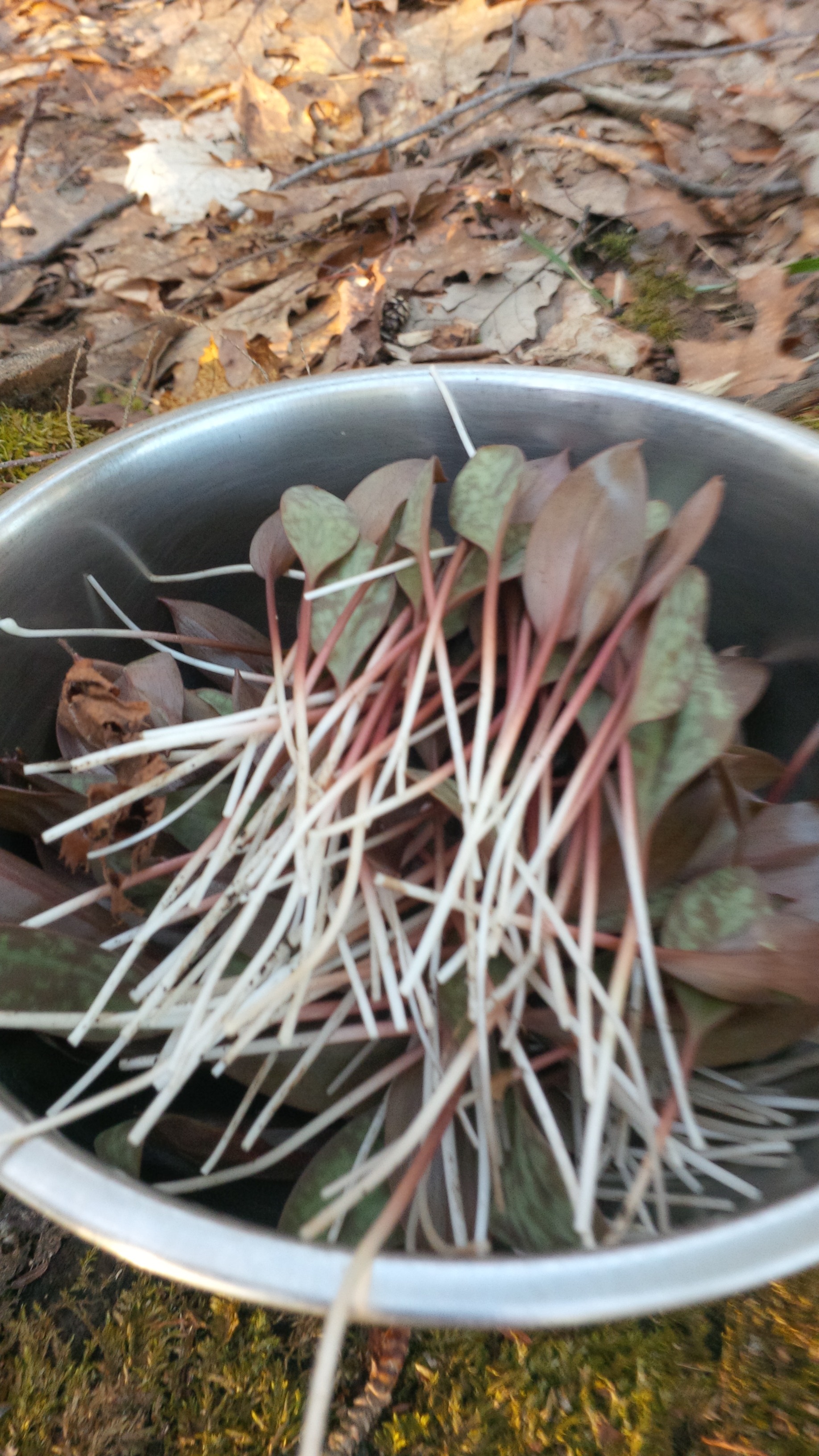
Day lily sprouts
We have a field of these on our property, so we always pick a few to cook up as a spring vegetable – kind of like a leek but a shorter cooking time and milder taste. We’re not sure if we’ll bring some to market or not because the problem is, it seems to inspire people to go picking any other lilies in the city, eating them raw and stomach aches bring inspectors our way even if we have nothing to do with it.
Coltsfoot/Tusselage
This is for my apothecary more than my kitchen, being a pulmonary tonic and good for a cough/sore throat. I use it in my winter cold remedies, tisane and cough syrup. It is the first bloom before dandelion. The spring beauty is starting, nettles are at the baby stage.
It will be the first week end for our spring mesclun at the market, starting with dandelion greens, trout lily and spring beauty, evolving into a more colourful and complex medley, less bitter and sweet as the season evolves.
Although every season feels new, if I look back, I can’t help but think I sound like a broken record, getting excited about the same wild edibles and describing them over and over again eachyear.. So I will keep it short and sweet, but if you’re just tuning in now and want more detail about these spring edibles, here are but a few links to previous posts:
Spring plants from 2012 http://soupnancy.squarespace.com/blog-journalessays/2012/4/14/spring-is-springing.html
Spring plants from 2011 http://soupnancy.squarespace.com/blog-journalessays/2011/5/5/spring-has-finally-sprung.html
And yUpload Filees, its that time of year again - to calm everyone down and reiterate About Fiddleheads.. Dangerous or not, How to cook http://soupnancy.squarespace.com/blog-journalessays/2012/5/14/fiddleheads-for-once-and-for-all.html
When the season peaks, I will make a video - maybe that will get the message across.
Our spring menu at La Table des Jardins Sauvages starts this weekend and the first workshop dinner is on Sunday the 28th at 4pm.
Les Saveurs du Palais
Les Saveurs du Palais
http://www.lessaveursdupalais-lefilm.com/
A must-see foodie flick that opens in Montreal theatres this Friday March 1st..
About a feisty female chef from the Perigord countryside who is called to cook for the French president, based loosely on Danièle Delpeuch and François Mitterand. He wants his grandmother’s cooking, tasty traditional French food, nothing complicated, no superfluous sugar roses. She is perfect for the task, yeshe faces many obstacles with the male brigade in the main kitchen and his entourage heavy on bureaucracy, formalities and prejudice. Nonetheless, she manages to seduce the President with her inspired old-school, ingredient driven, flavour forward, real food with personality. However, her strong character, unconventional ways and disregard for protocol when it comes to the business of good food does not endear her with the stiffs that make up the oiled machine of the Elysée. Rumours swirl. And then, the doctor and dieticians intervene, followed by the accountant.
I won’t give away anything more, not that it really matters; it is much richer than any plot line. The characters are well developed, the story is engaging, there are many layers of nuance and real life moments, food/societal issues and messages.. The sumptuous food just enhances everything, bringing the characters and themes to life in a deep and touching way. Making you salivate the whole way through too! I know François was having a hard time sitting still, wanting to jump out to make himself truffles on toast or go about layering beef with onions and anchovies.
Meanwhile, I was just thinking how this film struck so many chords with me, how it was about soo many important things.. About real food and authenticity all round, simple pleasures, and how meaningful that is. Food that tastes good, with a story. Food that connects you to real people, family and history. Memories. Terroir. Personality over pretence. How so much that is real and good can get lost in politics and business (diets too).
And then in another of their few intimate sit-down exchanges, when the president says to Hortense, ‘Adversity is a spice of life’, I felt like that was a strong message too, considering her predicament, and his.. How she stayed true and kept on going. The whole ‘female chef’ thing could be another topic brought up, be it with respect to food and history, nurture/nature, or just breaking down barriers in the professional world.. It was a part of the story, a woman with all her particular strengths and weaknesses, in a macho world.
This movie was above all just great, so very human, heart warming and funny. I can’t recommend it enough.
I missed the official opening with Montreal en Lumière, I was lucky to see it with Cinémagique, a film club that shows interesting films not necessarily accessible otherwise – check it out!
Paleo diet
The Paleo diet and ‘diets’ in general
Eating well in the Modern AFU age
The Paleolithic (Caveman) diet, inspired from our hunter-gatherer ancestors is naturally one our body understands and assimilates best. It just might be the light for so many lost western stomachs.
For the record, I don’t believe in ‘diets’ persay.
However, a smart friend of mine who is also a good eater swears by this Paleo thing, so if you suspect your eating habits need an overhaul, maybe you will be inclined to read more (links via modpaleo.com). As far as diets go, it’s as sensible as they get.
She seemed puzzled that I wasn’t overly enthusiastic about her Paleo nirvana, figuring it would be up my alley. It is true that many of the tenets correspond with what I promote.; the oldest diet in the world naturally excludes anything processed, all meat is natural/pastured, greens and vegetables are central. My eating habits align with Paleo more than a conventional North American regimen. Most of it is actually just normal to me, being the chef for a hunter-gatherer. But there are just a few too many extraneous rules for my comfort. There are too many lovely things not allowed or frowned upon (certain fruit, peanuts, dairy, rice and grains ie pasta, bread..). No matter how wild we are, I do appreciate the benefits of agriculture done the right way. I like to believe we have learned a couple of things in the last 10000 years.
Bottom line, I firmly believe that food should be delicious and fun and relatively stress-free. A daily celebration! That said, in order to let loose and be carefree definitely requires some kind of investment first, that is a source of good wholesome real food and some cooking. Because the truth is that our modern agriculture and food supply systems have mostly gone to shit, unfortunately.
But it doesn’t have to be so complicated! If you eat a variety of real food and cook at home, mostly avoiding industrial crap, supermarkets and restaurants that serve it; with fruit and vegetables occupying a major role, natural meats, eggs and cheese in reasonable portions, then I don’t think you should have to worry about anything, be it salt, sugar, fat, cholesterol, digestive issues, energy levels or weight.. After that it’s just about portion size and exercise, maybe.
I feel like life is too short to make your life miserable when eating thrice daily can be such pleasure. Not that I’ve ever followed any ‘diet’, yet I can’t help but observe that most extreme or painful diets don’t work long term.
Eating locally and seasonally as much as possible helps guarantee quality produce, makes it tasty and fun and easy to focus on the good stuff - growing your own and putting up, or simply knowing where your food comes from. A lot of people accustomed to the superstore would say this is more complicated than any fad diet, but once you've figured out the sourcing, it's easy to work into any schedule. Buying half a cow (or venison) is a one stop shop for the year. Going to the market or getting baskets delivered, putting two hours a week aside for prep - investing in your meals.. So that you have a fridge and freezer full of food that is good for you - all to easily put balanced, tasty meals on the table that will make you happy, no headaches.. Have fun cooking and get to know your vegetables! There should be a big splash of Green in every meal! Use lots of herbs and spices too – behind the flavour boost, there lies a natural arsenal of antibiotics, anti-oxidants, digestive aids and mood stabilizers. And then you absolutely don't need to worry about a peanut or a slice of good bread or banana muffin, an occasion potato chip.
If the new normal weren't so out of whack, there would be no need for diets. Or as much medicine either. Besides, there are plants for that too!
In the meantime, there is no doubt that it wouldn’t hurt most Westerners to embrace the Caveman diet. If it’s a ‘diet’ that it takes to make you eat local vegetables, pastured meat and avoid soft drinks, , Twinkies and packaged chicken fingers, to opt out of big ag and the industrial processed food corn sugar business - then ok, I’m all for it.
I will however remain a ‘diet’ free girl or perhaps I could say a post modern Paleo (who also eats grains and dairy, albeit in small quantities compared to greens).. Or 'deluxe Grandma' (not so different from our grandparents with more variety). Whatever.. My body tells me it is ‘right on!’ If ever not the case, there is always stinging nettle tea, slippery elm or Chaga and etc. to help out..
'Live in each season as it passes..'
“Live in each season as it passes, breathe the air, drink the drink, taste the fruit, and resign yourself to the influences of each.” Henry David Thoreau
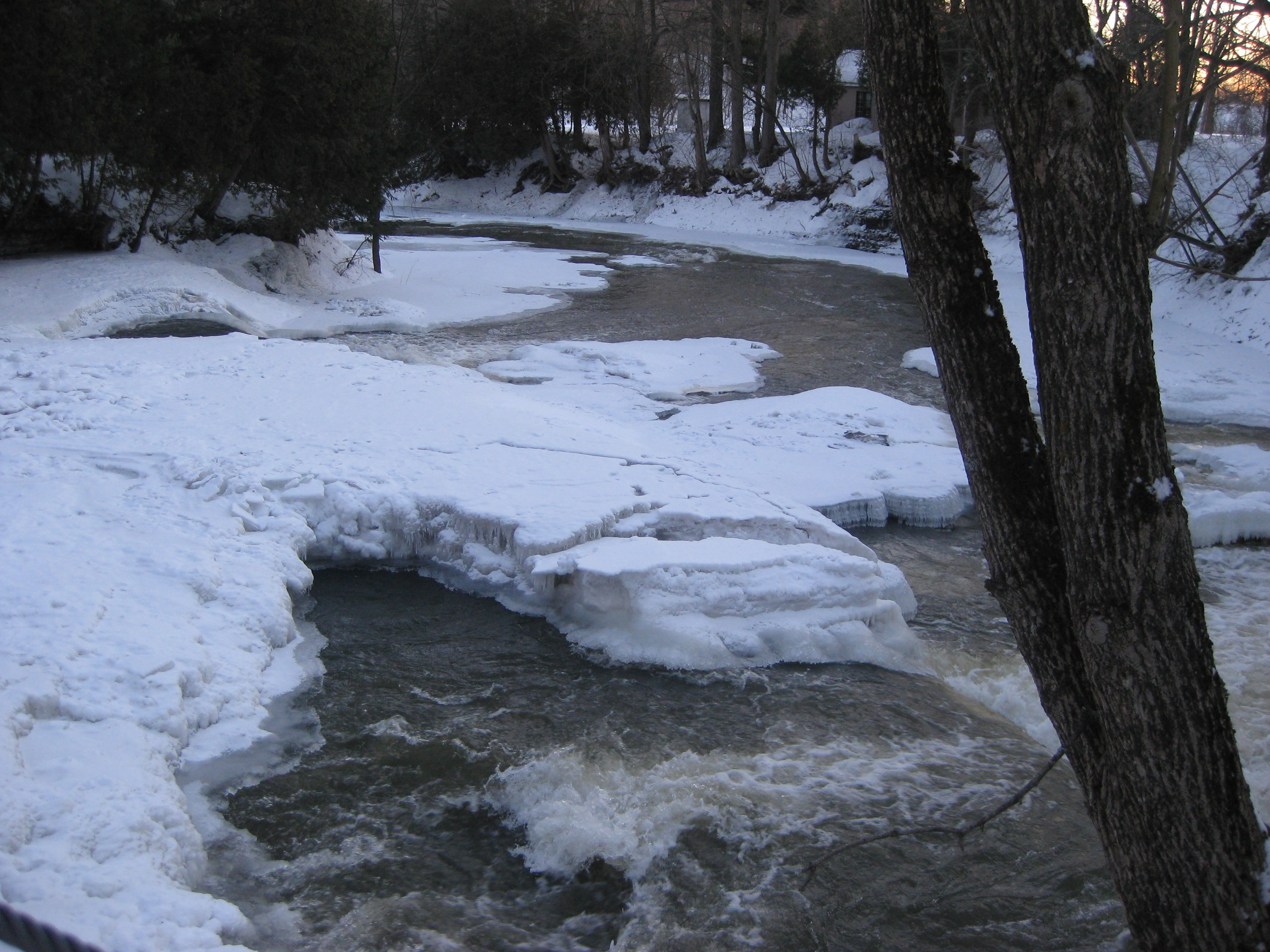 The view from my smoker (smoking my duck)I’m doubly inspired to share one of my favourite quotes with you..
The view from my smoker (smoking my duck)I’m doubly inspired to share one of my favourite quotes with you..
For all the winter haters out there, I’m tired of hearing you whine. Get out there and enjoy it! Soak up some of that bright sunshine, put on a pair of snowshoes or skis, play in the snow, and relish how sweet the crisp, fresh air feels.. Spend time in the kitchen cooking comforting dishes; share a hearty wine-soaked meal with friends next to a fireplace. Visit a Nordic spa. Snuggle up on the couch and read a book. Like ‘The Kitchen Daughter’ (a novel I loved). Root through your bookshelf and you're sure to find a long lost treasure such as my latest retrouvaille, ‘The Great Chefs of France’. Pick up a glossy, inspiring cookbook such as Jerusalem, Toque, Joe Beef or anything by Thomas Keller. Maybe some heartwarming foodwriting (Ruth Reichl), stimulating (Taras Grescoe) or laugh out loud (Jeffrey Steingarden). Or how about one of those 'Canada Reads' picks..
I love winter for all those reasons, and also because my cooking takes on a different tone, the kind of food that only feels right at this time of year. Less inspired by all the fresh and local produce, it’s more about going back to the classics and creatively using inventory, making the most of my preserves. There is less green crunch and more duck fat. I dip into my freezers, reorganizing them. I spend time admiring my gardemanger as I pull out a jar of pickled beans, smoked shrooms or crinkleroot canned tomatoes, enjoying all that hard work of putting up in summer. With a lot more time alone in the kitchen too, I have time to take stock, to look back and think ahead, to play catch up – be it with cleaning, operation details or recipes. To work on new and parallel projects – like my blossoming apothecary!
 a glimpse of my witchery: medicinal plants, essential oils
a glimpse of my witchery: medicinal plants, essential oils
Back to the second trigger for the Henry David Thoreau quote..
Another annoying thing that has occasionally interfered with my good winter mood is all the premature maple talk, which seems to have started right after Christmas – in the media, themed dinners and events all over. Granted, there is nothing wrong with celebrating one of our national treasures anytime if it makes you happy. Rather, it’s the undercurrent relentless rush to 'the next thing' permeating our culture that bothers me. Perhaps led by journalists and wannabe trendsetters who need to be the first to showcase what is new and hip.. Definitely, there is the commercial machine wanting to cash in on Valentine fervour as soon as the X-mas trees are down and on Easter bunnies as of Feb.14th. Go to a boutique in winter and you only find summer clothes – this has always baffled me. And local ‘market cuisine’ restaurant menus that follow someone else’s seasons?!!
Why can’t we just savour the moment and take things as they come really. Like enjoy winter now and get excited about maple syrup when the sap is running in earnest in a month or so. Next thing it will be morels, peas and asparagus on menus, magazine covers and blogs two months in advance.
Trust me, following our own seasons tastes better. And every season is beautiful if you take it in, pay attention and live it fully. If there’s anything I’ve learnt living and cooking on the wild side in the country, it is this and I’m happy for it.
For myself anyway, I honestly cannot be inspired on an artificial timeline; I don’t ‘feel it’ until it’s in the air. I have a hard time putting out a menu in advance, yet from a business point of view, I have realized I have no choice. I still wait until the last appropriate minute and inevitably make changes when the day arrives so that it absolutely rings true. With a job/vocation fuelled by passion, integrity, and so much blood, sweat & tears, I just couldn’t have it any other way. Besides, I just love the seasons, I don’t want to be thinking about the next one until it’s time, life is too short.. It would feel like a betrayal. Maybe it is my way of staying grounded and paying tribute to nature and ‘God’ and all my blessings..
So, in the dinosaur spirit of hanging on to the moment, I will be cooking my Wild & Aphrodisiac Valentine’s menu until Sat. Feb.23rd, and then we close in March (at La Table, not the market), a break to take advantage of winter’s end and regroup. And when the maple season is actually peaking and we have fresh sap and syrup, we will start again with a wild maple themed menu!
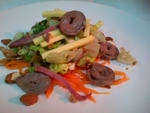 duck heart salad with duck egg, smoked duck, carrot, pickled mushrooms, wild mushroom vinaigrette
duck heart salad with duck egg, smoked duck, carrot, pickled mushrooms, wild mushroom vinaigrette
Duck, duck.. And Recipes
I just love my duck
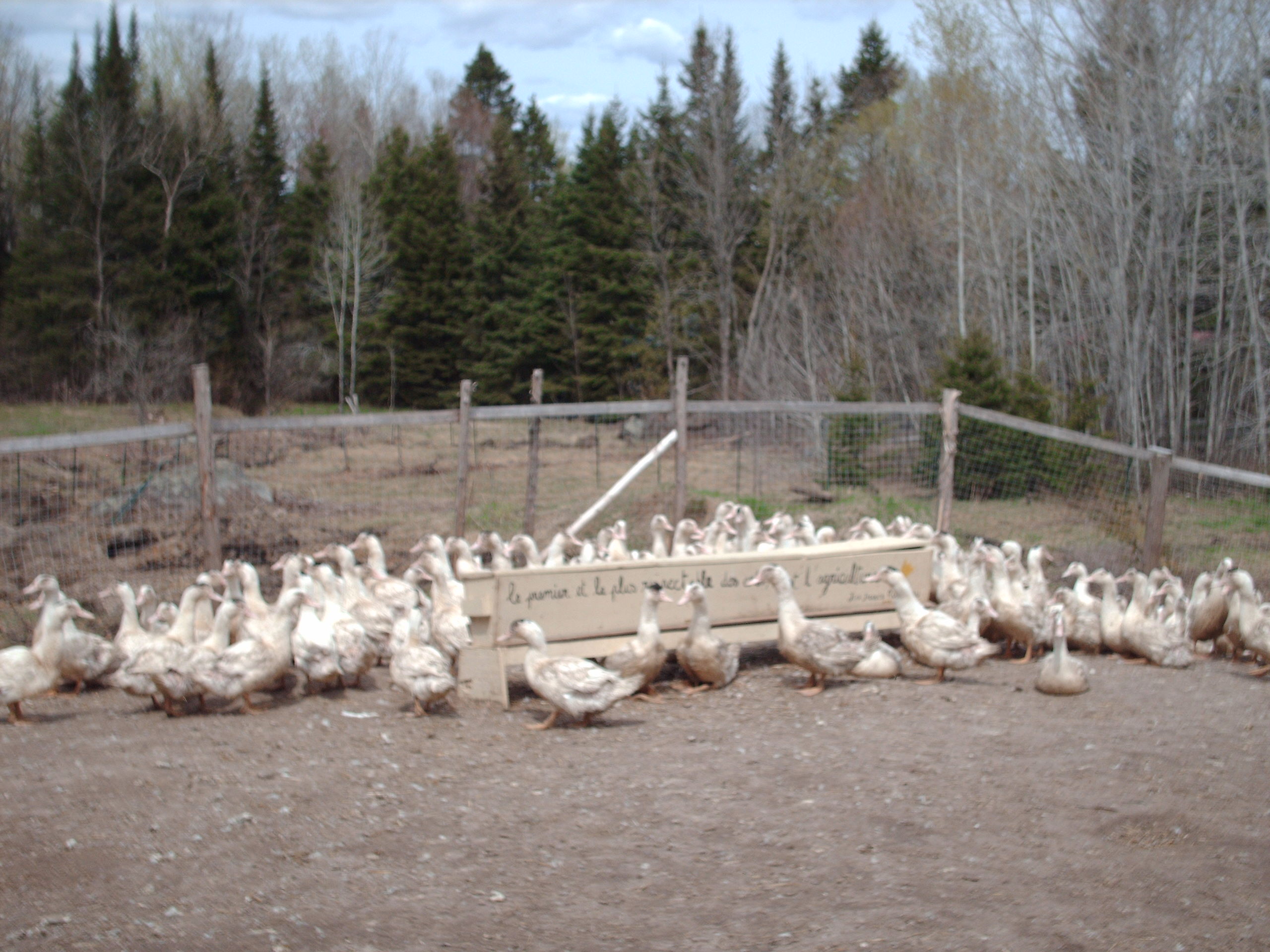 Moulard ducks
Moulard ducks
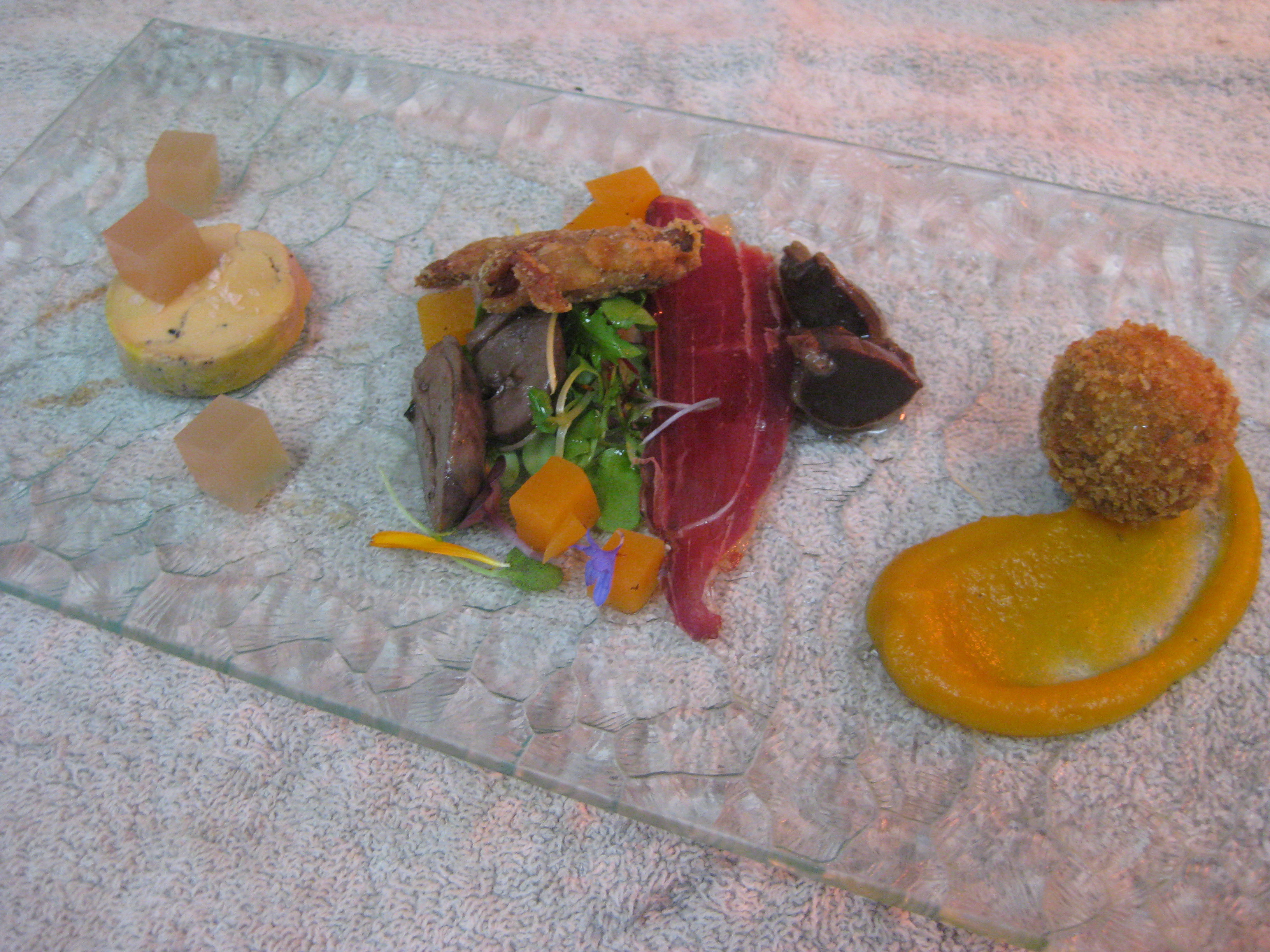
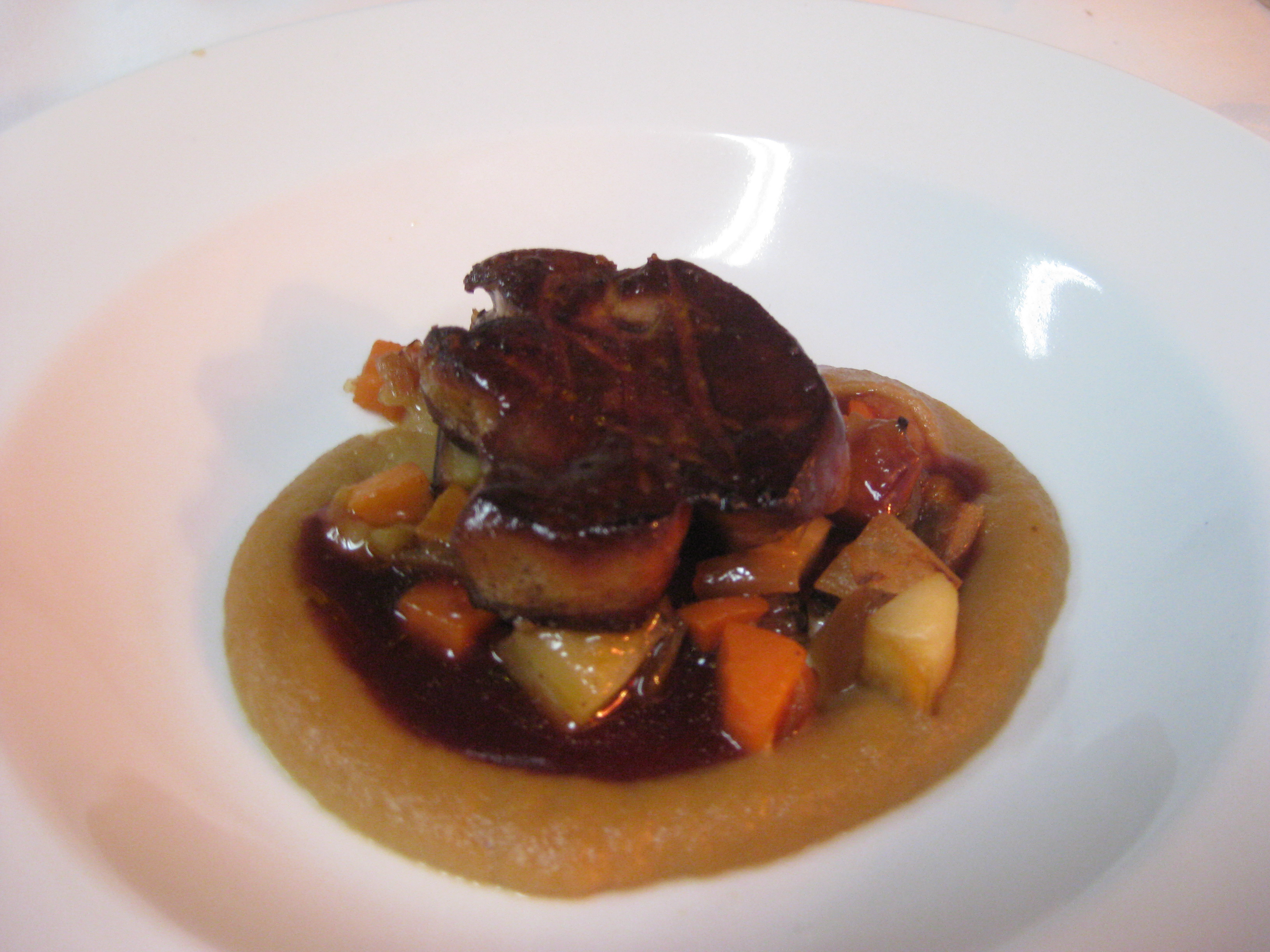 Pan-seared foie gras with elderberry/flower sauce, topinambour soubiseDuck is a winter tradition of ours, and it’s that time again. No matter that I inhaled my share of duck fumes, cooking up an insane amount of duck during the holiday season, I have a few more weeks yet of bathing in duck fat with our duck themed dinners running at the table champêtre.. Duck menu at Les Jardins Sauvages
Pan-seared foie gras with elderberry/flower sauce, topinambour soubiseDuck is a winter tradition of ours, and it’s that time again. No matter that I inhaled my share of duck fumes, cooking up an insane amount of duck during the holiday season, I have a few more weeks yet of bathing in duck fat with our duck themed dinners running at the table champêtre.. Duck menu at Les Jardins Sauvages
But really, I don’t mind; duck is hard to tire of. It is hands down the best meat, so flavourful and versatile in its many forms, not to mention local, healthy and relatively easy to cook. Susan Semenak makes a case for duck (with my help) in this Montreal Gazette article..
Every year, I change up the seven course menu, playing with four breeds and all their parts, the eggs, the skin, broth etc.. And the marvellous fat of course.. Duck fat is my all-purpose cooking fat in winter, rendered from the carcasses and skin. I like to smoke it too, to have a block ready on hand for introducing that ‘bacon’ taste when you don't want the pigginess.
For sure, there are standards that come back every year or two but always treated differently. For instance duck confit has to be present, but it might be as rillettes, in a salad, in cassoulet or choucroute, say.. Charcuterie (duck proscuito, smoked duck, jerky, sausage) as well as Foie gras, hot and cold are always featured, but with various seasonings and accompaniments.
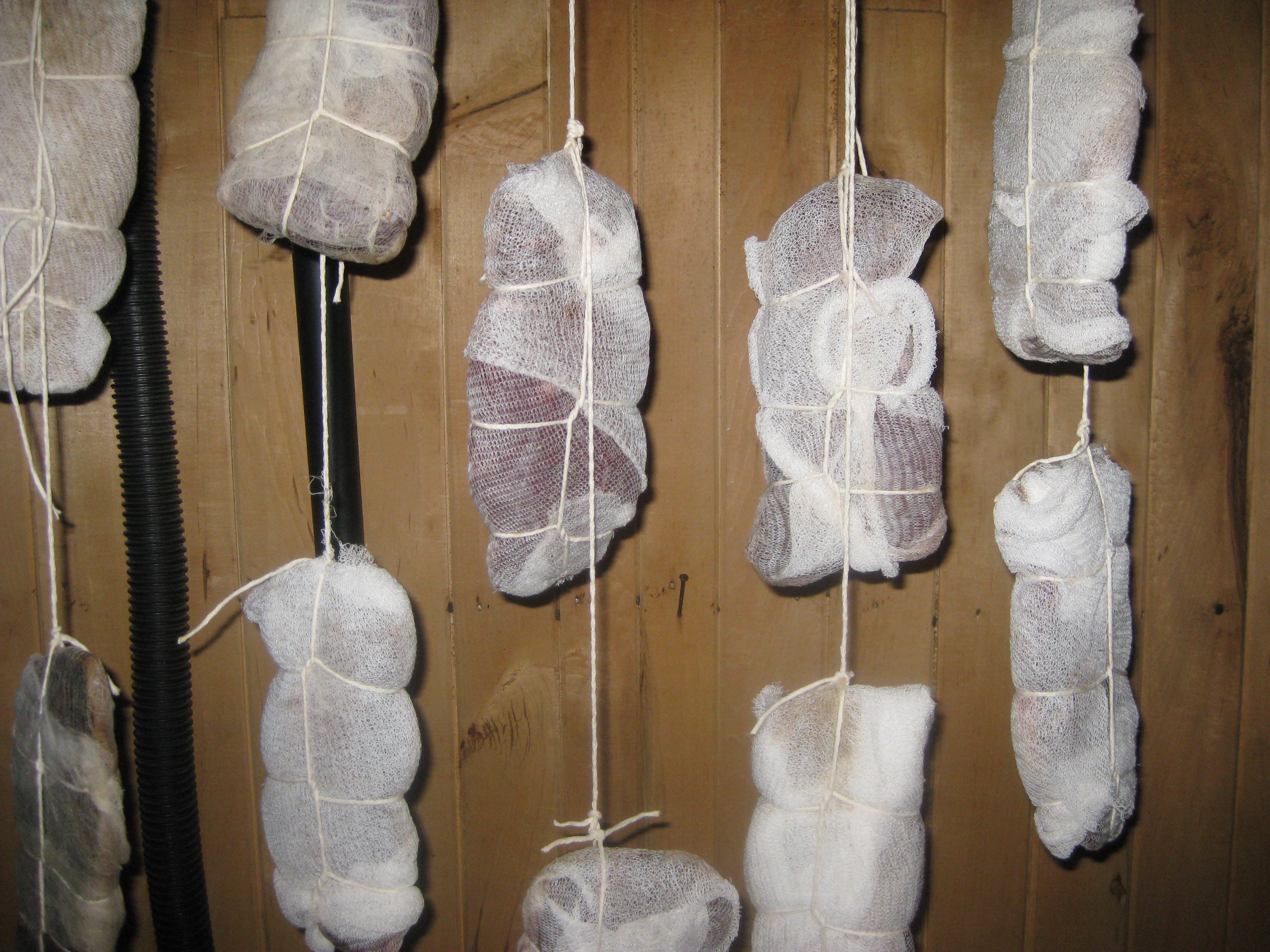 duck proscuito
duck proscuito
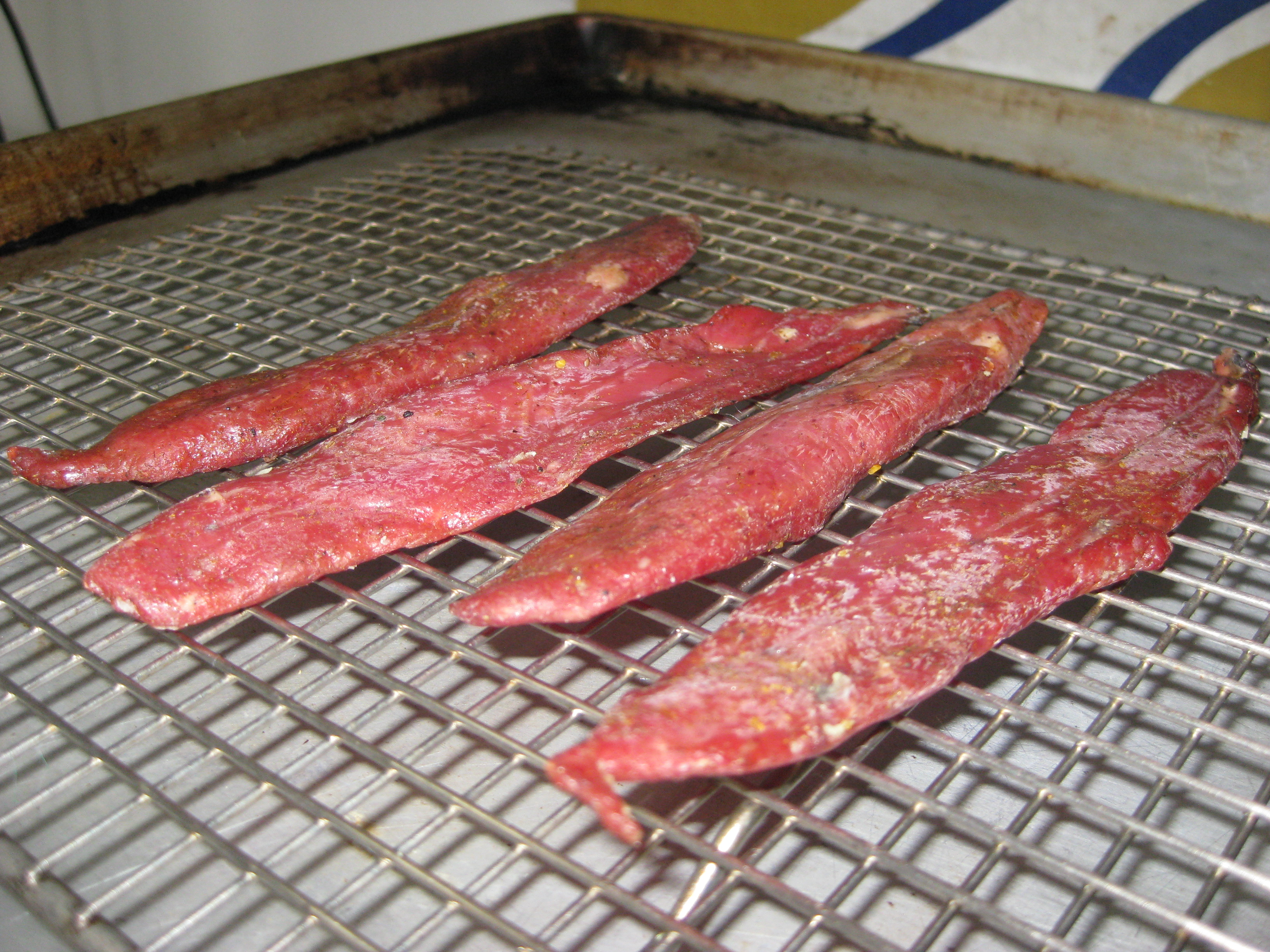 duck jerky
duck jerky
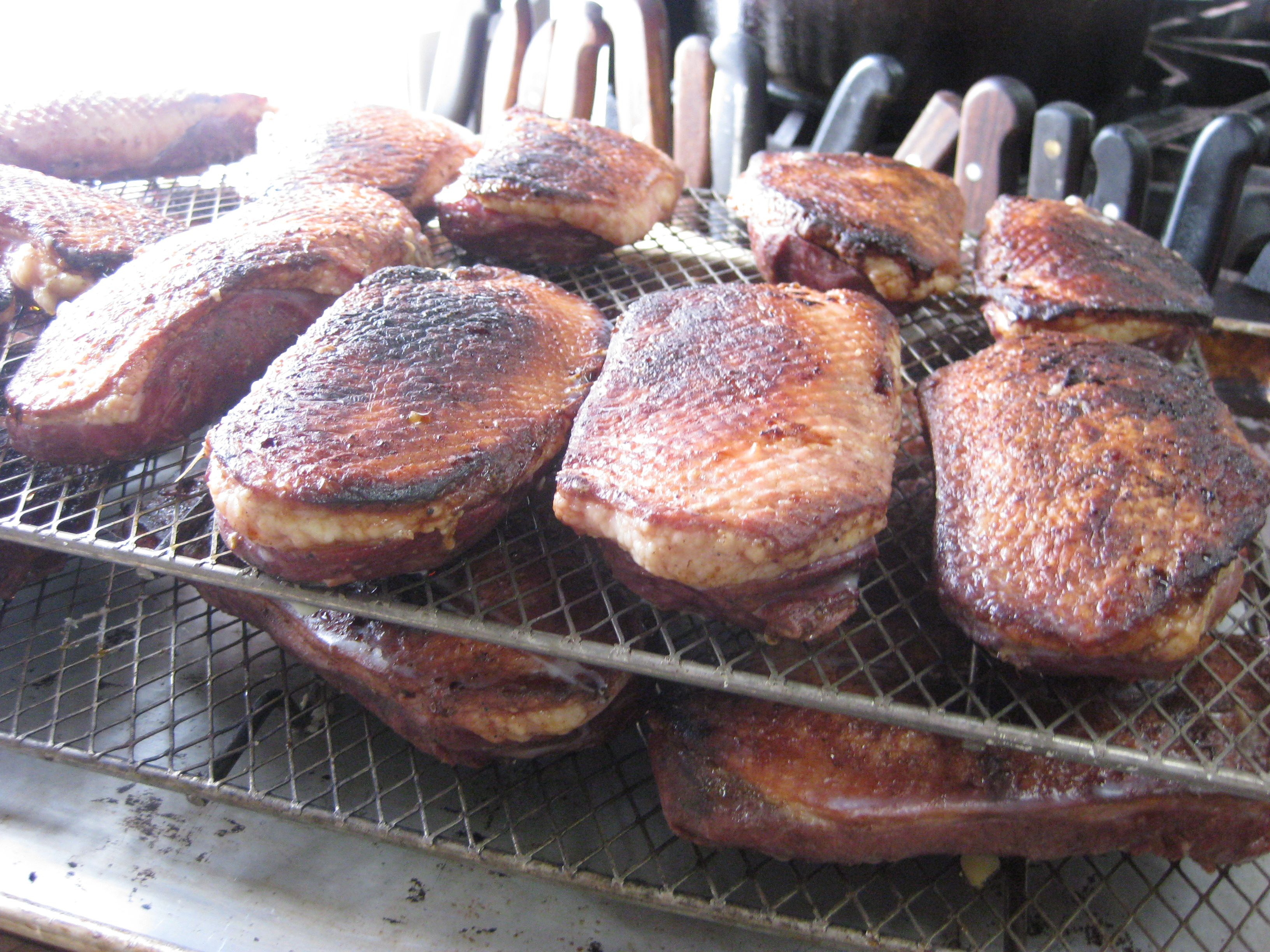 smoked duck my way, cooked not raw
smoked duck my way, cooked not raw
Soup wise, I can’t help but feel the need to go with a consommé, which is pure essence of duck. Duck broth is my base of choice (instead of chicken) year round and makes a great creamy soup or vegetable purée type as well, but I just love consommé; the extra steps are worth it. I clarify the duck stock with more duck (ground) and duck egg whites(keeping the yolks for the garnish or dessert, adding aromates of choice to the clarification raft. This time around it will be surprise, surprise – wild mushrooms!
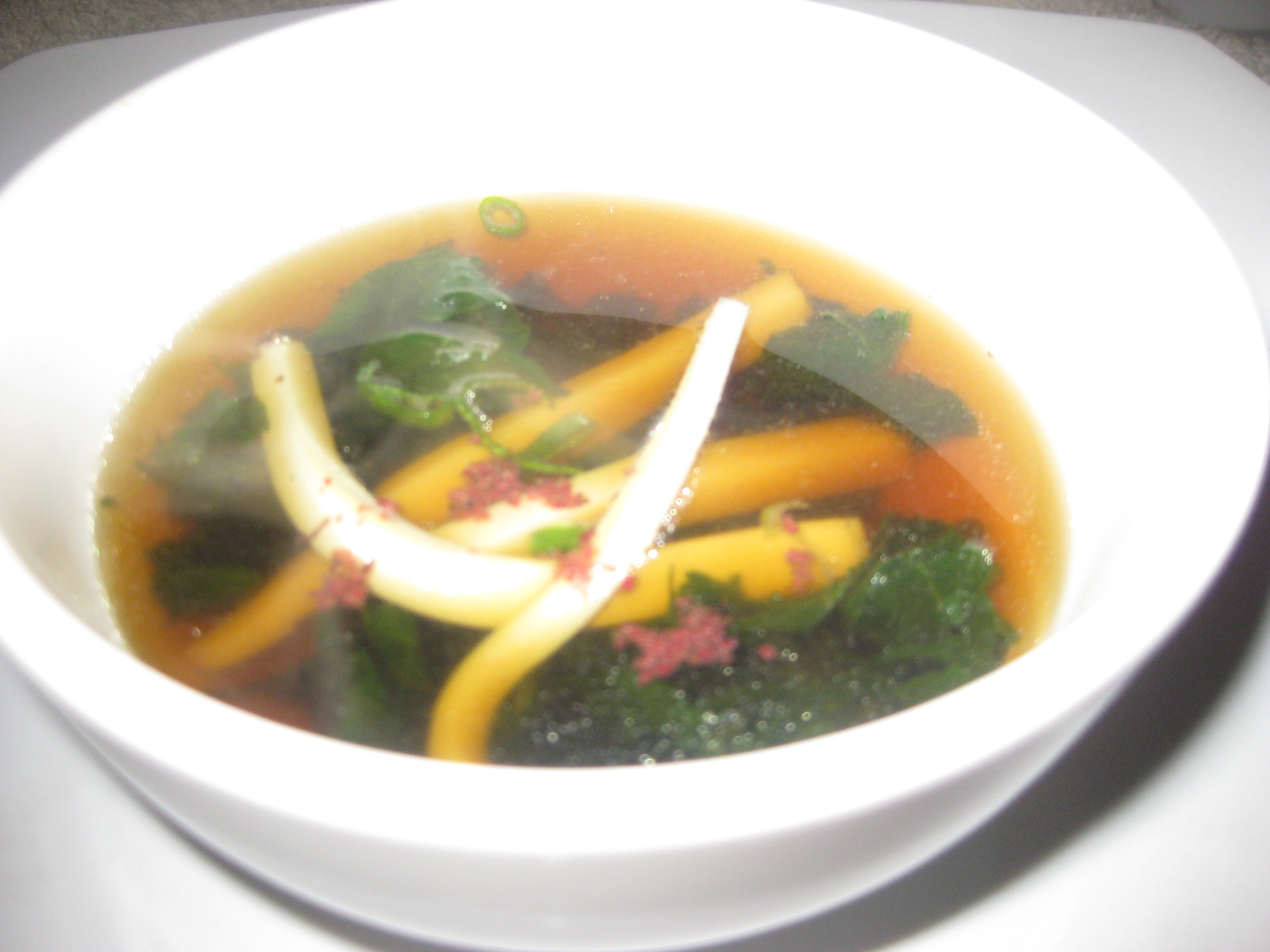 duck consommé with duck egg and sea spinach, sumac
duck consommé with duck egg and sea spinach, sumac
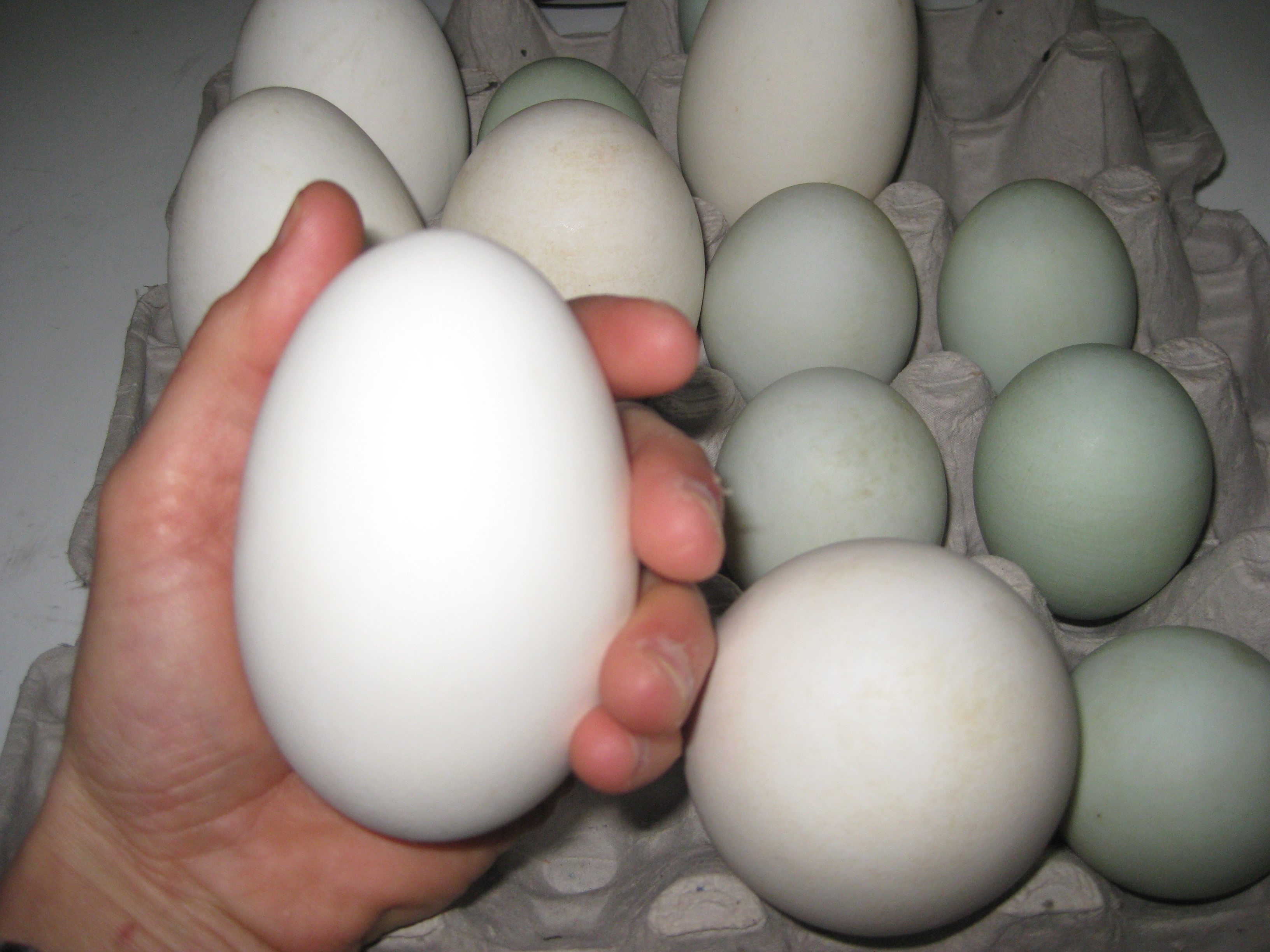 duck eggs
duck eggs
I used to put a whole duck egg on the menu as a second or third entrée - shirred, baked or poached - so delicious and appreciated by most customers but it is a bit much at 80-100g, like 2 chicken eggs.. In the last few years, I have favoured using egg as a component, going with a frittata, tortilla, egg crepe or an egg garnish.. This way the poor customer has a better chance of making it to the end. This year’s egg ‘noodle’ originated from a kind of accident turned experiment. One day, I had an excess of egg yolks so froze them and saw that they turned opaque, almost half cooked. Intrigued by this egg paste, I incorporated some fat and flavour (easily emulsified) and cooked up the cake sousvide/in a bain marie and loved the silky terrine results. A myriad of possibilities opened up: carpaccio, sheets, terrine, skin, slivers, and noodles!
Obviously, there has to be a ducky salad of some kind on any night, as close to a signature I get in my relentless motion. A classic at the restaurant anytime of year is the duck heart and gizzard salad, but it was time to give it a rest. François loves Caesar. If the rest of the menu isn’t too heavy, I can swing it, replacing bacon with my house smoked duck, using some of the duck yolks from before in the dressing, kick it up with crinkleroot and cook the croutons in duck fat.. switch up the capers for pickled daisy buds.

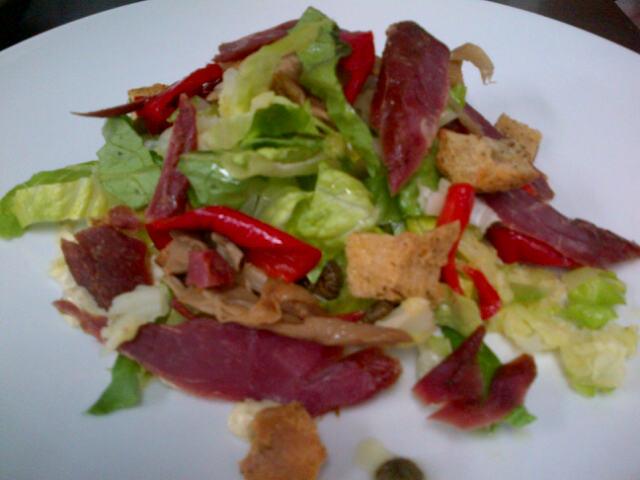
I’m done with cassoulet for a while, but now choucroute is my coup de Coeur of ducky winter dishes, including the incontournable confit and homemade duck sausage. Besides, I love cabbage and I’m into fermentation ever since my killer green beans from two summers ago.. As with proscuito, fermenting things is more conveniently a winter project when the room temp is easier to control and I have time to be patient and play around.. I haven’t had much success yet with cabbage, but I’ll get there..
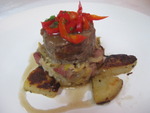 mini choucroute: confit, saucisse maison de canard, choux & genièvre
mini choucroute: confit, saucisse maison de canard, choux & genièvre
I felt like doing a fried chicken type of entrée for a change, or maybe something like ‘General Tao’ -any thing fried being a crowd pleaser. I’m constantly looking for novel ways beyond jerky to put the filets that I remove from the breast.to good use. And since duck is such a natural with ‘asian’ flavourings like soy, ginger, anise etc, there needs to be at least one course that goes in that direction. The duck fingers with wild ginger sauce below (or nuggets as Melinda coined them) was the result – and a staff favourite so far..
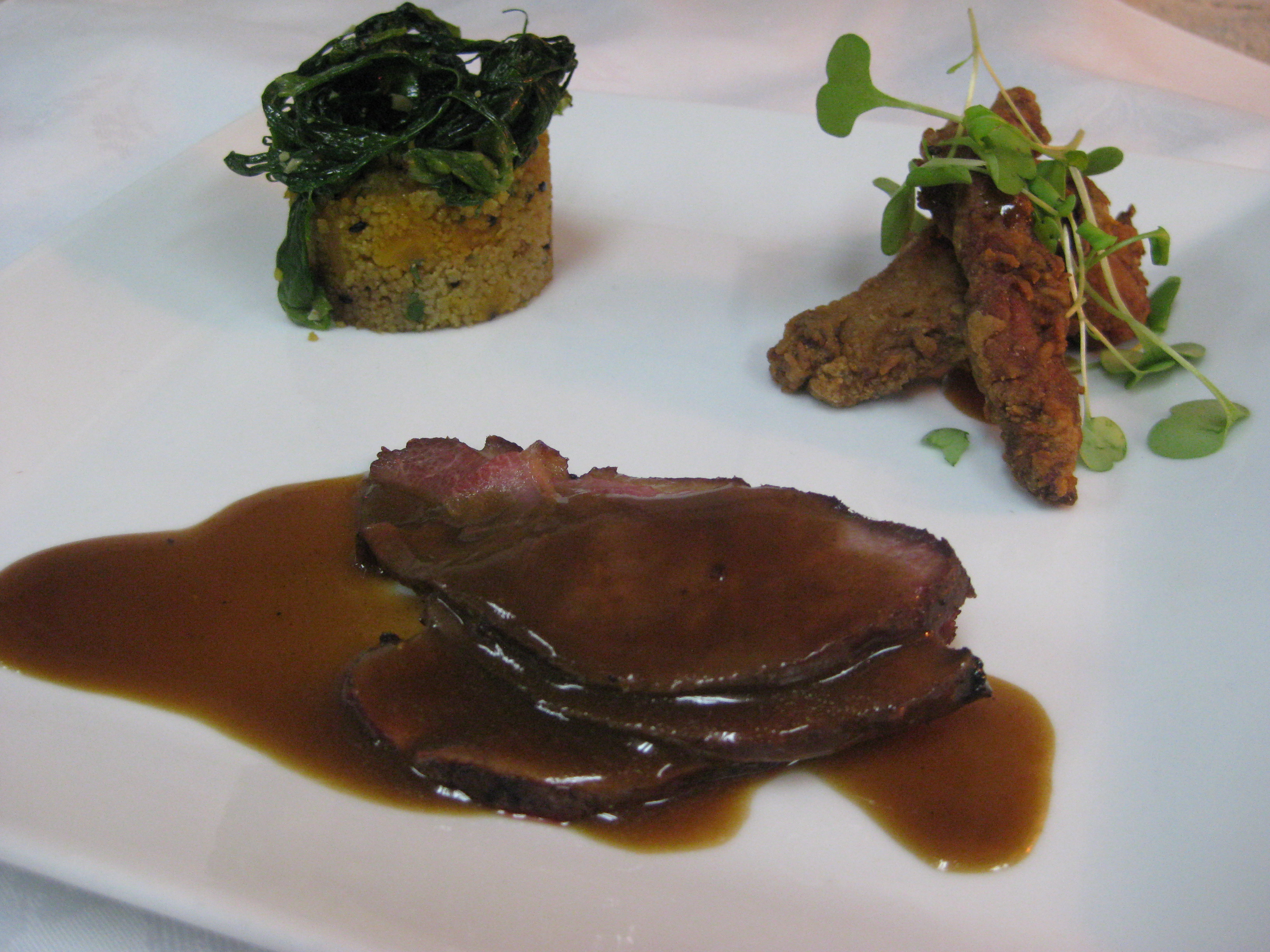 Muscovy duck supreme and fried duck fingers with wild ginger sauce, salsfis sprouts and sesame couscous
Muscovy duck supreme and fried duck fingers with wild ginger sauce, salsfis sprouts and sesame couscous
Besides a Ferme Morgan’s supreme pan-roasted with a fruity-spicy sauce of some sort, definite musts on the menu, too decadent and delicious to pass on, are duck fat potatoes and the cracklings made from the skin. I once served these as an amuse with the aperitif, bad idea! Everyone ate way too many of them. That’s another preferred snack among the waitresses that I have to keep an eye on, ‘Ca goutte le ciel, as Julie says.
To wind down the feast, there are inevitably duck egg desserts; one using the luxurious yolks, the other riffing on the springy whites. Watch out, these protein-rich whites make a surprisingly airy meringue!
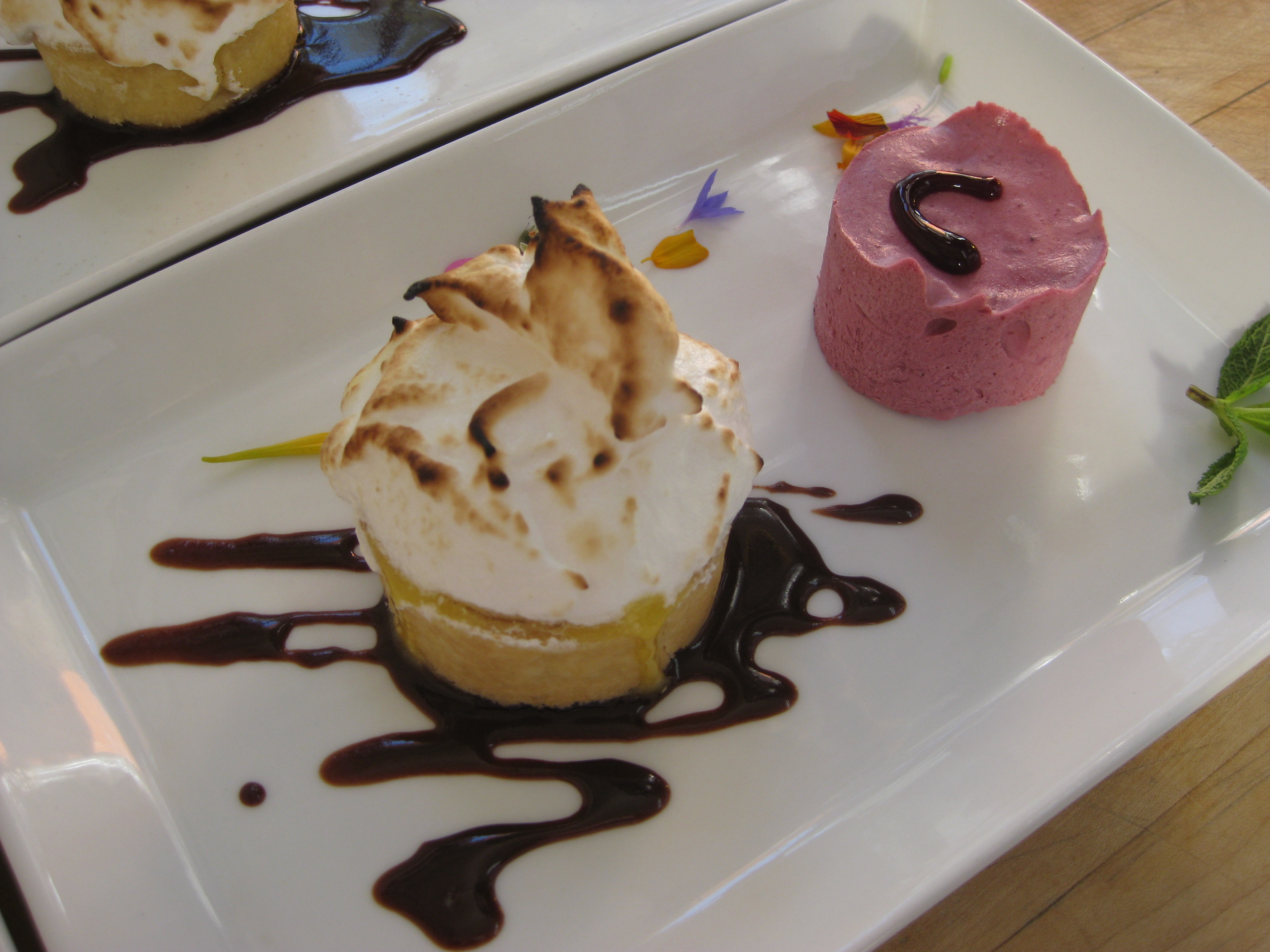
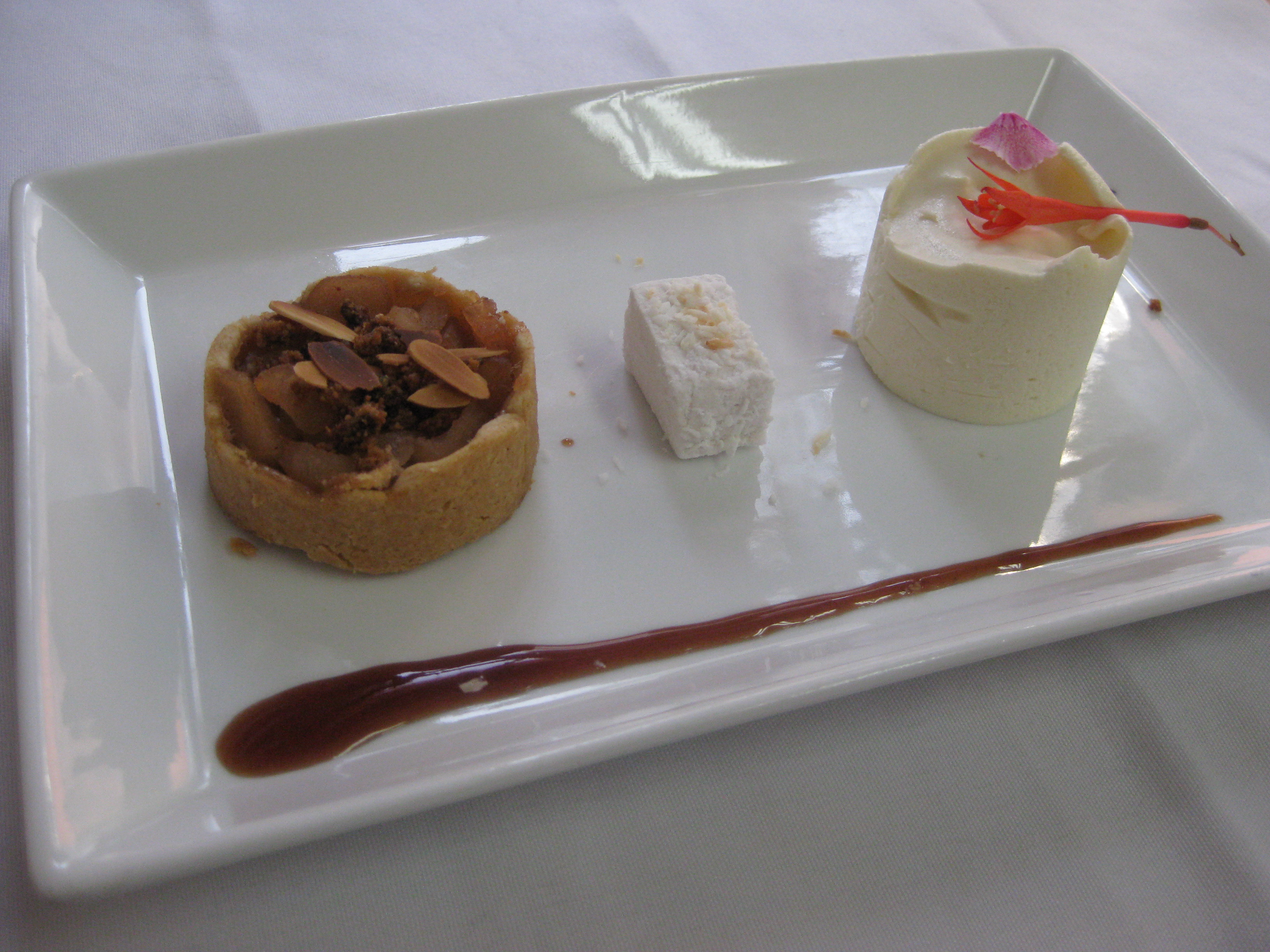
As you can see, the possibilities with duck are endless. And with this cold weather, duck is just what the doctor ordered.
Here are some easy recipes (below) in case you are inspired to cook up some of this local-heart healthy meat over the winter.
Now that many duck products are quite widely available – duck stock, duck fat, confit duck, smoked duck etc.., there is no need for you to get into tricky stuff like charcuterie, making consommé, rendering fat even how to confit duck legs or making stock to enjoy a gourmet meal. It’s ok if you leave that time-consuming, messy stuff to us - the producers, chefs and butchers, the duck store (Le Canard Libéré on St-Laurent)..
Of course, you can always go all out and treat yourself to the ultimate ‘duck’ experience at Les Jardins Sauvages! Until February 3rd..
Duck recipes
Duck confit salad with ‘chimichurri’
6 p
Ingredients
3L wild/mixed greens (or romaine, watercress, endive)
400g cooked confit duck gizzards and hearts (or confit duck leg meat)
100g smoked duck magret, julienne
300g (1) potato (cubes)
250ml duck fat
120ml vinaigrette ‘chimichurri’ sauvage (spicy garlic and wild herb vinaigrette)*
100ml pickled mushrooms
2 scallions, chopped
au goût mushroom salt (or sea salt) & pepper
Method :
Heat duck fat in sturdy pot and add potato; cook gently on stovetop or in oven for 30min. Drain, season and finish in oven on baking sheet to crisp up.
Prepare greens (wash and dry, tear or chop).
Reheat the gizzards in some duck fat gently, or if in a vacuum pack, by submerging it in hot water 5min.
Toss the greens with scallions and half the vinaigrette, adding more vinaigrette and seasoning to taste.
Serve warm gizzards and potatoes on top. Garnish with smoked duck and pickled mushrooms.
*A garlicky red wine vinaigrette I make (and we sell) with wild garlic, chilli and a bunch of wild herbs (sea parsley, lovage, crinkleroot, garlic mustard leaf, bee balm..); could be replaced with any punchy vinaigrette that is sharp and slightly sweet with added herbs and garlic.
Duck Caesar salad with crinkleroot
6 p
Ingredients
3L wild/mixed greens (romaine, endive, watercress)
100g smoked duck magret, julienne
2c day old bread (cubes)
60ml duck fat
wild herb salt (or sea salt)
chopped herbs of choice
100g Capra or aged cheese of choice (that grates well)
2 scallions, chopped
20ml pickled daisy buds or capers
Crinkleroot Caesar dressing:
2tsp each minced garlic and crinkleroot
50ml minced anchovy (3-4)
3 egg yolks
1tsp crinkleroot mustard or Dijon
30ml white wine vinegar/lemon juice
30ml pickled daisy buds
60ml grapeseed oil
60ml EVO
salt, pepper
Tabasco, Worchestershire
Extra lemon to taste
Make croutons by tossing bread in rendered duck fat, season with salt and dried herbs, cook in oven at 350F for 15-20min or until golden and crunchy.
Make vinaigrette by mixing ingredients in a blender. Or combine yolks, garlic and mustard, half of lemon juice and slowly whisk in grapeseed oil. Add rest of lemon juice and continue with olive oil. Thin with a touch of oil or water to desired consistency. Season to taste.
Toss greens with half of vinaigrette, some of the cheese, s&p; adding more vinaigrette to taste. Plate salad and top with smoked duck, croutons and remaining cheese. Sprinkle extra daisy buds around.
Pan-seared duck supreme with elderberry/flower sauce
6 p
Ingredients
2 (1kg) duck supremes, skin side scored; filets kept for another use (Terrine, Jerky or Fried duck)
2 shallots, thinly sliced
thyme, peppercorn
20g butter
100ml honeywine or cider
500ml duck stock
250ml elderberries (or fruit/berry of choice, fresh or frozen)
10g (2Tbsp) elderflower (or peppercorn, juniper or rosemary)
s&p
cornstarch slurry
* In a sauce for duck, I like to combine something fruity and something spicy/herbal added later; instead of elderberry/flower combo, could be apple (1c chopped whole) and rosemary 2-3 sprigs, blackberry and juniper or raspberry and peppercorn...
Method:
Make sauce base: In a medium sauce pot, slowly caramelise shallots in a bit of butter/oil, add thyme and peppercorn and deglaze with wine, reduce down. Add duck stock and elderberries (or berry of choice). Simmer for at least 20min, allowing to reduce slowly. Add elderflower (or rosemary/juniper/herbs of choice) and let sit 5min. Strain.
Trim excess fat of duck supremes if necessary. With Muscovy, it isn’t necessary, but with Moulard or Pekin sometimes; you don’t want more than ½-1 cm/1/4”. So that there is some crispy but not too much flabby fat at end. Scoring with a knife helps the fat render/even cooking.
Heat sauté pan to med-high heat. Season duck supremes and add to pan skin side down (with no added fat). Once you start to see color, turn down to med or lower and cook for 8-10min. You want a slow caramelisation while rendering as much excess fat as possible. Pour off rendered fat a few times during the cooking. Flip and cook for 2-3min. Ideal is medium-rare. Rest in a warm place for 10min before slicing.
Degrease pan and pour in sauce base. Bring to a simmer season to taste, thicken to desired consistency with cornstarch slurry if desired (maybe 1Tbsp), swirl in butter.
Slice duck breast as thinly as possible against the grain of the meat, serve with sauce. Suggested accompaniments: Root vegetables, mushrooms, wild rice..
Duck jerky
6 p
Ingredients
8 (450g) duck filets (tenderloin) or one duck breast fat removed, sliced in 6x1.5cm thick strips
20g (1 Tbsp) brown sugar
5g (scant tsp) coarse salt
1g ea (generous pinch) pepper, smoked paprika, steak spice
.5g ea (small pinch) cumin, thyme, oregano
big squirt ea soy sauce/tamari
small squirt worchestershire
Method:
Toss with seasonings. Refrigerate overnight. Pat dry and put in a 200F on a rack in oven for 2hrs or until desired texture (dry and chewy, still sliceable).
Eat as a snack as is or slice up to garnish a salad, sandwich or canapé. Keep in fridge.
Baked duck egg with mushroom, smoked duck and tomato
6 p
Ingredients
6 duck eggs
30ml olive oil
200g wild mushrooms (or cultivated), chopped
2 french shallots, minced
15ml butter
s&p
drops lemon juice or cider vinegar/sherry vinegar
100ml heavy cream
5ml mushroom oil (and/or a few drops of truffle oil)
s&p
60g smoked duck, julienne
200ml chopped tomato
50ml chopped chives and/or parsley
pinch sugar, s&p, hot sauce
Method:
Sauté mushrooms in olive oil over medium-high heat for a couple of minutes; add butter and shallots, turn down to med/low and stew for 10 minutes; season.
Mix cream with mushroom oil (and/or a few drops of truffle oil), season.
Into buttered individual ramekins (4oz), divide mushroom mixture to cover bottom. Crack an egg into each one. Top with a tablespoon or two of cream mixture to cover.
Cook in a 325F oven for 15-20min until just set but still giggly.
Meanwhile prepare tomato salsa garnish. Add a pinch of sugar, salt and pepper to chopped tomato with fresh herbs and a bit of olive oil or mushroom oil, hot sauce to taste.
Serve ramekins of egg topped with salsa and smoked duck julienne.
Fried duck fingers with wild ginger sauce
6 p
Ingredients
12 duck filets
1/2c pastry flour (or half flour and cornstarch)
50ml plain yogurt
Marinade:
50ml soy sauce
50ml maple syrup
30ml lime juice
30ml wild ginger mustard
5ml toasted sesame oil
1tsp ea curry, five spice
hot pepper sauce (Sambal or Siracha)
Sauce:
2 shallots, thinly sliced
1tsp ea minced garlic, wild ginger
2c duck stock
2 sprigs thyme
1Tbsp± cornstarch slurry
30ml butter
Method:
Cut duck filets into 1” thick slivers (in 3).
Mix together marinade ingredients. Use half to season the duck filets, tossing to coat evenly with the yogurt.
Set aside for at least 20 min (or in the fridge hours or overnight).
Make sauce: slowly caramelise shallots in some butter. Add garlic and ginger, sauté a few minutes and add the rest of marinade. Deglaze with stock, reduce down by 1/3. Add thyme and coriander. Keep reducing another 5min to approximately half, tasting along the way. Rectify seasoning, use a little cornstarch slurry to thicken to desired consistency. To finish sauce, strain and swirl in butter off heat. Keep warm.
Pull duck from marinade, pat dry and coat with pastry flour. Fry duck by either deep frying at 350F for 2-3min or by pan-frying in a skillet with a good slick of hot vegetable or peanut oil for 3-4min (1-2 min each side). Remove onto paper towels, and serve with sauce. You can always coat the fried duck in sauce General Tao style but I prefer it separate.
Suggested accompaniments: rice, sautéed mushrooms and mustard greens, or rice noodles, lettuce, red pepper, bean sprouts, coriander and mint.. Could be finger food too!
Late Harvests and Holiday prep
Late Harvests
Yes, it’s getting cold out, but there are still goodies being harvested here!
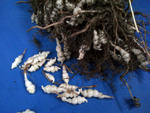 crosneJewel-like little crosnes and knobby jerusalem artichokes, both a bitch to clean, but worth the effort.
crosneJewel-like little crosnes and knobby jerusalem artichokes, both a bitch to clean, but worth the effort.
Still alive in the garden are the hardy herbs like thyme and rosemary, as well as beautiful chard and sorrel that isn’t bitter at all.. My trusty favourite wild daisy greens are always available, and the last of the wild mint must be picked before the river rises too high..
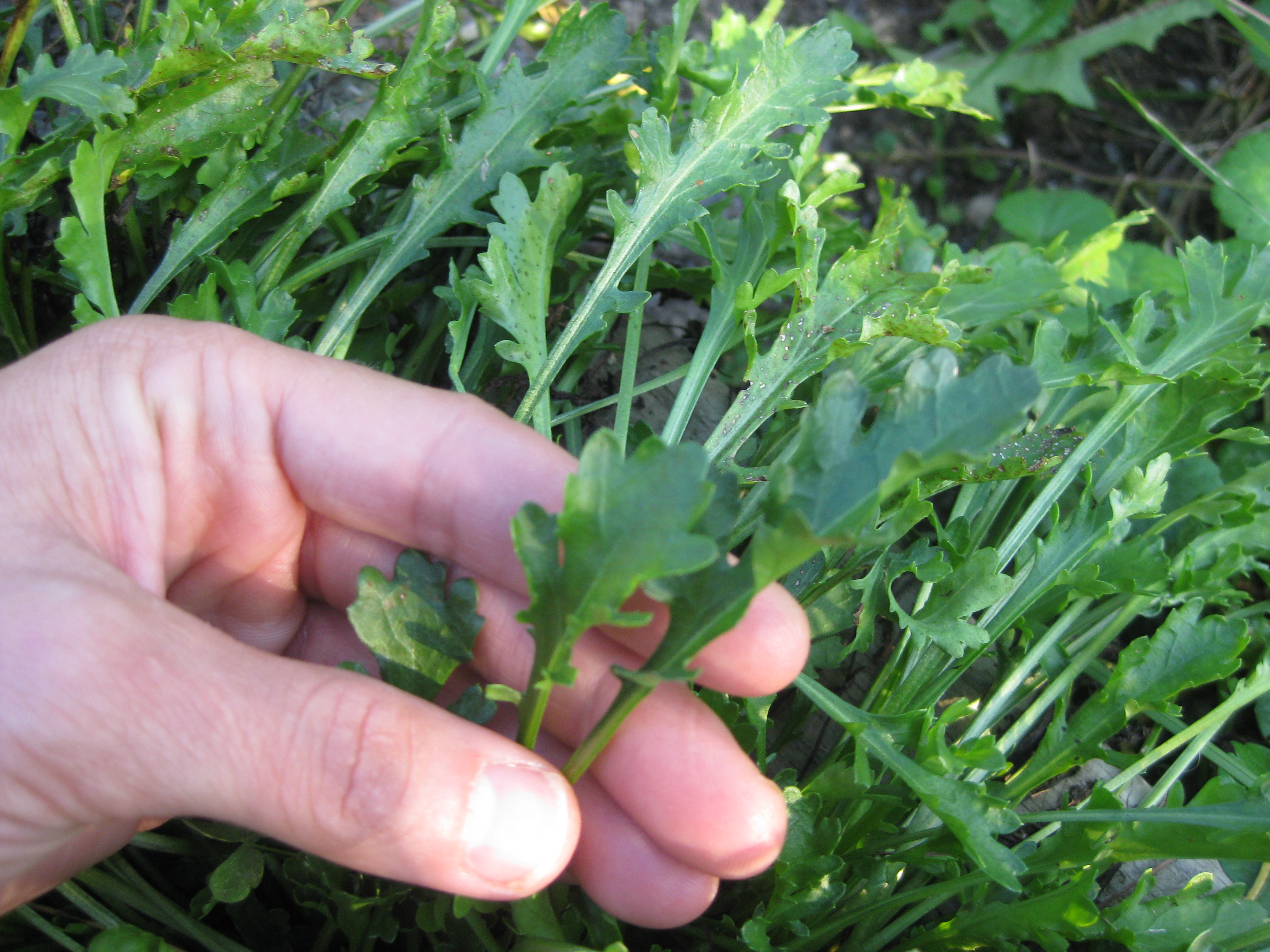 daisy
daisy
From the woods, there is still a trickle of late autumn shrooms from around here, yellowfoot chanterelles from the Gaspesie.. 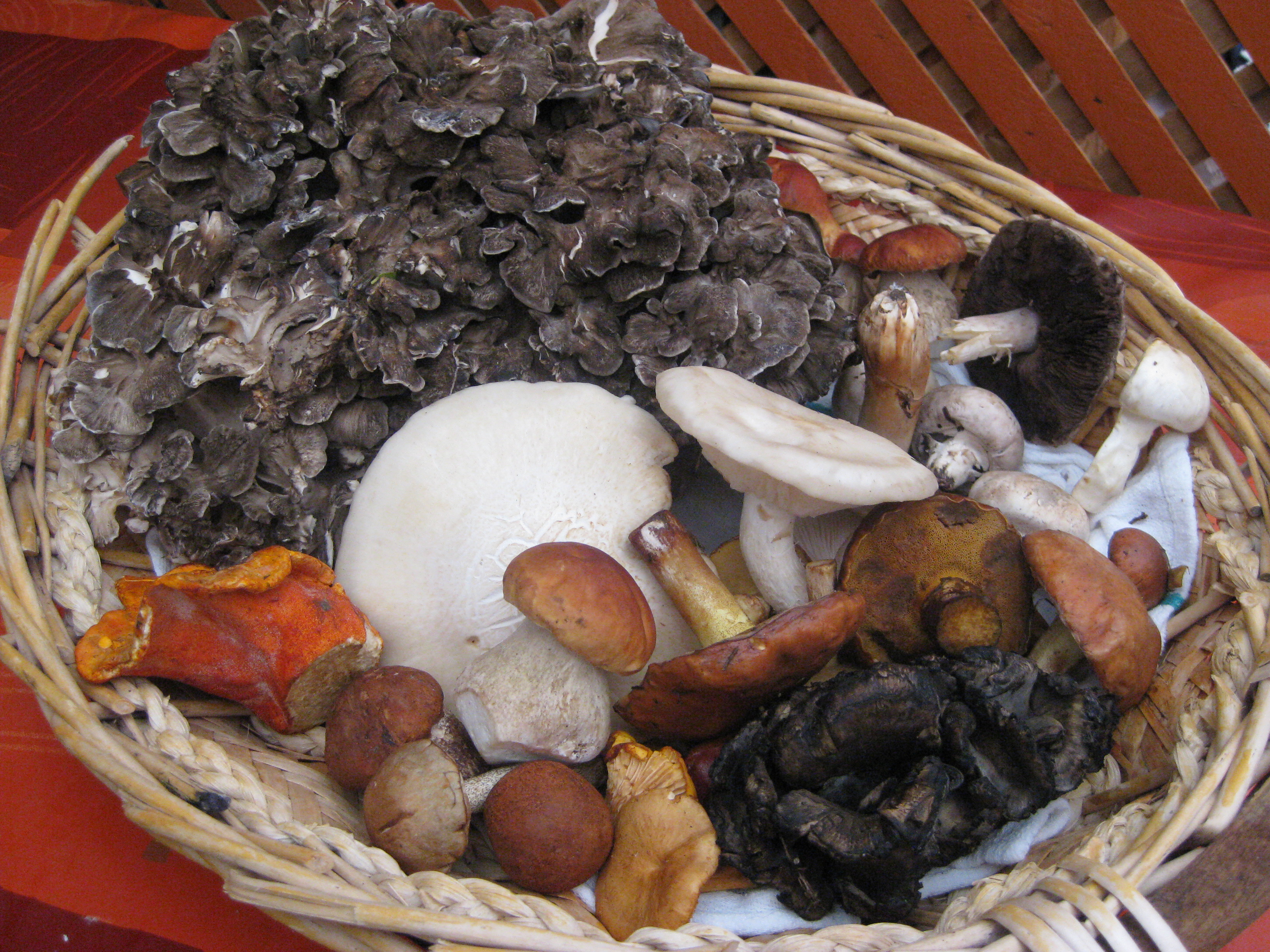
Another big batch of ultra ripe and fragrant juniper berries just picked on the north shore – I’ve never seen juniper berries this good.. They cry out to be treated like a berry-fruit as opposed to a berry-spice.
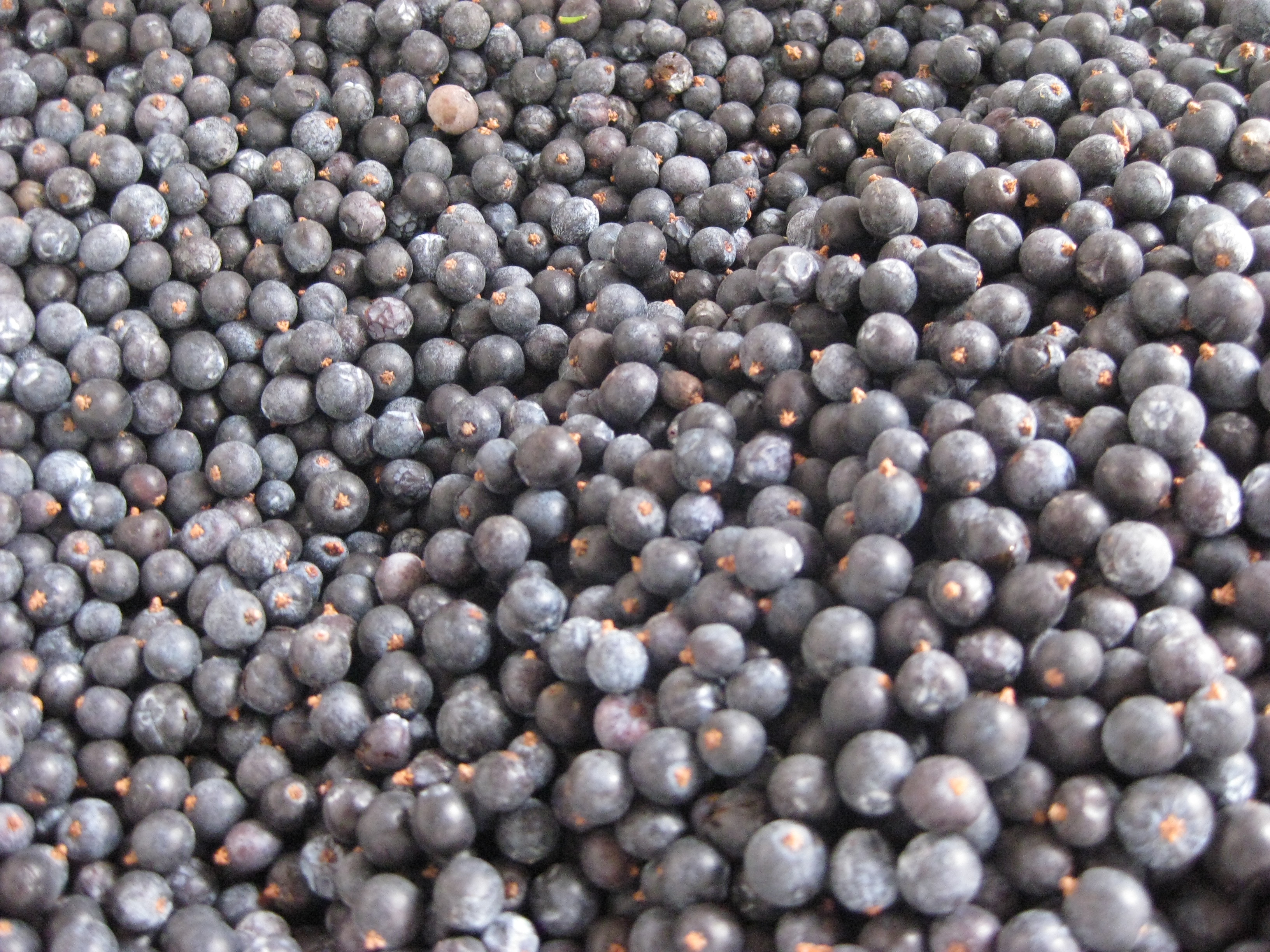 juniper berries
juniper berries
With the growing season coming to an end, and the mushroom festival behind us, now it’s about playing catch up, preparing for the winter and most importantly, tackling my Christmas cooking.
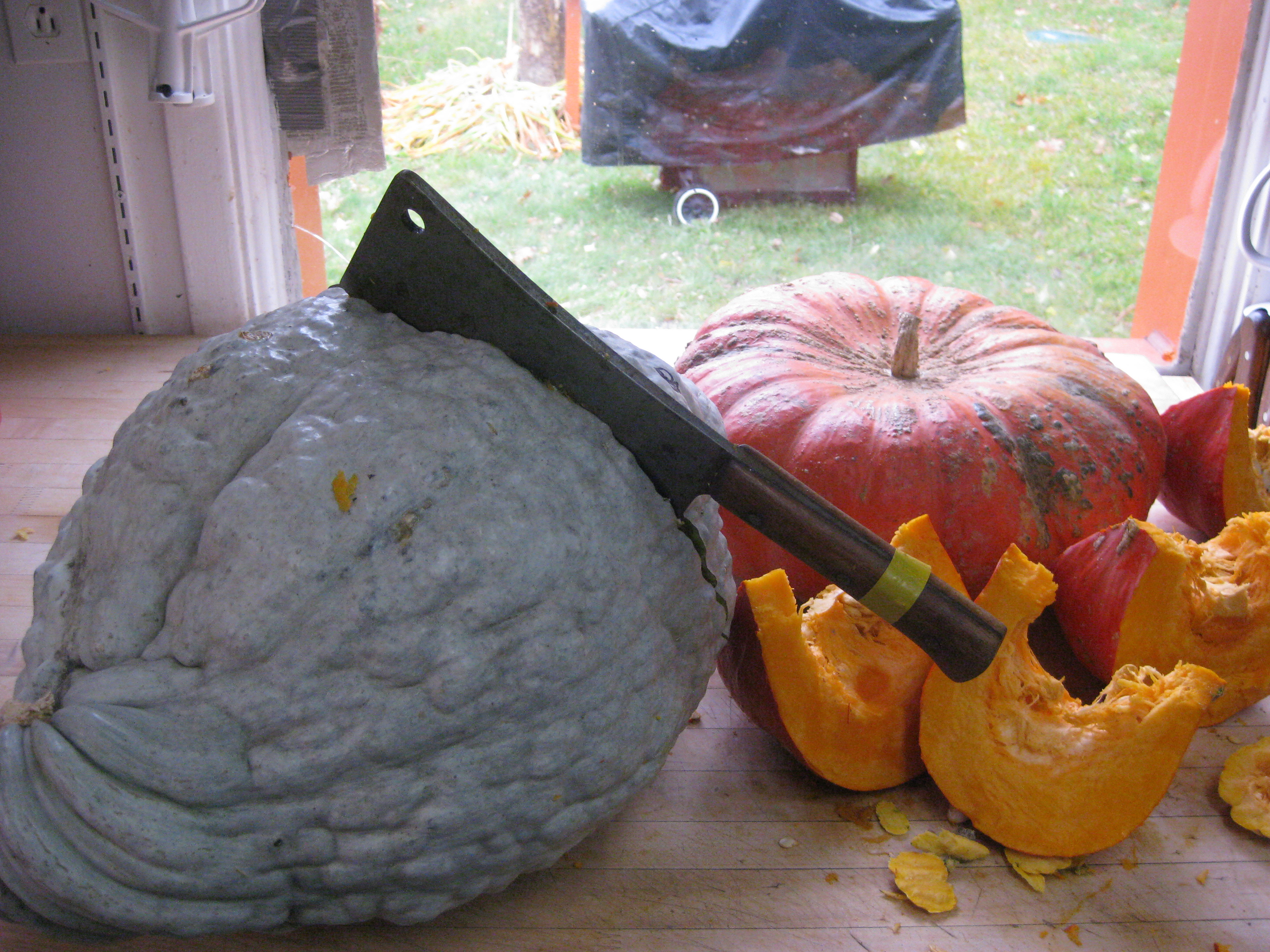 Hubbard and Potiron
Hubbard and Potiron
I need to finish the wild grapes, which get transformed into coulis, concentrate and our ‘balsamic’. I have a beautiful mountain of winter squash that has been patiently waiting to be processed. And then, it’s time to focus on the meat.
Two weeks until the X-mas markets open, which means an increased demand for all my braised dishes, charcuteries, soups and sauces.. As well as all our Christmas specialties like game tourtieres, turkey mushroom pot-pies, cassoulet and mushroom desserts – all with a touch of wild..
As of November, our customers naturally shift from the fresh produce to what’s put up, comforting and ready to eat. We sell a lot of soup and stew. Then in December, it’s fancy but homey festive food to share and gift bags that people want. Oh, and ketchup!

For one month a year, my kitchen turns into a production kitchen for stuffed birds, pies, cassoulet, foie gras, terrines and the like.. I pull out my sarriette (savoury), which I only seem to use at this time of year. My soup pot is on a constant simmer, aromas of duck fat and quatre épices in the air, Christmas music in the background.. Now, all that is missing is the snow on the ground and I’ll really be in the mood.
Holiday cooking is fun stuff, but like everything we seem to do, labour intensive. For the tourtiere for instance, I need to first make the duck confit (which takes several days), breakdown and clean the venison then braise it, grind the other meat, make and roll the dough – it’s a week long process altogether. Same for the cassoulet which also relies on confit and some serious pig work before starting (ie. breakdown pig, brine and smoke ham, braise shoulder, make sausage and bacon).. Time to get to work.
Chop, chop!
Moving on from Mac: my new Kikuichi
I just finished my first week end with my new partner, he's pretty cool. Actually, he’s definitely more of a she. I have yet to see whether this Kikuichi will replace my beloved Mac whom I miss terribly. He just disappeared one day, I don’t understand. I waited a month before looking for a replacement; now, I’m ready to move on.
 She feels good in my hand and is sharp as all get out, but is perhaps a touch delicate for a brute like me. She seems less versatile too, more of a slicer than a chopper. I’m not sure she's cut out to be my number one. You see, I am not the sort of gadget girl who is reaching into my knife kit everytime I change tasks; I like a knife that I don’t have to put down much, that isn’t too fussy, that I can use for almost everything, that feels natural like an extension of my arm. So understandably, I take this relationship seriously, get pretty attached to my right hand man (or whatever), my partner in life.
She feels good in my hand and is sharp as all get out, but is perhaps a touch delicate for a brute like me. She seems less versatile too, more of a slicer than a chopper. I’m not sure she's cut out to be my number one. You see, I am not the sort of gadget girl who is reaching into my knife kit everytime I change tasks; I like a knife that I don’t have to put down much, that isn’t too fussy, that I can use for almost everything, that feels natural like an extension of my arm. So understandably, I take this relationship seriously, get pretty attached to my right hand man (or whatever), my partner in life.
We'll give it a go with the Kikuichi, but she'll probably need help eventually and I'll have to go back to the boys. Not necessarily European, but I’m always looking for the perfect mix, kind of like Mac. I love so many Japanese blades, but they all have unwieldy long handles I don't dig, not to mention that they are often not tough enough, high maintenance, too girly.
Summer to Fall, Mother Nature and Mushrooms
Although there is no doubt that we’re still riding peak season at Les Jardins Sauvages, I guess it’s time to admit that the 'summer of summers' is now officially over..
 now, less of this
now, less of this 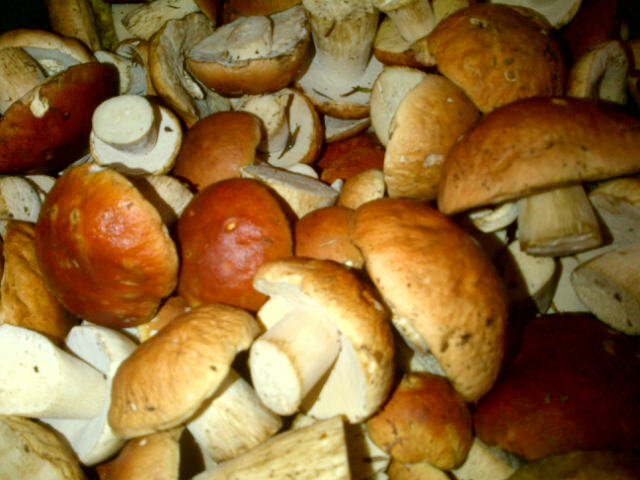 And more of this: cleaning & cooking mushrooms
And more of this: cleaning & cooking mushrooms
The season change notably creeps in before we’re ready, and the calendar date passes while we’re still in summer mode. It only feels real a week or two later.. When my soups get heartier and a hot app naturally replaces a salad on my menu. When bread making becomes more manageable and my chef jacket is a welcome layer on top of my camisole. When fresh wild flowers become hard to find for the table tops.. When there is more brown than green hitting my pantry. When my favourite spot outside the kitchen moves from the river (or terrasse) to next to fireside. Yup, time to shift modes, bundle up and focus on the mushrooms, maybe chop some wood.
 less of this: salad with wild greens and flower petals
less of this: salad with wild greens and flower petals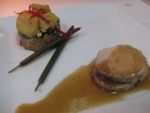 more of this: Piglet two ways, wilted wild greens and mushroom jus I do adore the seasons. I’m nonetheless always sorry to see one close, simultaneously feeling excited about the next one moving in, with all its novel spendour and contrasts, familiar comforts and certain surprises in store.
more of this: Piglet two ways, wilted wild greens and mushroom jus I do adore the seasons. I’m nonetheless always sorry to see one close, simultaneously feeling excited about the next one moving in, with all its novel spendour and contrasts, familiar comforts and certain surprises in store.
Looking back, summer 2012 was indeed beautiful, but! For sure, the lamest for wild edibles I’ve seen since I embarked on this adventure with François. No problem if you have all day/week and are foraging for your family dinner alone.. It was a struggle for anything green, not much better for the tasty toadstools. Only the tomatoes and peaches seemed to flourish. The non-wild revelation of the summer: these micro tomatoes François planted in our garden! (one of the original heirloom varieties from Mexico)
Thankfully, in certain regions like the Gaspesie and further north, there was enough rain and alternate sunny weather for decent wild harvests. It's a good thing that François has built a network of pickers across the province over the years, people he met on his travels and trained, or others - knowledgable kindred spirits he formed a partnership with.. To think back to the day when he had to be everywhere or miss out, living out of his truck and tent, picking everything himself!
In his primary foraging/family territory - the Outaouis and here in the Lanaudière, the blackberries dried before ripening, blueberries, and raspberries the same; the mushrooms were sparse. This was definitely not a chanterelle year, for instance. Normally, I cross the bridge and see mushrooms everywhere, not this year. We had to hunt far and wide. And when found, they were often piqué (worm infested) before anyone could get to them in numbers. The BC and foreign suppliers certainly did well on the Quebec market this year. Those seeking out local mushrooms were all over François and his team at Marché Jean Talon; we couldn’t keep up. Which also means I hardly got my fair share of summer varieties at the resto/workshop.
 airelles de marécage/airelles (cote nord)
airelles de marécage/airelles (cote nord)
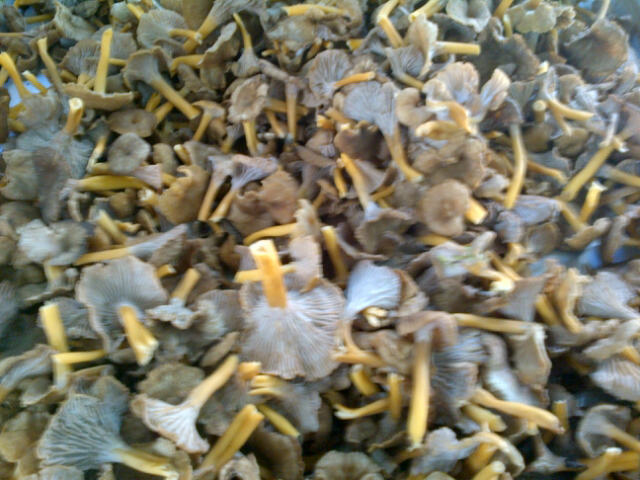 chanterelles en tubes/yellowfoot chanterelle beauties
chanterelles en tubes/yellowfoot chanterelle beauties  polypore soufré/chicken mushroom
polypore soufré/chicken mushroom
So, a thousand pounds in maybe, not counting what François sold at market. Last year, I had processed over a ton by now, 2 tons by Oct - be it cleaned and dehydrated, with a first cooking and sous-vide, or pickled, put up somehow. I’ve had an easy summer, hence the tan. Only working 50-60hr weeks on average, mother nature didn’t make as many of her extraordinary demands with regular relentless abundance in short spurts, less cross over. I got to deal with a couple of weeds/berries/greens at a time, usually keeping up despite my meagre staffing. We nailed all our basics from the pickled buds, cattails in all forms, sea parsely pesto and sousvide sea spinach, all the flowers/greens for the tisane and sirops, just enough berries for my jams/coulis/vinaigrettes etc. I managed to do quite a bit of preserves with the cultivated stuff too (peas, corn, tomatoes in many forms - ketchup, hot sauce, ratatouille..)
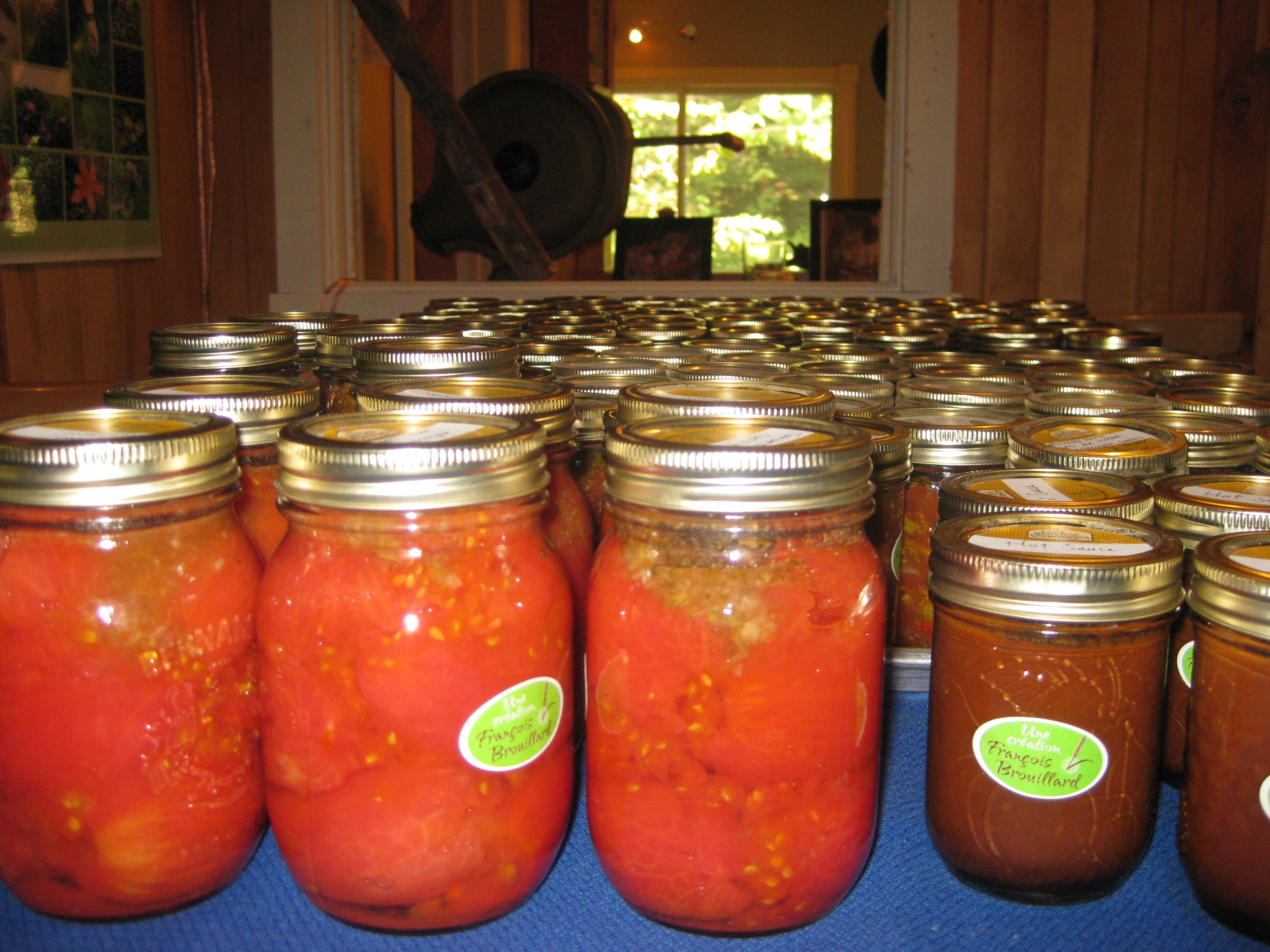
Not quite the mushroom nirvana I’ve grown accustomed to thanks to my forager of foragers, I couldn’t help but spend the last leg of the summer worrying.. Would I have enough for our monster mushroom festival and for all our products year-round? A constant juggling game, I would certainly have to regroup and make do with what I have, reconfigure our products, ditch label inventory $$, oh the joys of the wild life in business..
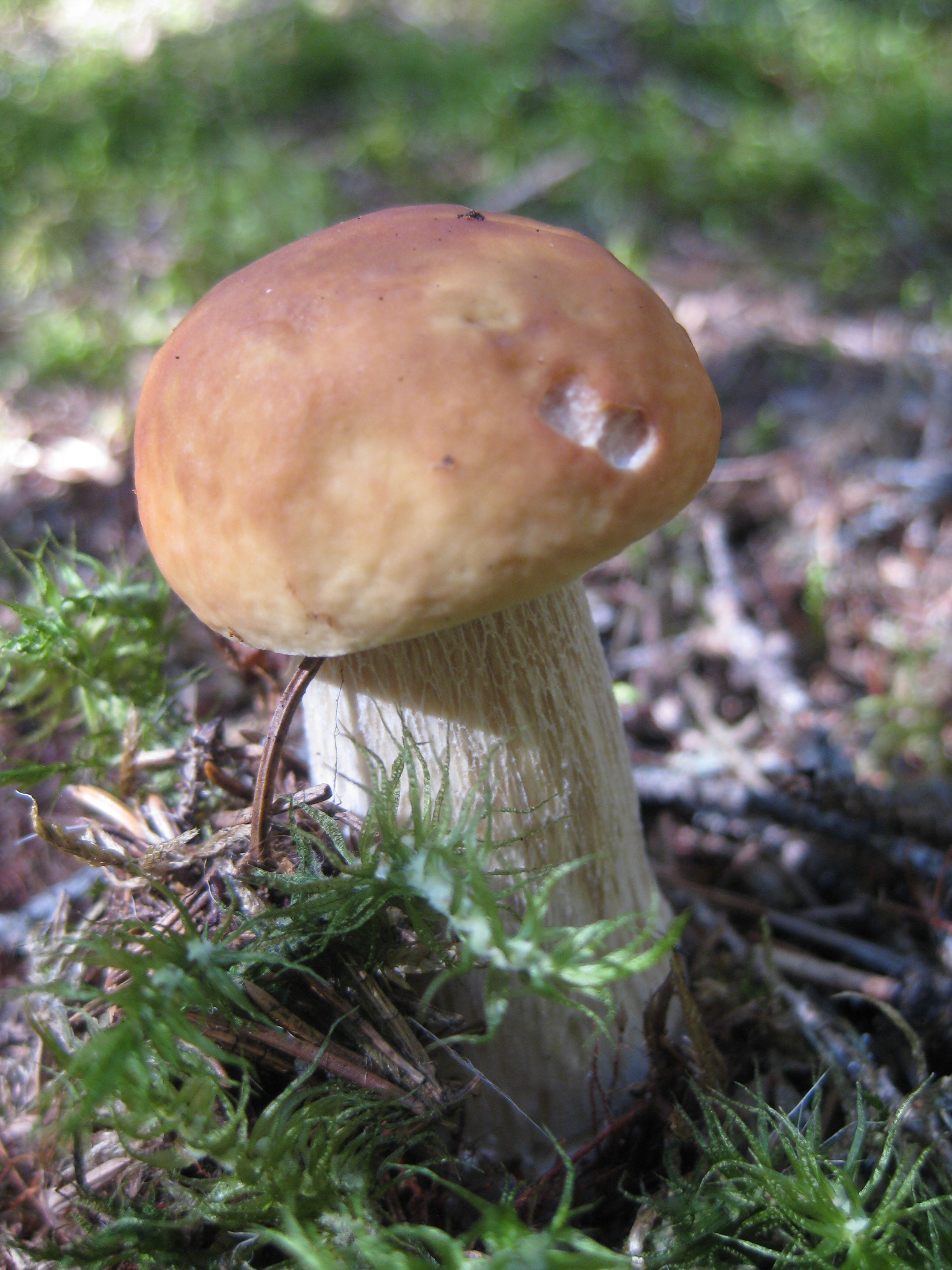 cepe
cepe 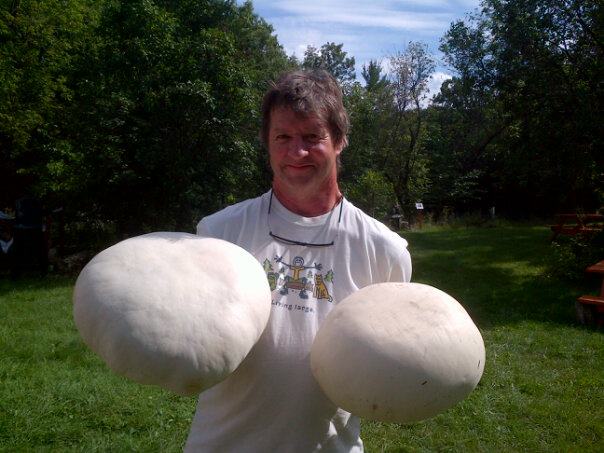
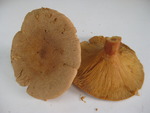 Lactaire à l'odeur d'érable/Maple scented lactarius
Lactaire à l'odeur d'érable/Maple scented lactarius
Then there was the most welcome surprise - a formidable harvest of Amanite des Césars, the king of mushrooms and a rarity here. Even in France, where it is prized above all varieties, it is a rare treat to see more than a pound, especially like these.. François definitely impressed some mushroom snobs this year in a bad mushroom year no less.. For our tenth anniversary, we will have this noble shroom on our mushroom menu for the first time.
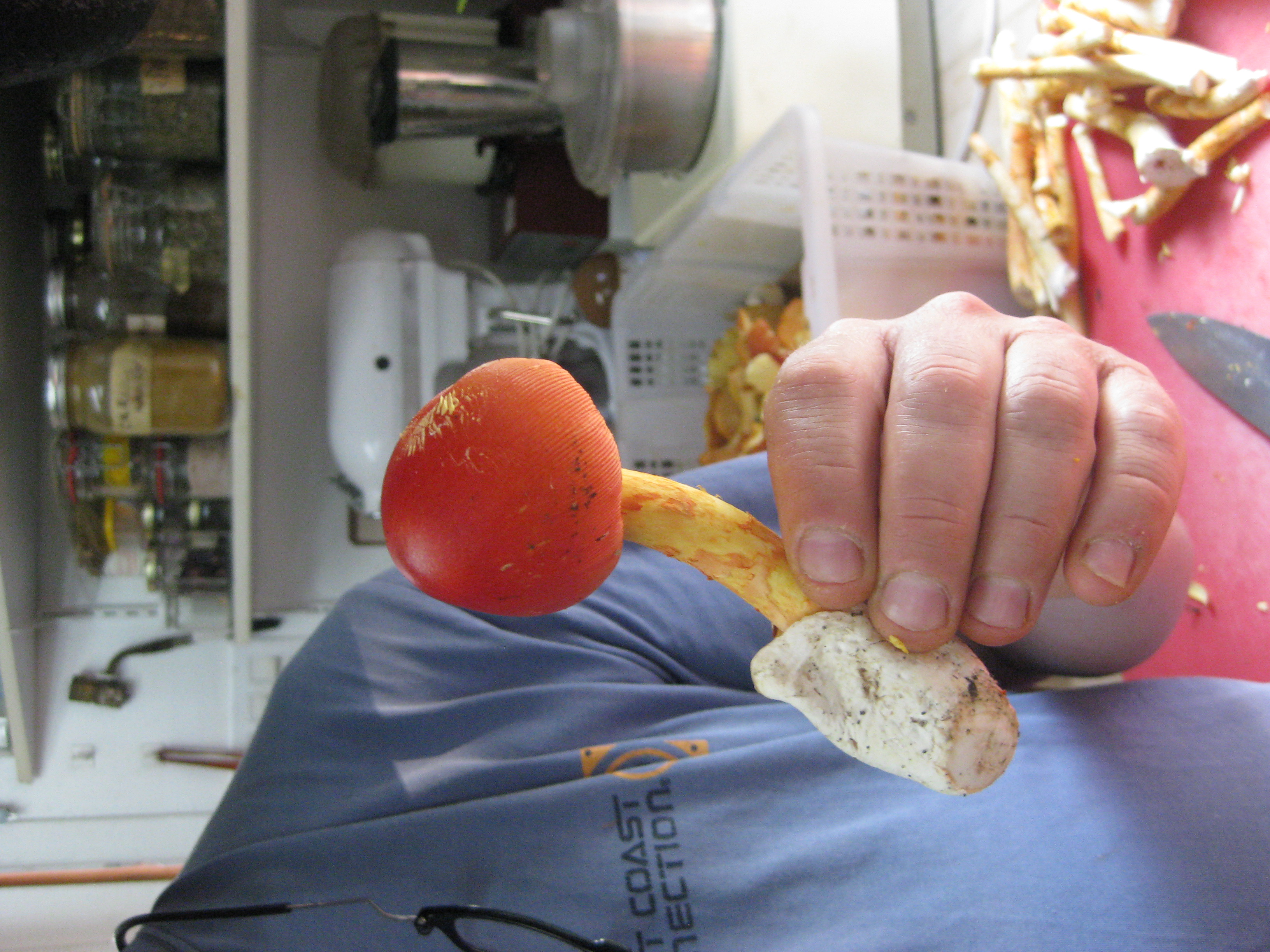 bebe amanite des césars
bebe amanite des césars
And there is hope yet across the board - this past week was fantastic, the best of the year yet. Cepes & Lactaires Délicieux are sprouting in the backyard. The shrooms are coming in from all our pickers at a faster pace by the day and I’m managing to cover with less staff than in prior years. We processed 200lb this weekend alone and there is a major line up for the dehydrator and my time. Gorgeous yellowfoot chanterelles and hedgehogs! Came across a good amount of a variety of small hedgehog (pied de mouton ombeliqué) that is a fun novelty. A pretty stellar year for that rare maple scented Lactarius too, probably not enough to sell but sufficient for my restaurant needs. A trickle of armilaires and matsutake, hoping for more.. Lactaires Delicieux, Puffballs and autumn cepes, slippery jacks and Larch boletes showing up on schedule here, weehoo. Some beefsteak polypore a bonus! The autumn oysters, smooth lepiota and shaggy mane will be next, fingers crossed.
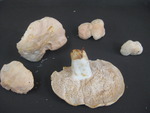 pied de mouton/hedgehog, nice harvest from Gaspesie getting better by the day
pied de mouton/hedgehog, nice harvest from Gaspesie getting better by the day
 pied de mouton ombeliqué
pied de mouton ombeliqué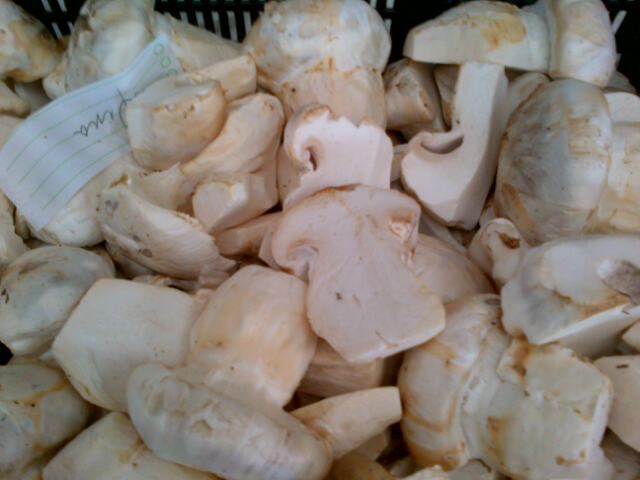 armillaire ventru/swollen stalked cat
armillaire ventru/swollen stalked cat
She just might catch up that tricky dame nature. And I will have no choice but to follow.. Which is fine; I am now used to responding to her whims, and it so happens that cooks looking for work appear to be coming out of the woodwork as they magically do in fall. Forever grateful even if I have to scramble and go into overdrive this autumn season. Let a new set of games begin! Countdown to our mushroom festival Oct 12-28!
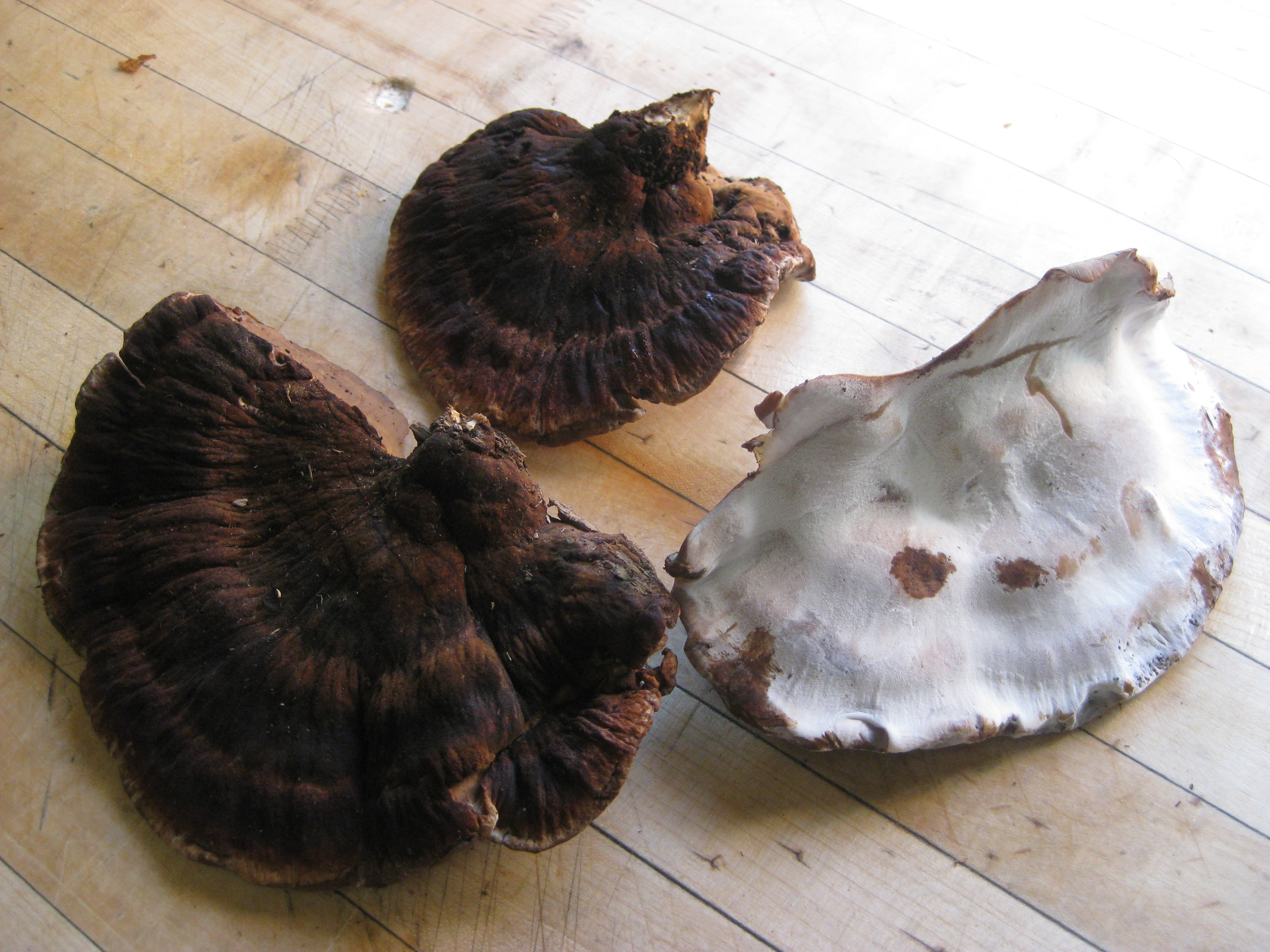 Beefsteak Polypore
Beefsteak Polypore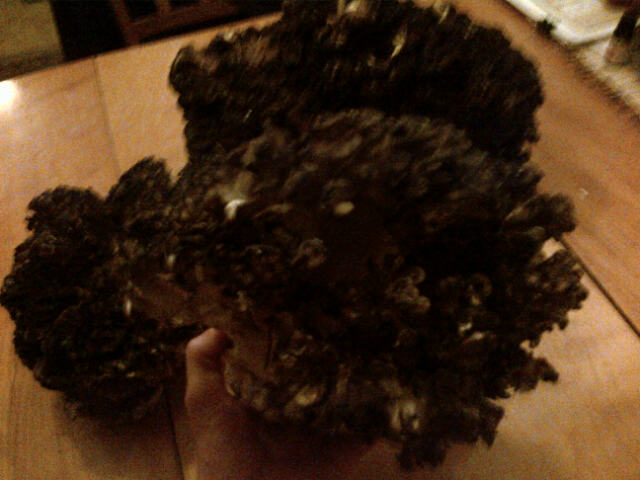 Hen of the woods, a favourite for a braise or to pickle
Hen of the woods, a favourite for a braise or to pickle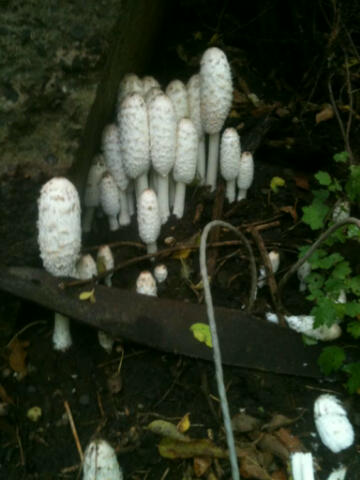 shaggy mane; best when young (same day), no dark color - in soup
shaggy mane; best when young (same day), no dark color - in soup  autumn oyster (or elm oyster; although it grows on maple)
autumn oyster (or elm oyster; although it grows on maple)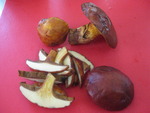 another slimy/hard to work bolet that pays off in the dehydrator
another slimy/hard to work bolet that pays off in the dehydrator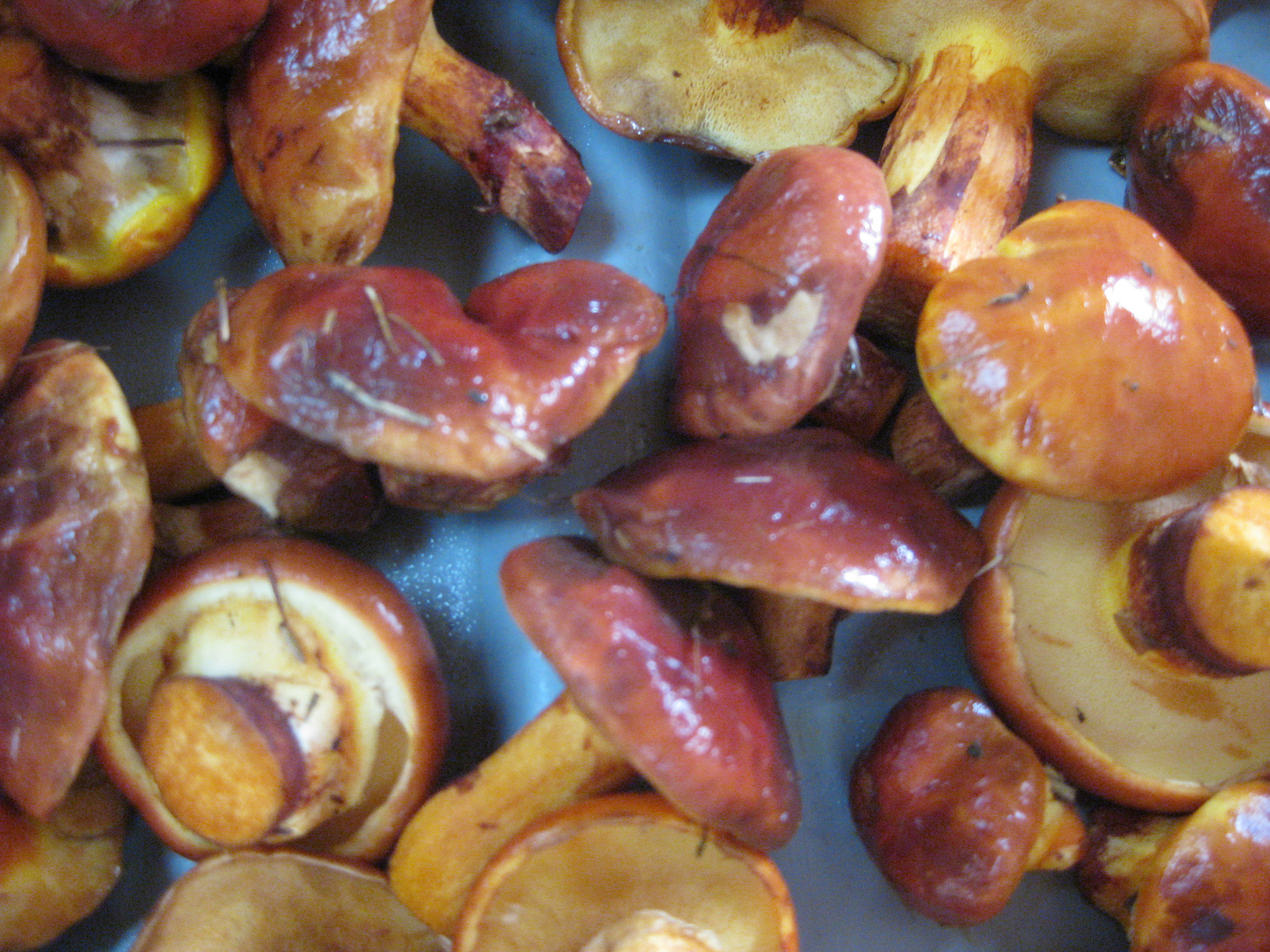 Larch bolete - one of the best flavourwise but it's a pain to clean (and expensive with 5% yield after drying).
Larch bolete - one of the best flavourwise but it's a pain to clean (and expensive with 5% yield after drying).
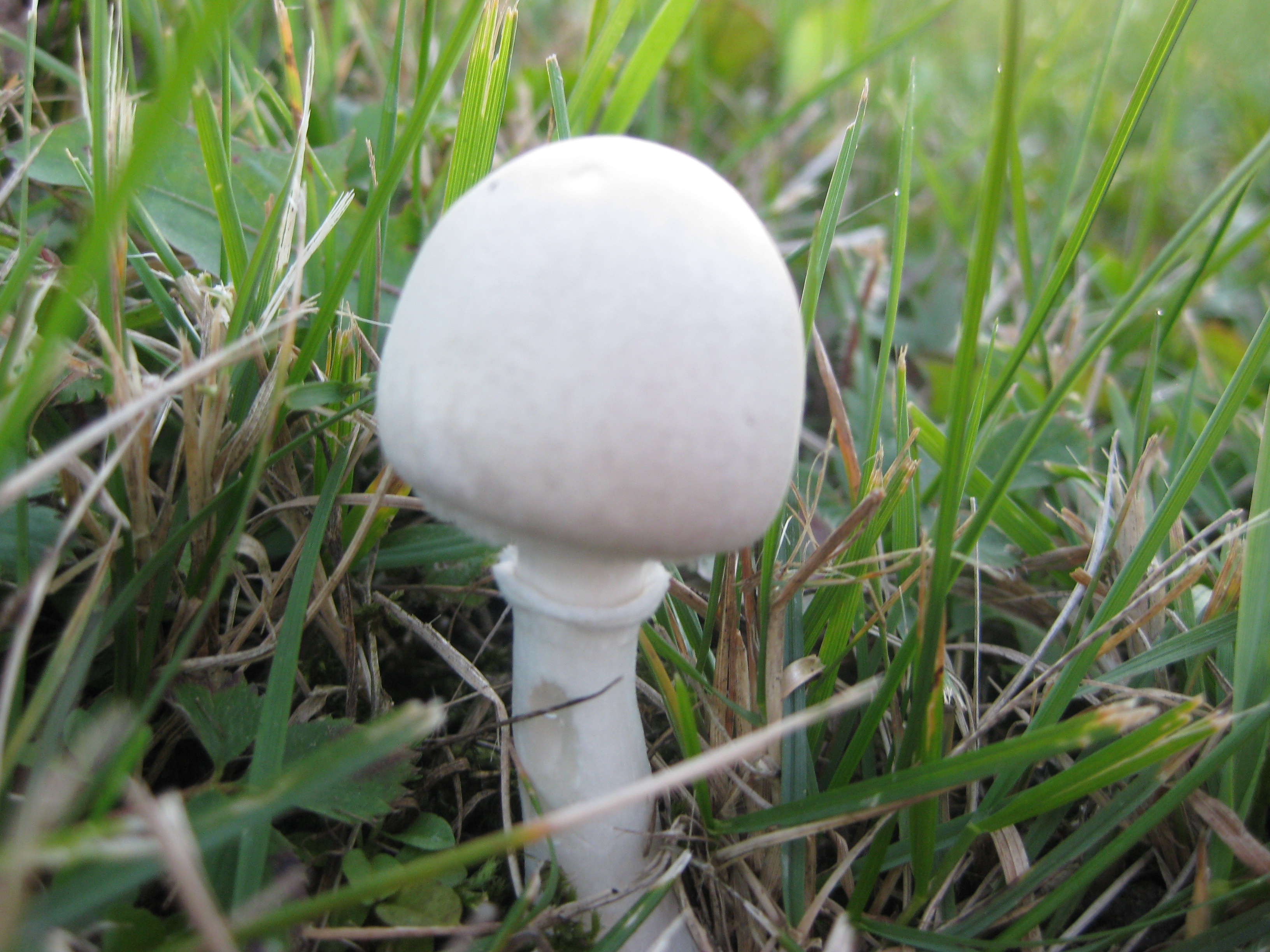 Smooth Lepiota - to be picked with caution because it looks a lot like dangerous varieties like 'the destroying angel'
Smooth Lepiota - to be picked with caution because it looks a lot like dangerous varieties like 'the destroying angel'
Canada Food Day August 4th
At les Jardins Sauvages, we are celebrating Canada Food Day Saturday, August 4th!.
This is a national ‘holiday’ celebrating local food and good eating. On the same day, across the country, both chefs and home cooks (whole villages even) will be simultaneously feasting on menus composed of fresh and local products while raising a glass to our rich and diverse culinary landscape. Organized by Anita Stewart, acclaimed food writer and long time proponent of Canadian food, she has lots of great people and restaurants on board, check it out.. www.fooddaycanada.ca.
Of course, my menu is always focused on local, artisanal and wild foods, but I love this initiative. We should be eating like this year round both for our health and happiness, as well as for the land. I like the idea of fostering national and regional culinary pride, and I am all for another reason to get together over good food and wine, one day at a time. At the height of the growing season, every meal is so easily a celebration, so why not join in!
Our food day menu can be viewed below or at www.jardinssauvages.com
To reserve, please call 450-588-5125
Les Jardins Sauvages Menu
*Canada Food day* August 4th
Wild & stuffed garden vegetables, fresh goat cheese and day lily - bee balm pesto
with sea parsley and garlic mustard leaf, smoked lobster mushroom and pickled daisy buds
Hot’n sour duck soup with wild ginger and organic guinea fowl,
Maitake mushroom, sea plantago, buckwheat noodles,
basil and coriander from the garden
Sea spinach, sea rocket and sea asparagus salad with Canadian sandspurry
and lady’s sorrel, fried sturgeon and eel brandade, Nordic shrimp, crinkleroot dressing
Venison from the farm, bolete and sarsaparilla pan sauce,
mushroom oil potato parmentier with venison sausage, chanterelles and corn,
mustard greens, cattail spear
Option : Québec cheese plate, Selections from La Suisse Normande
(100g for two; 7.50$ supplement per person)
Wild blackberry and blueberry tartlet with sweet clover flower frangipane,
elderberry panna cotta, milkweed flower jelly and granité
Tea, coffee
Wild leaf tisane, 3$ supplement
Bring your own wine
75.00$, taxes included, service extra
Your host and forager : François Brouillard
Your chef : Nancy Hinton
Nous célébrons ‘Canada Food Day’, la Journée des Terroirs, à la table des Jardins Sauvages Samedi le 4 Aout, 2012.
Ce jour, à travers le Canada, comme à toutes les années depuis 2003, c’est la fête des produits du terroir. L'idée c'est de créer un menu mettant en valeur de beaux produits de chez nous, bien manger et célébrer la richesse culinaire Canadienne (et Québécoise) - ensemble les chefs dans les restaurants avec leurs clients, et les gens au BBQ à la maison. Cet événement est organisé par Anita Stewart, une grande doyenne de cuisine Canadienne. www.fooddaycanada.ca
C'est certain que mon menu est toujours basé sur les produits locaux, artisanales et sauvages, mais je trouve cela une belle initiative. A la hauteur de la saison, c’est si facile de manger frais, d’embarquer les gens et les sensibiliser à la façon la plus saine et joyeuse de se nourrir.. En plus, une fête de plus au tour des plaisirs de la table - pourquoi pas?
Vous pouvez visionner mon menu ici en bas ou www.jardinssauvages.com
Pour réserver, SVP appelez 450-588-5125
Menu du 4 Août
*Canada Food day; Journée des Terroirs*
Petits farcis au fromage frais de chèvre et pesto de pétales d’hémérocalles, monarde,
alliaire et persil de mer, champignon Lobster fumé, boutons de marguerite marinés
Bouillon de canard à l’orientale au gingembre sauvage, pintade bio,
Maitake, plantain marin, nouilles de sarrasin, basilic et coriandre du jardin
Salade marine et sauvage : brandade d’esturgeon et anguille fumé,
crevettes nordiques, arroche de mer et salicorne, spergulaire et oxalis, vinaigrette carcajou
Cerf du domaine, sauce aux bolets et à la salsepareille,
Parmentier à l’huile de bolets, saucisse de cerf maison,
maïs et chanterelles, feuilles de moutarde, épis de quenouille
Option : Assiette de fromages de la région,
(100g pour deux; supplément de 7.50$ par pers.)
Clafouti aux mures et bleuets sauvages avec frangipane aux fleurs de mélilot,
panna cotta au sureau, gelée et granité aux fleurs d’asclépiade
Thé, café
Tisane maison (supplément de 3$)
Apportez votre vin
75.00$ taxes incluses, service en sus
Votre hôte et spécialiste de plantes sauvages: François Brouillard
Votre chef : Nancy Hinton
Highlights - Early Summer 2012
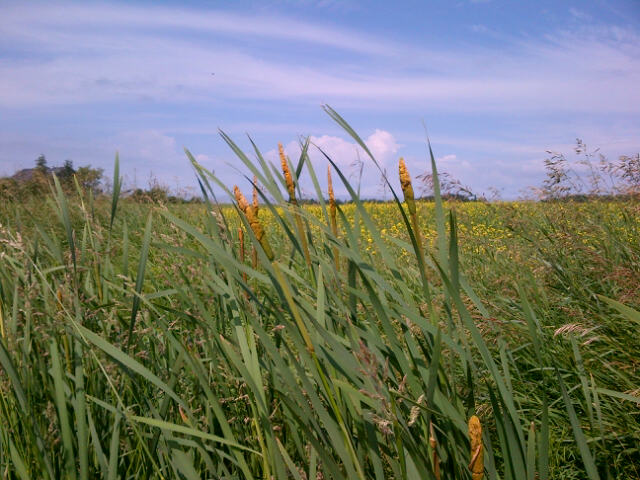 quenouilles (cattails)
quenouilles (cattails)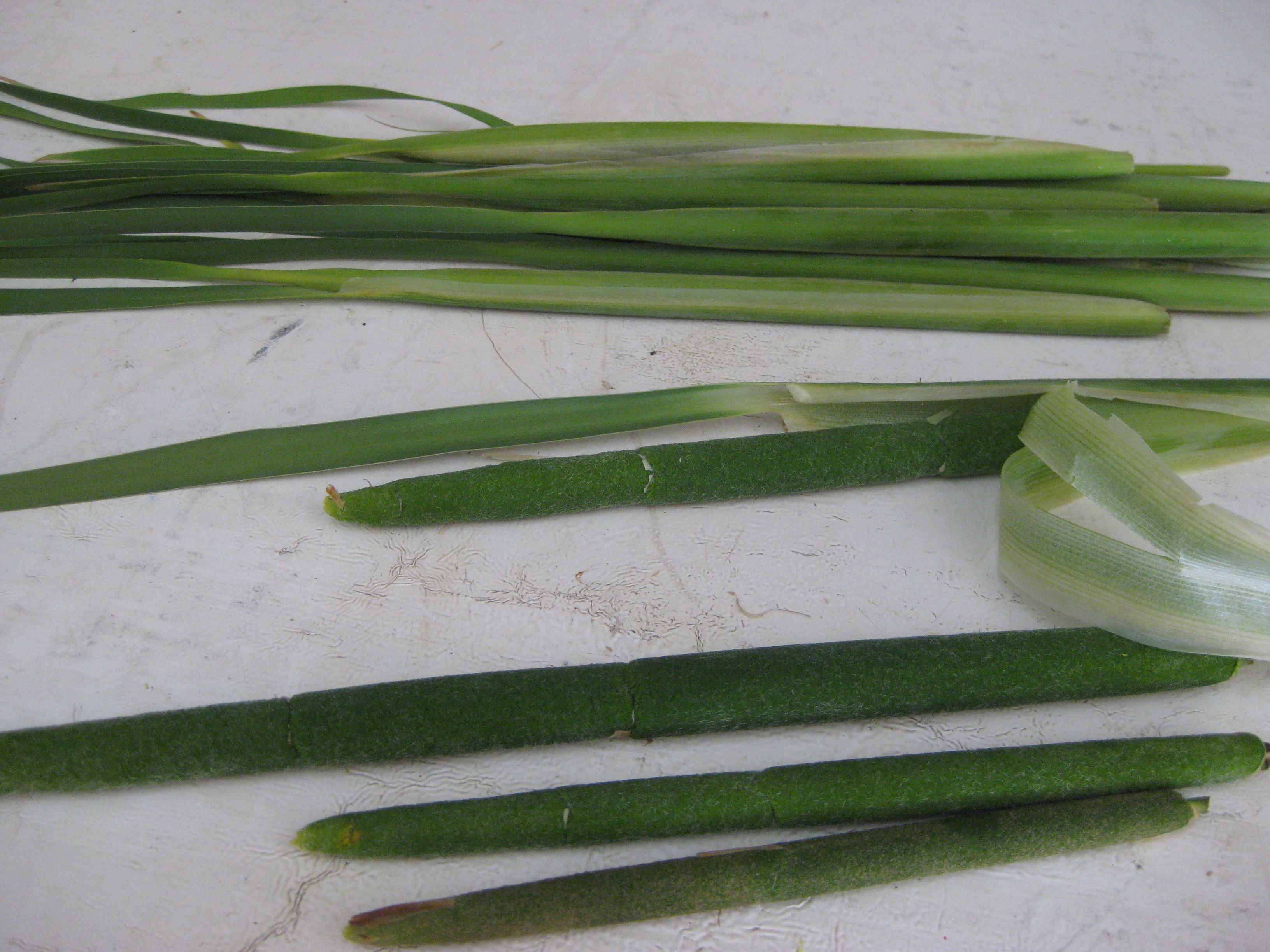 epis de quenouille (cattail spears) - raw and peeled
epis de quenouille (cattail spears) - raw and peeled
 farine de quenouille-pollen (cattail pollen flower)
farine de quenouille-pollen (cattail pollen flower)
True to our annual summer routine at Les Jardins Sauvage, life is all about trying to keep up with the wild plants as they successively come into season whenever they damn well feel like it.
This year is not so different; many July edibles showed up early making for somewhat of a pile-up in putting up/production, but an extraordinary abundance and variety for those dining at the restaurant or frequenting our market stall.
Once the spring things were out of the way, it was all about pickling the daisy buds and soonafter the day lily buds, then it was cattail time.
Or 'Operation Quenouille' as we call it - For a couple of weeks every year, we are entirely consumed with cattails. There is an unpredictable short window to pick the baby spears you see.. We peel thousands, blanch and sous vide them for the year. Everyone on staff is peeling day in day out, every spare moment. Then it's the pollen, which is dried and ground after harvesting. That is hard picking work given this corresponds with peak mosquito season - those responsible are all glad it only lasts a couple of days. In the kitchen, a fine yellow dust covers everything no matter how carefully we work. Blow your nose at home at the end of the day - yellow! Well worth it though; the spears provide a fun local vegetable that you eat like corncob or pogo, and it tastes like corn, with a touch of mushroom and asparagus. Makes a great umami rich vegetarian broth too. We use the pollen in crepe batter mostly, but it can season and thicken stuffings, go into quick breads and cheese. I like to dust savoury fritters with it.
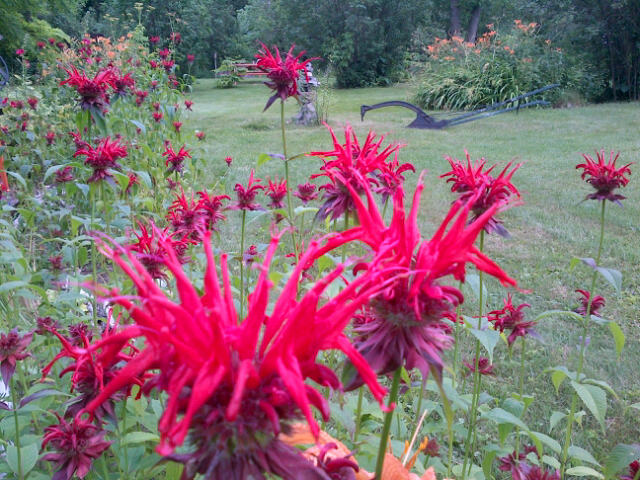 Monarde (Bee balm)
Monarde (Bee balm)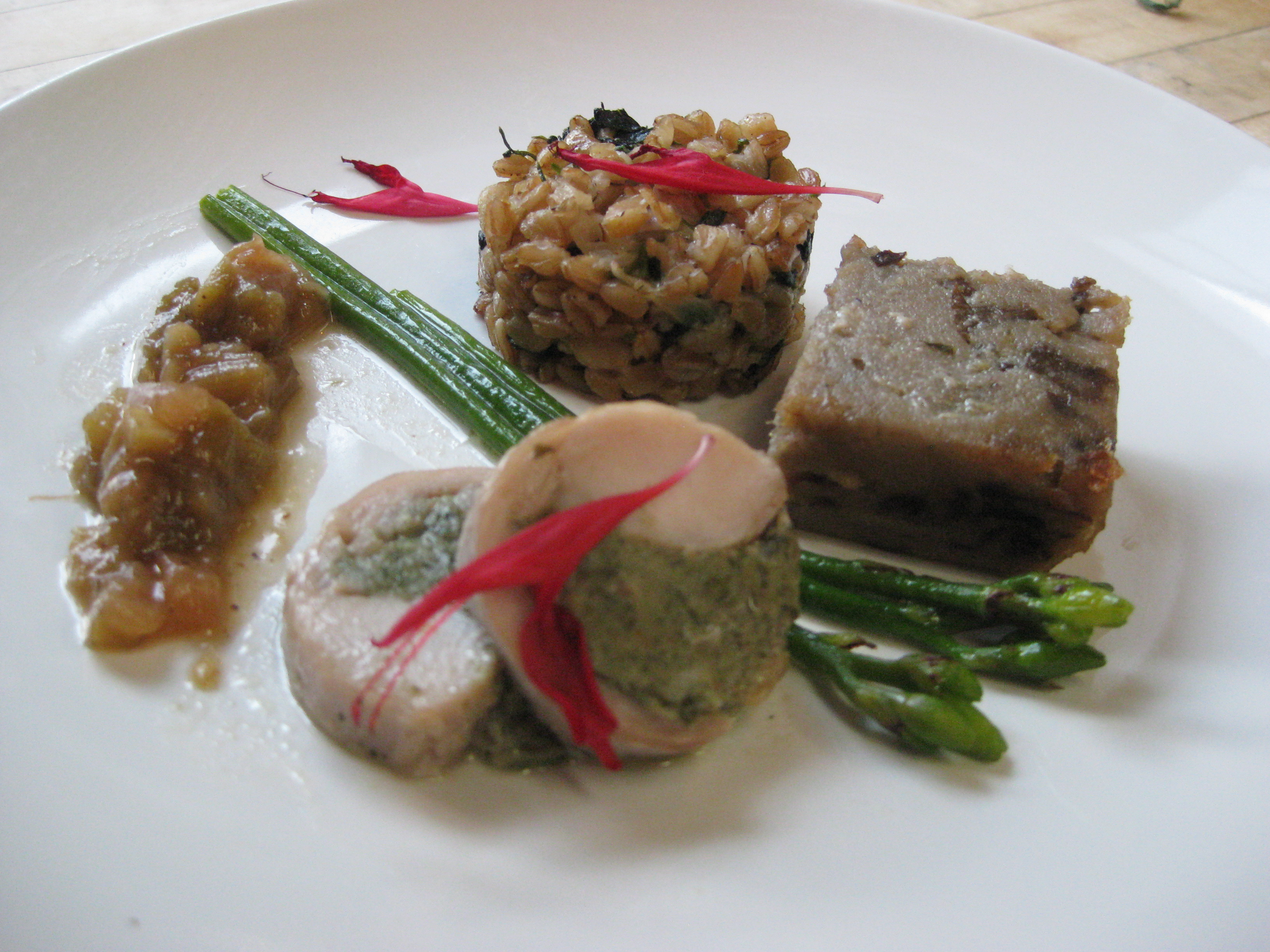 Duo de lapin, ortie & monarde, épautre, pousses d'hémérocalles Bee balm is a favourite of ours. So pretty and punchy, it is more than a colourful garnish; with its thyme like mentholy flavor, it is used more like an herb. To flavour or garnish soups, salads, butter, cheese, sauces, meatballs.. We also dry it and use it in our tisane.
Duo de lapin, ortie & monarde, épautre, pousses d'hémérocalles Bee balm is a favourite of ours. So pretty and punchy, it is more than a colourful garnish; with its thyme like mentholy flavor, it is used more like an herb. To flavour or garnish soups, salads, butter, cheese, sauces, meatballs.. We also dry it and use it in our tisane.
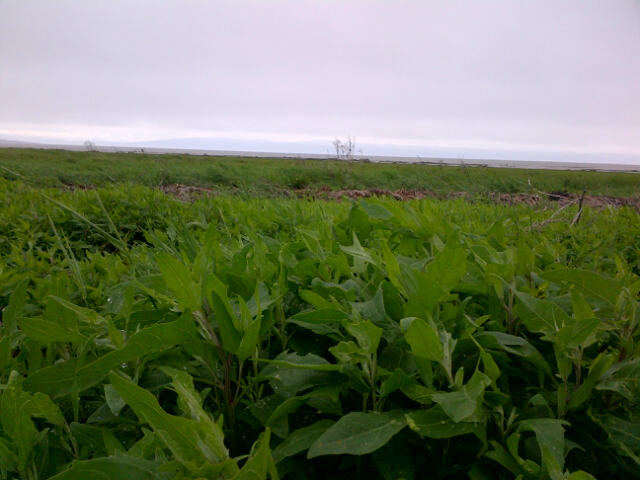 Arroche de mer (Sea spinach)
Arroche de mer (Sea spinach)
Sea spinach is my absolute favourite, like super duper spinach, a notch up from Chou gras (pigweed/lambs quarters), which is also a great, under-appreciated weed. Terrific in salad, even better barely cooked, just wilted with garlic and olive oil or butter. Arroche was definitely a key wild green in our courtship (when I first met François and he was charming me with all his exotic ingredients). We sell and serve up a lot of this fresh in season, but we also blanch and sous-vide a big batch for the year, and we dry some for our salt.
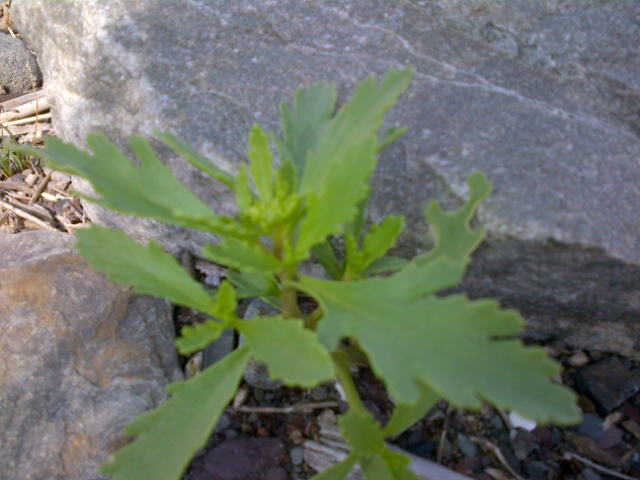 Caquiller de mer (Sea rocket)
Caquiller de mer (Sea rocket)
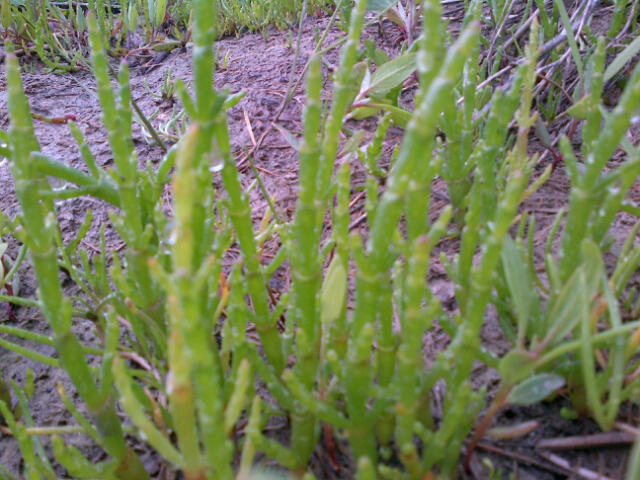 Salicorne (sea asparagus)More sea greens, both very popular at the market. Sea rocket is like sturdy, salty arugula, to be eaten in salad or cooked. Not much needs to be said about sea asparagus which is more widely known, being so lovable, crunchy and salty. Especially ours in peak season, which is picked in the perfect micro-climate, extra special
Salicorne (sea asparagus)More sea greens, both very popular at the market. Sea rocket is like sturdy, salty arugula, to be eaten in salad or cooked. Not much needs to be said about sea asparagus which is more widely known, being so lovable, crunchy and salty. Especially ours in peak season, which is picked in the perfect micro-climate, extra special
.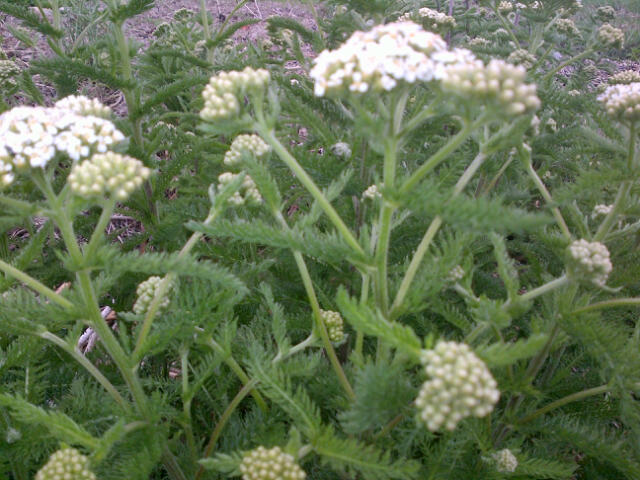 achillee millefeuille (common yarrow)
achillee millefeuille (common yarrow)
Yarrow is everywhere and a mildly interesting herb that we add to our mix. We also dry it for tisane. It is known for all its medicinal qualities (cold, wounds..). The flowers are especially medecinal, so kept for that.
Wild rose petals - one of the most pleasant things to pick, dry or cook! So fragrant and fresh smelling/tasting. We dry a load for our tisane, make syrup and use them in infusions for desserts (juices, coulis, granité). Interesting in savoury preparations too. The fruit, however difficult to work with all its seeds, has a characteristic soft flavour and mouthfeel unlike anything else, ultra high in Vitamin C, somewhere between a tomato and an apricot in taste. Claudie (Jardins de la Mer), our marine green girl, makes a fabulous juice combined with elderflower that is my preferred non-alcholic beverage. Not yet readily available yet outside the Lower St-Lawrence, but something to look forward to.
Spergulaire is another marine green that grows amidst the salicorne and arroche - it is sparse, and hard to find/pick efficiently but it is delicious - tasting like beets, but delicate fresh and crunchy. Sea plantain is kind of blah to me, in that it does not have much character, but mild is fine sometimes too. It is good chopped up in the mesclun or cooked as a side vegetable. The best preparation to me is blanched and served up like green spaghetti sans gluten!
Sea parsley, the marine sister to the wild lovage on our property, tastes like floral, slightly salty celery, and is key in my kitchen. We make a pesto with it, we dry it for our salt, make an infused oil, and it is integral to my chimichurri. I use it everywhere year round.
While all the marine greens are peaking and François is on the road alot, our backyard is orange. Fields of day lily yell out for the taking. Once the sprouts and buds (which are a terrific vegetable) are done, it's petal time. They are best freshly picked and raw in salads or as a garnish, but given the quantity we have readily available, we do a lot more. Of course it takes someone to pick them, but it's impossible to not be sustainable.. I've dried a hundred gallon buckets or so of petals for our tisane and put up half that much in pesto. Delicately floral, even more vegetal-fresh tasting, I make butter with it, as well as use it in preparations to accompany fish, poultry or cheese.
Melilot (sweet clover) is a flower I use more like a spice. It is dried and pulverised to be incorporated into pie dough, cookies.. Most other flowers I prefer to use infused and in the fresh state, but not this one. It is potent and due to coumarine content,should be used carefully.
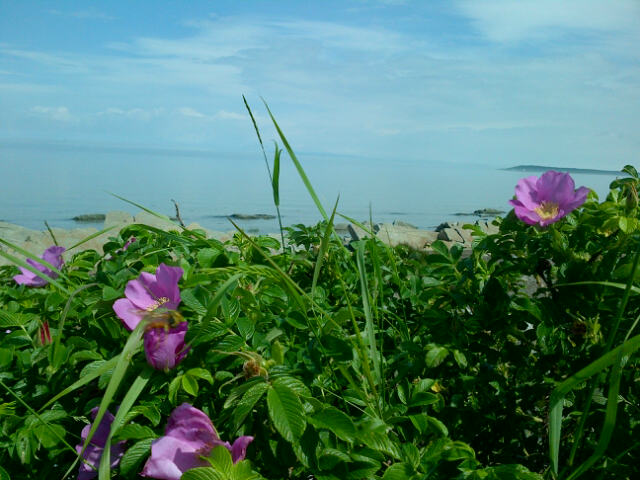 églantier (wild rose)
églantier (wild rose)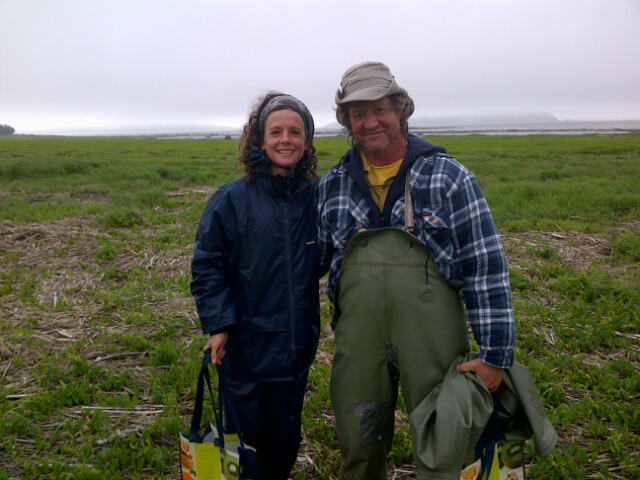 foraging in the worst weather
foraging in the worst weather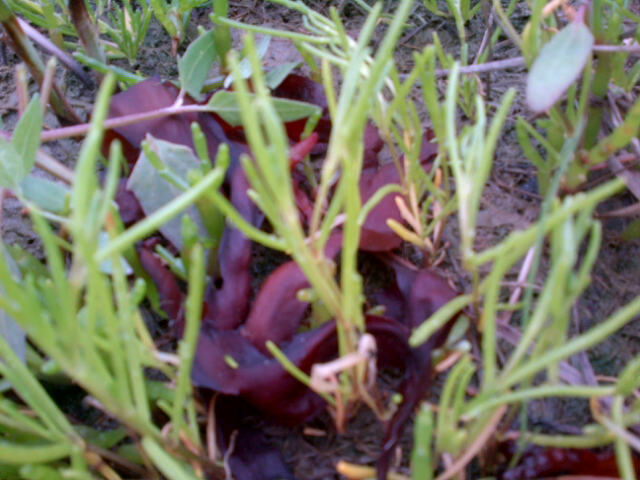 spergulaire (Canadian sandspurry)
spergulaire (Canadian sandspurry)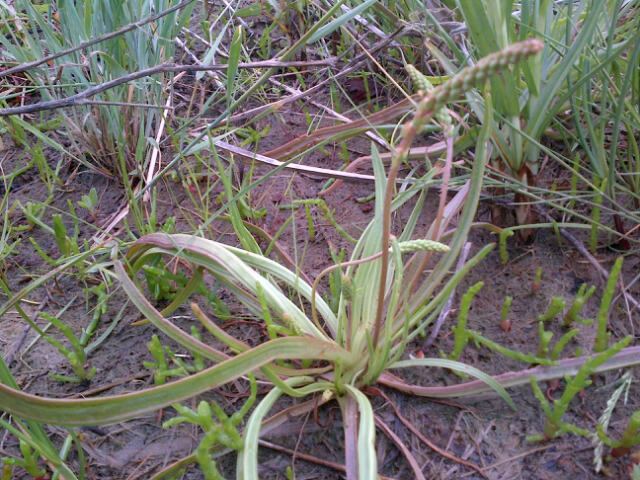 plantain marin (sea plantago)
plantain marin (sea plantago)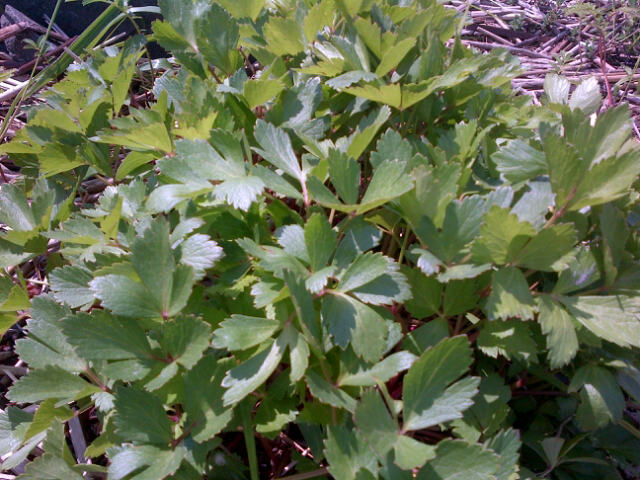 persil de mer (sea parsley)
persil de mer (sea parsley)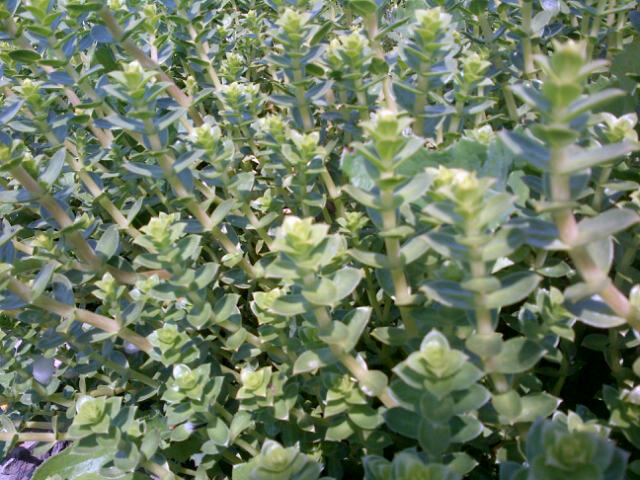 sabline
sabline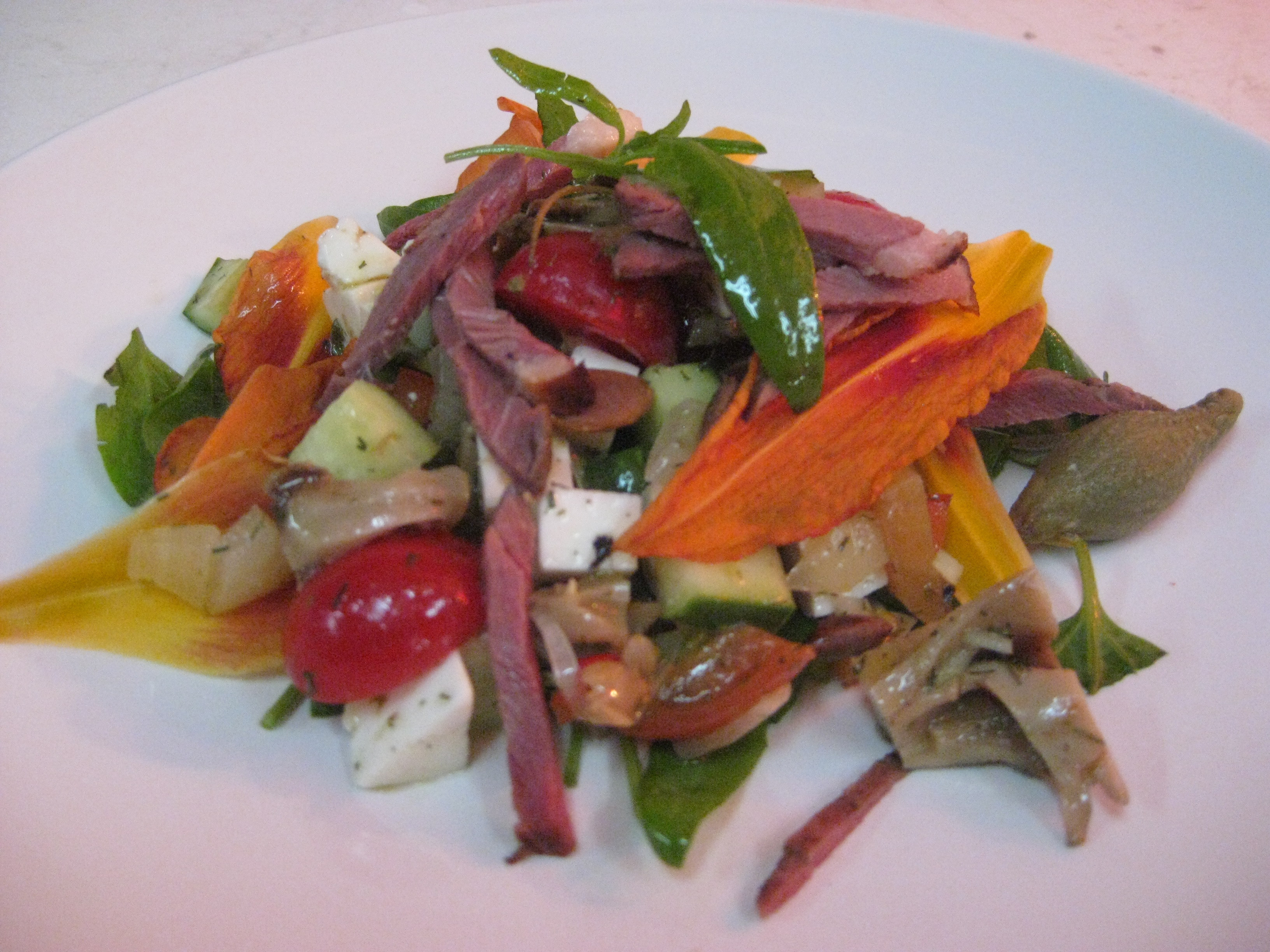 salade d'aroche de mer & hémérocalle, salsa de tomate, concombre et champignons marinés au carcajou, feta de chevre
salade d'aroche de mer & hémérocalle, salsa de tomate, concombre et champignons marinés au carcajou, feta de chevre our field of day lily
our field of day lily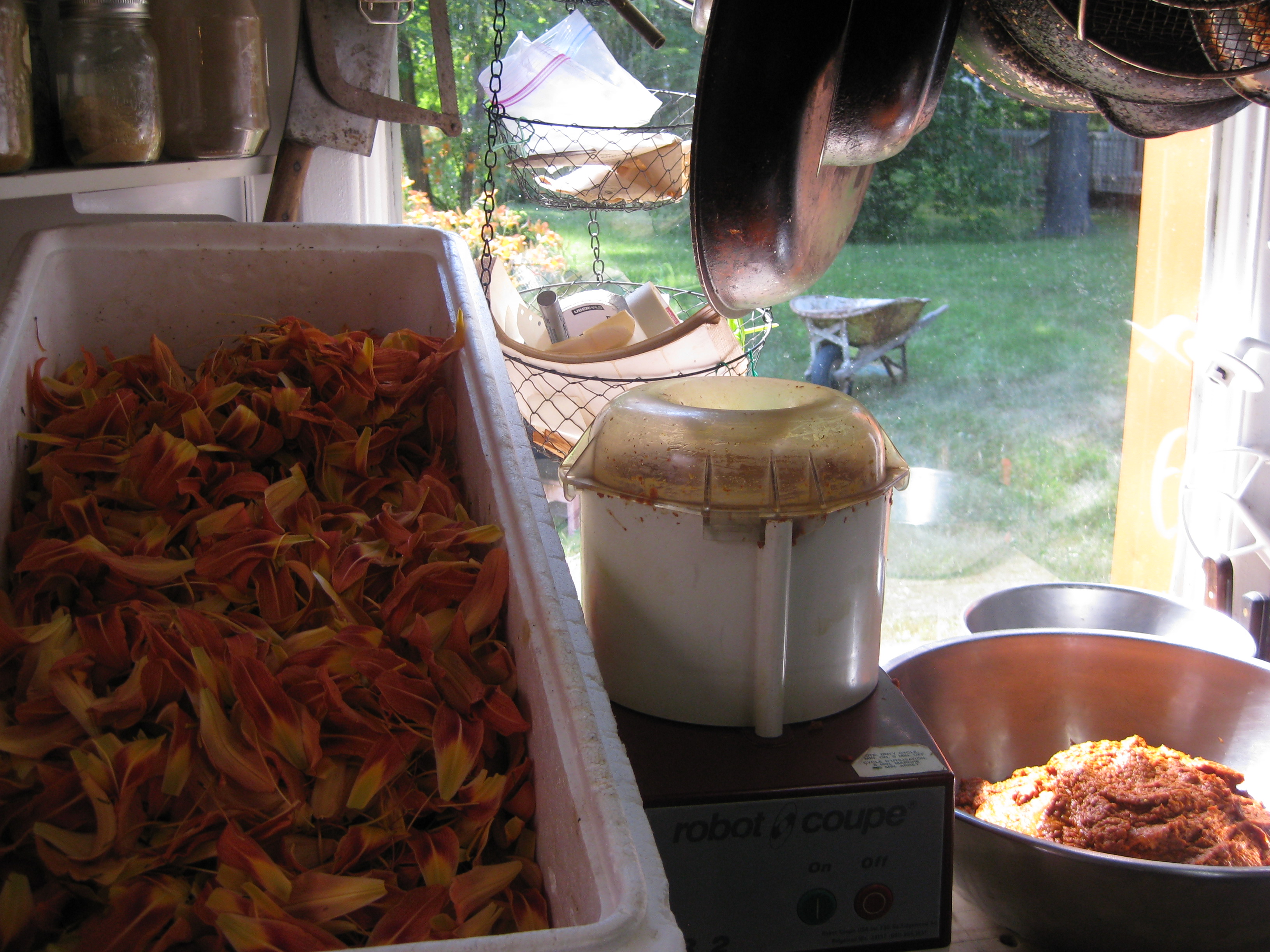 making petal pesto
making petal pesto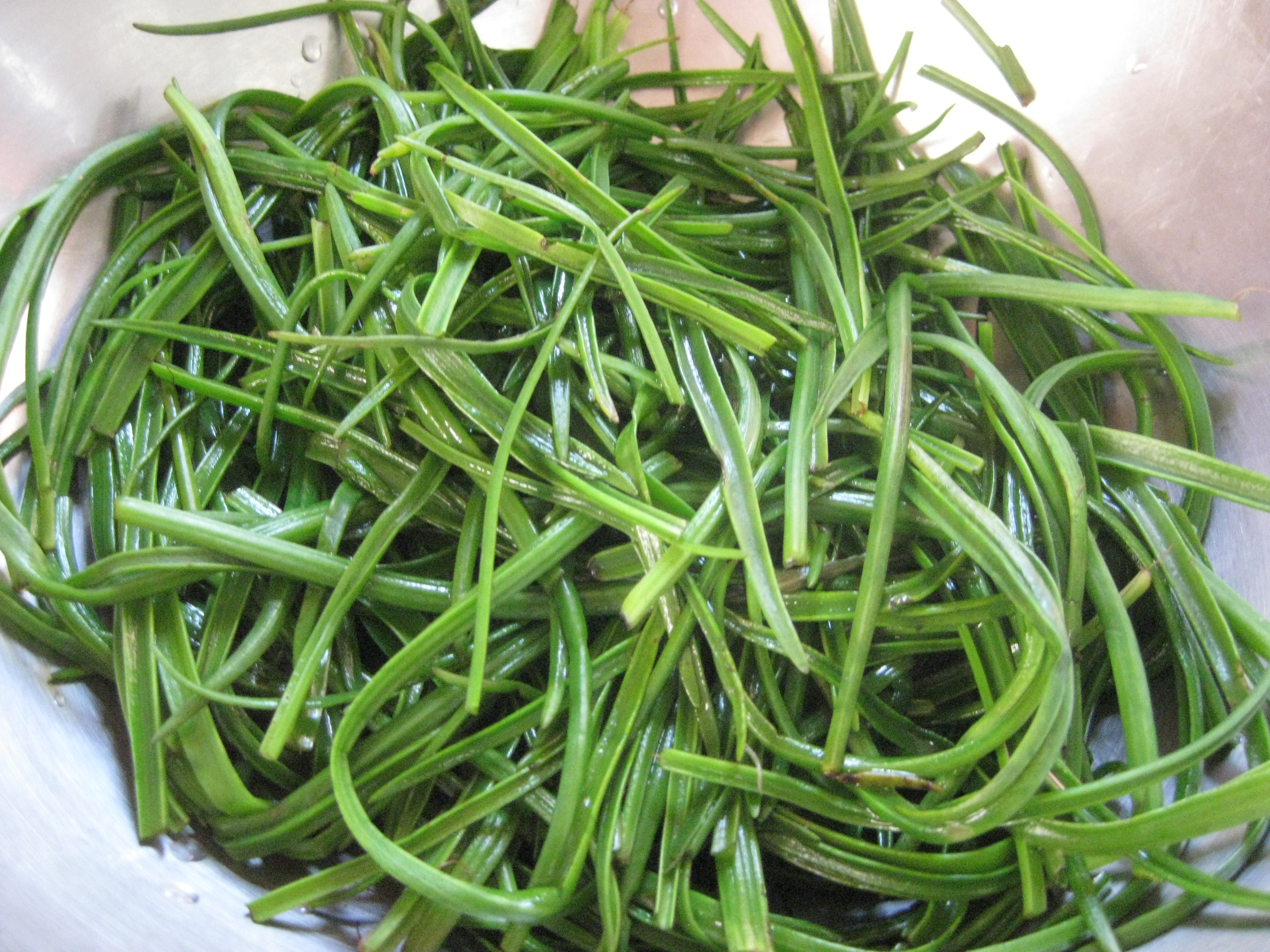 plantain=green spaghetti
plantain=green spaghetti
 fleurs d'asclépiade (milkweed flower)
fleurs d'asclépiade (milkweed flower)
 brocoli d'asclépiade (milkweed brocoli) - the unopened flower
brocoli d'asclépiade (milkweed brocoli) - the unopened flower marguerite (daisy) - past the point when we use them, but pretty none the less
marguerite (daisy) - past the point when we use them, but pretty none the less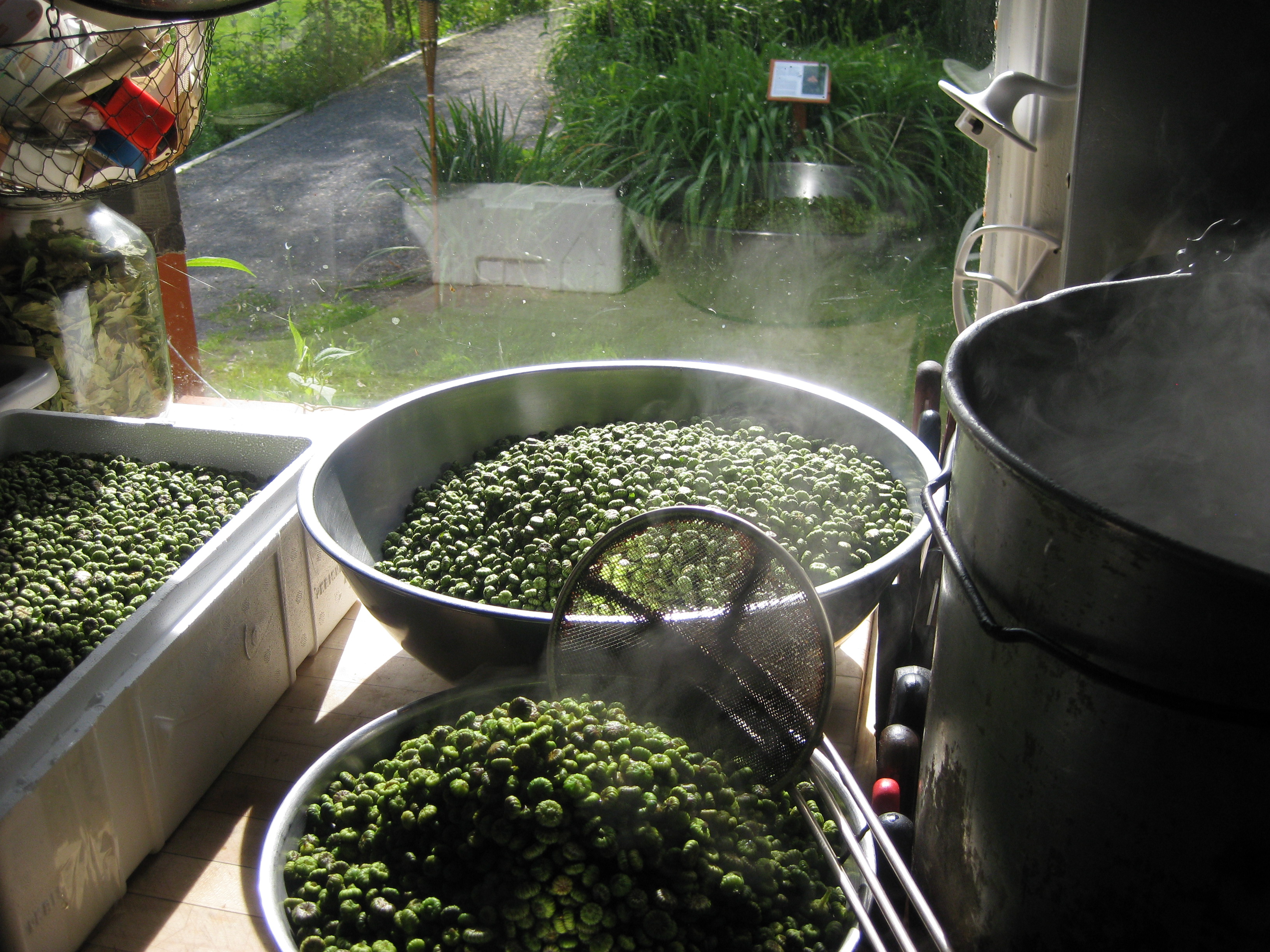 Pickling pounds of daisy buds
Pickling pounds of daisy buds
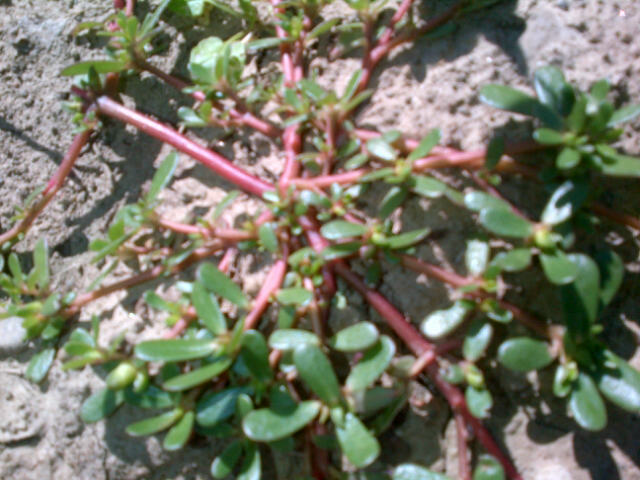 pourpier (purselane) - another hearty weed worth adding to your salad plate - lemony!
pourpier (purselane) - another hearty weed worth adding to your salad plate - lemony! 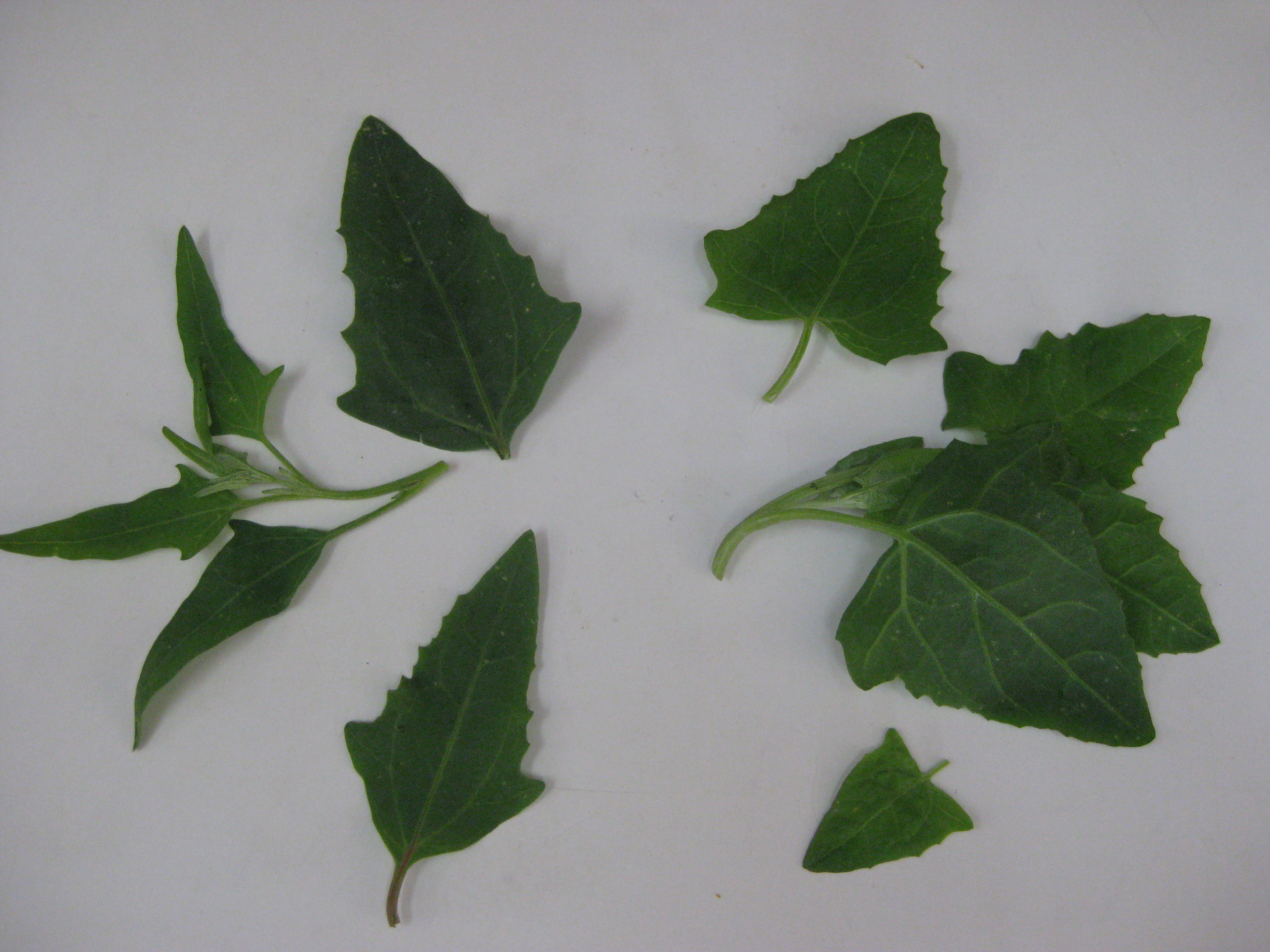 chougras vs arroche de mer (pigweed/lambs quarters vs. sea spinach)
chougras vs arroche de mer (pigweed/lambs quarters vs. sea spinach) 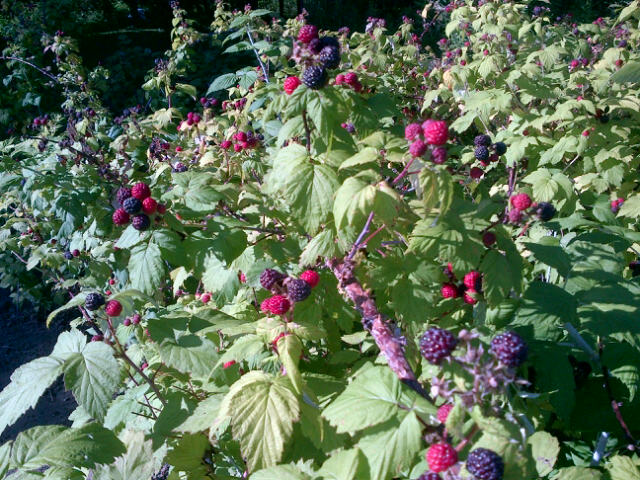 framboises noir (black raspberries)
framboises noir (black raspberries)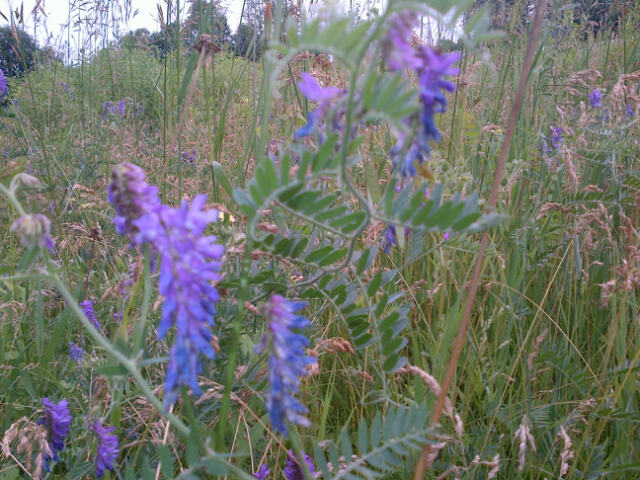 vesce jargeau (tufted vetch)
vesce jargeau (tufted vetch)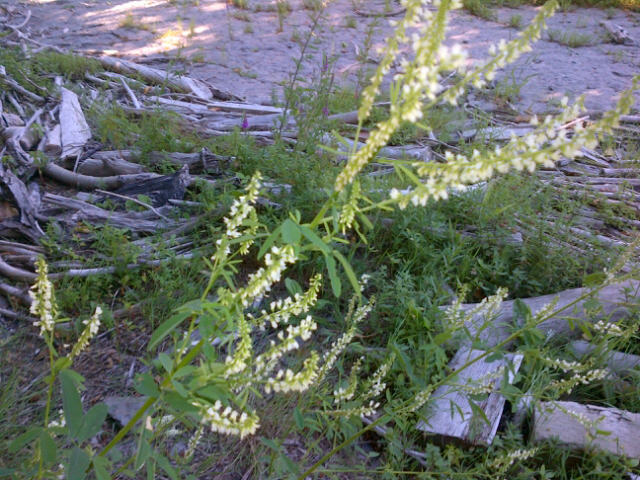 mélilot blanc (sweet clover flower)
mélilot blanc (sweet clover flower)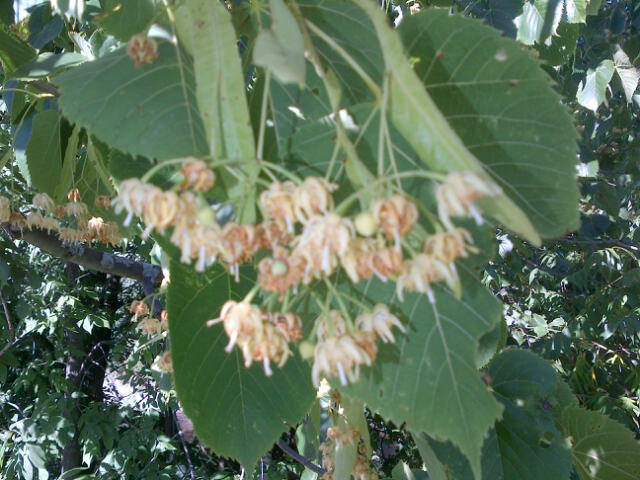 tilleuil (linden flower)
tilleuil (linden flower)
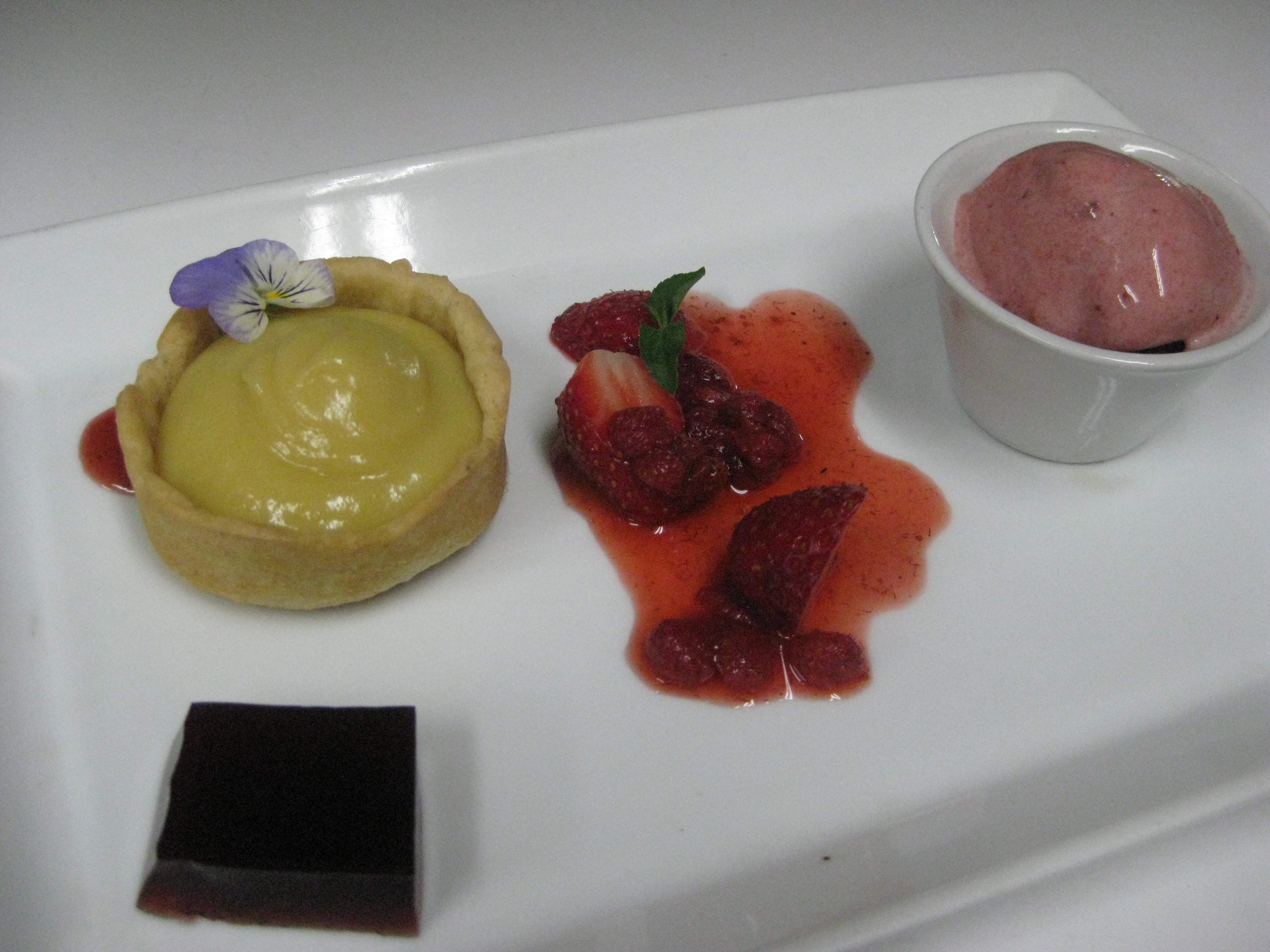 tartelette au fleurs de mélilot et creme de citron-sureau, gelée et sorbet aux fraises aux fleurs d'asclépiade
tartelette au fleurs de mélilot et creme de citron-sureau, gelée et sorbet aux fraises aux fleurs d'asclépiade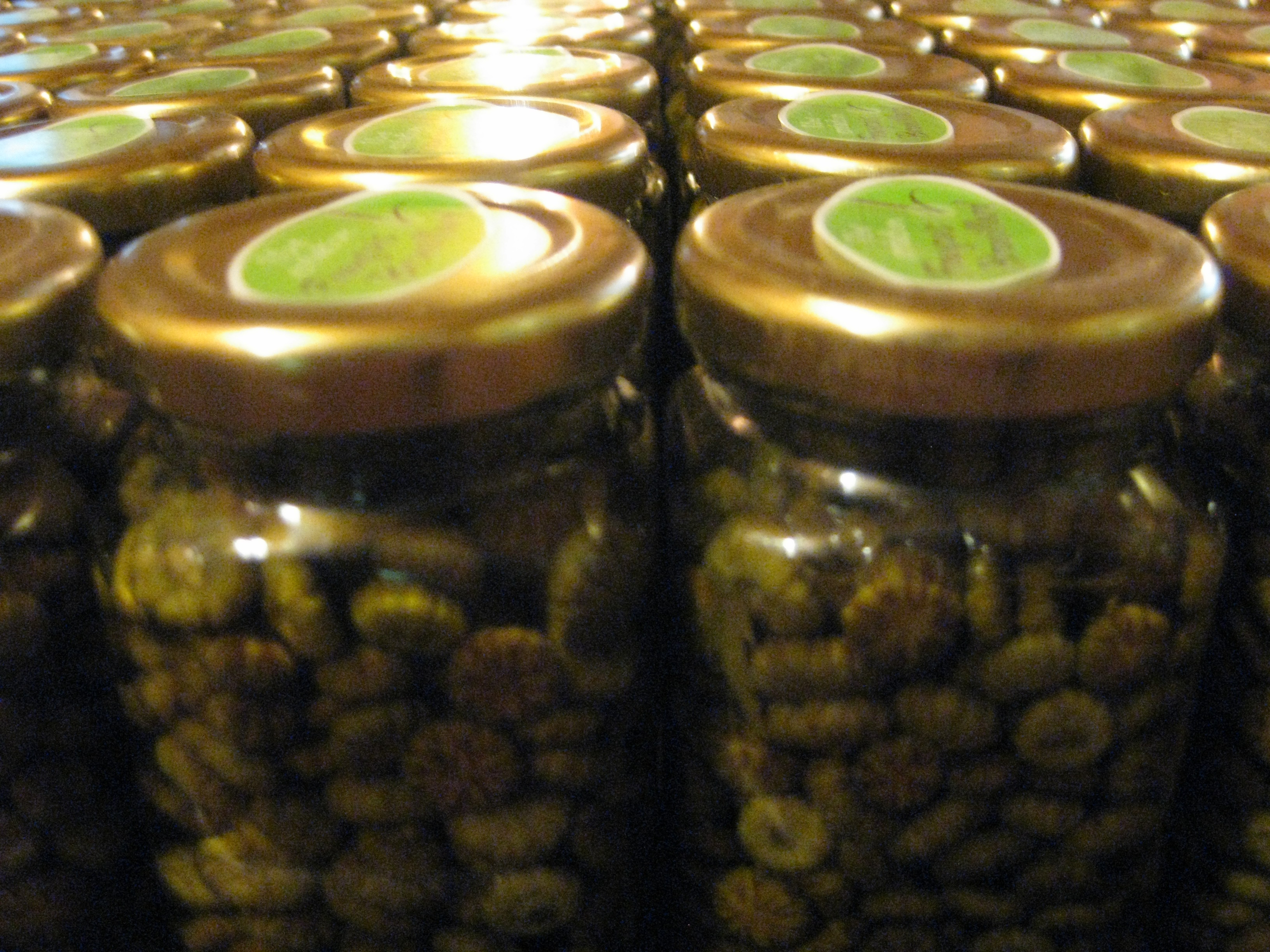 40+ cases of little bud packed jars, ouf
40+ cases of little bud packed jars, ouf
Milkweed flower deserves special mention, because it is so fragrant and particular, quite common and unknown. I love to pair it with wild berries or any fruit - in infusions, so jelly, granité, sorbet etc. What a pretty garnish too! It's hard to believe that they are the next stage in the plant's lifecycle after the milkweed brocoli, which is 100% vegetable. Important to be picked early, well washed and cooked through in lots of water, I typically blanch it for 5min before proceeding with a number of treatments, the most winner being tempura.
Linden is flowering now, and although beyond the leaves in spring, this hasn't been something we've taken the time to exploit; I figure now is the time - the heady accacia like aroma is seductive. Slightly fibrous, I can't imagine using them as is, more likely infused or dried and pulverized..
The sumac ripening shows promise, and our garden of cultivated things is overflowing, which means that the mushrooms are not far off. A few bolets and chanterelles have been spotted, but until this dry weather lets up, there won't be much going on. As we know very well, it can all change in a few days.. Better get as many marine greens in as possible and make sure we have our flowers for the tisane, get going going on the berries. Laitue de mer, check. Because soon enough François will have to let all the rest go and focus on the mushrooms. More madness to follow!  our dehyrdrator is working overtime
our dehyrdrator is working overtime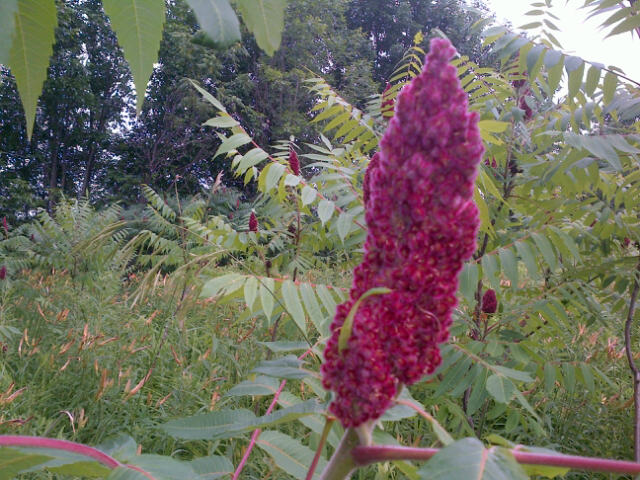 sumac, not quite ready but local lemonade is not far off
sumac, not quite ready but local lemonade is not far off
Smells like summer
It smells like summer with the heady aroma of acacia blossoms in the air! It’s quite amazing how much olfactory pleasure that one tree in front of my kitchen delivers for one week a year. I feel the need to put them in my new dessert, naturally paired with the beautiful strawberries in season, but damn I already have my spruce tip syrup burning a hole in my fridge for that. I know that summer is here when I have too many beautiful ingredients to possibly cram onto one menu.

I have to say that for once, as I move from my spring menu to summer’s first, I feel completely in sync with mother nature. Right on schedule, in tune with the natural break from one group of wild edibles to the next; my menu and production plan is ready to shift to the call of the summer plants showing up, letting the spring ones fade off. François says it’s already like July out there with respect to certain varieties, but all in all, this year feels relatively ‘normal’ to me, mosquitoes and all..
Regardless of what it looks like outside weather wise - if there is dame’s rocket everywhere or if the nettle is 5ft tall, spring is only really over for me when the fiddlehead rush is done and I’ve put up enough fiddleheads, crinkleroot and ramps for the year.. And by then, the wonderful salad greens of spring are gone without having had proper time to kiss them goodbye.
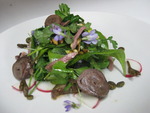 spring greens with confit duck hearts, smoked duck, violet, wild grape balsamic
spring greens with confit duck hearts, smoked duck, violet, wild grape balsamic
Once the tree cover is in, the sprouts that make for an abundant spring mesclun disappear. François scurries from one regional micro-climate to another in order to extend the window of spring bounty until it’s absolutely over. The salad bowl takes on a different hue without the spring beauty, trout lily and linden, losing some bite without the dandelion, less garlic mustard leaf and crinkleroot leaf. Out with the violets, in with the dame’s rocket.. Daisy leaves assume a more important role along with the stonecrop that is still good picking in shady spots. The first sea peas and salsify sprouts have arrived to liven up the mix too. Some lady sorrel for lemony surprise. There are baby lambs quarters and soon the marine greens from the Bas du Fleuve will be the green stars. In the wild, spring is salad season; in summer, you have to work harder.
I managed to not miss out on the spruce tips this year (never a priority, but yay), so I candied some and made a delightful bonus syrup, which will go into granite and semi-freddo with the first berries and surely some sweetgrass, alongside a wild ginger chocolate babycake.

Now I’m in the process of drying stinging nettle for tisane, blanching and vacuum packing it for soup and pesto. With 60cases of fiddleheads done, it’s just about time to resume canning - the next big operation will be pickling daisy buds, and following that, day lily buds. Throughout, we will be harvesting the various flowers to make syrup and to dry for our tisane and line of aromates/spices. Then it will be milkweed, cattails, bee balm and day lily petals, the berries and mushrooms. So much to do before the mushroom onslaught..
It’s one thing after another in our race with nature, as our dehydrator starts working round the clock, me and my staff not far behind.. My pots and pans too busy for anything else like protest marches. Meanwhile François’s field crew has a bit of a breather after spring (their hardest season) and before the next big thing, as they work on pulling out bad weeds instead of picking good weeds, planting herbs and other treats for our garden. Yes, gardening is akin to vacation time for the pickers of wild things! We aren’t completely sauvage; we like to have the other stuff too that are indispensible or might like to grow here - say tomatoes, onions and garlic, bee balm, chard, romaine, peppers, crosnes, and pears..
Witch tricks
Ok, so this is another non-food related post. I better watch out, I might just lose my following..
The funny thing is that I still spend most of my time cooking up a storm, and I remain just as enamoured with the kitchen and wild edibles, but I guess it’s become just so normal and day to day that as time goes by, I seldom think to take photos or write about it. I was all about doing that five years ago. I will get back to it no doubt – no choice but be all consumed by cooking and putting up the wild stuff as the season takes hold.. But for now, I'm still all about the witch tricks.. And some of you asked for recipes, so here goes. Following up on my last post http://soupnancy.squarespace.com/blog-journalessays/2012/4/14/almost-a-witch.html
Some recipes and tricks from my witch’s den
(g means goutte=drop, not gram)
I apologise in advance for common names as opposed to Latin, not to mention French and English mixed.. It’s my way, how my Quebec mind works, true to the fact that my blog is for fun, not a reference for every other budding witchdoctor out there.. While I am careful (about the true name in one language or another) and honest, I don’t need or want to feel the need to be technical.. If you have questions about a certain term/plant/essential oil, you can do your research and/or contact me.
Cold medicine: I felt cold symptoms coming on and started taking a mild combo of essential oils; it seems that I kept the bug at bay and killed it; I didn’t get sick. I haven’t yet had to pull out the strong ones (oregano, clove etc), just a bit of cinnamon.
- Infusion of wild ginger, tusselage, thé du Labrador, ortie, eglantier, sureau, in cinnamon water or even just water (50ml)
- Honey (30ml)
- Essential oils of best quality (1tsp or 25 drops): 15 g citron, 5g tea tree, 3g peppermint, 2g cannelle vraie
This is taken like cough syrup, a teaspoon 3x a day or when needed.
You can make a diluted version and vaporize (spray to the back of the throat) more often.
I also made a more concentrated version with only the oils diluted in olive oil (20% or 3 drops in 1/2tsp), and this can be taken as medicine (1/2tsp, 3x day with meals). This same mixture can be applied onto neutral orme(elm) tablets (1-2 drops per pastille) and taken that way instead, convenient on the road/not at home say.
On the side, it is optimal to eat lots of garlic and onions (I prefer this to rubbing my feet and thorax with garlic and onion juice or sticking garlic cloves into orifices, although this is said to be quite effective)..
Burns:
I burned myself badly in the kitchen.. Yes, even after close to 20yrs as a professional cook, it still happens regularly. So, I dunked my hand in ice cold water (as usual), then plunged in a cider vinegar bath a few times before bandaging.. It seems that the cider vinegar worked miracles - no bubbles, no scar, pretty cool. Apparently dipping in egg works well too, which is convenient in the case of a digit, not so much for a whole hand – I wasn’t going to crack open a dozen eggs. Honey is supposed to help heal too.
Cuts:
Last week, a waitress cut herself wiping glasses. We disinfected with cider vinegar (ideally diluted with some distilled water); to stop bleeding, we sprinkled the cut with black pepper or even better cayenne. In season (soon!), smashed up plantain would have been a great help. I made her a cream to help healing/diminish scarring with sauge, lavender aspic, bois de rose, geranium in a mix of calendula oil and argan/jojoba (5%).
Poison Ivy/bug bites/damaged hands/athlete’s foot:
I sent my dishwasher/commis out to pick some flowers and garlic, he came back with poison ivy. In fact, we didn’t know until days later when he had welts all over his body, obviously having spread it by scratching. François went out to pick the neighbouring plant that is a natural antidote (impatiente du cap), which you chop into a paste (or Robot coup is best) and spread all over. I also made him a mix of diluted cider vinegar with Lavender and tea tree. This is a mix I now keep in the kitchen for all burns, wounds – it’s a natural antiseptic, calming agent and proponent for healing. The same mix is good to clean dirty, damaged hands after a day of picking, getting scratched and cut and bitten while covered in dirt . BTW Also perfect for athlete’s foot (on a daily basis), or simply to add to a foot bath or to apply to feet for refreshment or against stinky feet..
My boosters - Tonics for all round better function
No need for vitamins and mineral supplements with these, I figure..
I have made two tisane potions, one for day and one for night. Concentrates that I dilute with water to drink – typically cold during the day and hot at night. Bring water to a boil, turn off, throw in fresh and/or dried greens and herbs. Let steep an hour or two, even overnight; strain and jar. In the day potion, there is stinging nettle, achilee millefeuille, peppermint, elderflower, wild ginger, lovage, thyme, black pepper, juniper, fennel, coriander, basil and more.. I kept the night mix simpler and free of stimulants: heavy on Labrador tea and camomile, with some wintergreen, wild rose, and of course stinging nettle..
I can’t say how much they might help anyone, but I made them taste good, with a pinch of this and that like when cooking. The idea is less formally ‘nutraceutical’ but just a pleasant drink to replace juice, pop or wine that happens to be ultra healthy. Based on what I have learned, they are packed with nutrients and compounds that help all round digestive and immune function, stress and mood too, in my day blend especially.
All fine and well, but I still have to get used to drinking tisane outside sitting down for ‘tea’, I mean at any time of day, naturally craving and reaching for it before any of my other customary liquids. As the weather heats up, I do like a good homemade unsweetened ice tea, so I’ll be ready.
A few of my favourite concoctions that I truly love, perhaps even increasingly addicted to.. That have sold me on Essential oils ie. Aromatherapy.
My sleep aid:
A straight up mix of essential oils: true lavender mostly, some orange, ylang ylang, a few drops of eucalyptus citroné and geranium.
This provides an instant light buzz and calming numbing sensation.. I hear this might knock some people out but I don’t know, nothing knocks me out.. It does however soothe me, quieting much of the action in my head, making me more likely to fall asleep sooner. It works better than anything else I’ve tried and I love the way it smells/feels.
My mouthwash/anti-bacterial mouth spray:
Peppermint (35), Lemon (25), Eucalyptus radié (20), Pamplemousse (15), Thyme (10), Tea tree (10) diluted in water or water with an ounce of alcohol to make 500ml or 5%. I use it as mouthwash before brushing my teeth and like to carry around a spray bottle for times I can't brush or want to freshen my breath. I just love this!
My muscle massage oil:
Basil (30), Eucalytus citroné (20), Wintergreen (20), Lavender(20), peppermint (10); diluted in vegetable oil of choice (at first I used olive because that is what I had, but now I like to play with jojoba, almond and argan oils in the mix); 3-5% depending on how often you use it/localised or over a large area of skin, say 5 drops per 15-30ml of oil is a safe guide. I find it really helps with muscle pain.
My face cream:
Bois de rose(5), Geranium(3), True Lavender(2), Sauge(1), Ylang Ylang (1) in a little argan oil which I blend into a neutral jojoba based lotion that I buy at Noblessence on Laurier: 12 drops per 30ml (4%, but 2% is more common) I truly adore this and it makes my skin feel great.
My bug stuff: A starter cocktail, to be adjusted over the season; I’m ready to make it as varied and strong as I have to.. I started at 5%, and quickly went to 10%. This new dose seems to work; the buggers still swarm, but stop and leave. It seems to last for at least an hour or two, maybe not quite as long as a deet based cream, but not bad. Now, I’m playing with proportions – more or less mint or eucalytus/piney scents..
Eucalytus citroné (30), Lavande(20), Menthe poivré, Menthe verte (20), Pin sylvestre, Camphre, Cedre, Sauge (30)
Digestion – I don’t have digestive issues (probably because I eat lots of fruit and veg and next to no processed/refined/industrial food), but many people I know do, so this interests me..
An essential oil rub can help, but an internal treatment for a couple of weeks might be in order for a chronic problem. Huile de ricin (Castor oil) is supposed to work miracles here both externally and internally (in certain cases); I took a class on it but haven’t experimented.. With the essential oils though, yes..
External:30 basilic, 20 menthe poivrée, 20 Lavande vraie, 20 citron, 10 Eucalytus citroné
Diluted in hazelnut oil or vegetable oil (10% or 5 drops per 10ml) Others essential oils that are good here but not in my recipe only because I had to make a choice, or I don’t have them or they are too expensive/hard to find: Camomille, Orange, Bois de rose, Gingembre, Pin maritime, Fenouil, marjolaine, romarin, noyeaux d’apricot..
Internal: 40 basilic, 30 Citron, 30 Menthe poivrée (Bay or thyme could be added, but only for a short term treatment (10 days)).
Diet is obviously key here, diminishing meat and things that are hard to digest or that cause acidity, monitoring what causes problems for the person in particular with a food diary. One thing is for sure: diminish sugar.
For an adult, a cleanse might be in order: citron, basiilic, carotte sauvage and either bay/thyme/canella or tea tree (I like the last two, milder); 20% or 3 drops diluted in 1/2tsp olive oil 3Xday for 2-3weeks. All while eating well etc..
Exema
Again, no personal experience, but I have many loved ones with some kind of exema. From knowing them and from my classes, I understand that there are many different kinds and that everyone is different.. Every specialist has his/her opinions. But no matter who the specialist or what the ‘xxx..apy’ , they all agree that exema is complex – often related to diet, liver and intestine function, and very frequently tied to emotional issues and stress.. So there is a primary need to treat at the source; balms for the skin remain secondary. Sometimes, there is a Mg/Zn deficiency or other. Greens are beneficial and sugar is detrimental always. Caffeine and alcohol are problematic, as are chocolate and spice.. to what degree depends on the person. Gluten and dairy for many too.
Decreasing the acidity diet wise appears to be beneficial (often candida goes along with it), but what causes acidity is counterintuitive (lemon is good, meat is bad).
One thing that stands out to me above all: The best thing my sister (who has had bad excema all her life) ever did was reduce her workload & stress, ditch the rat-race ideology of working and making money above all, add fun hobbies and pay attention to her diet (ie. improve quality of life). Good for her. I made a salve in case she wants it some day and my mom is presently trying it out. I can’t/won’t say it will work miracles for them, but so far, my mom says it helps..
In 15ml huile argan/soucis/jojoba: 2g menthe verte, 2g cedre, 2g lavande aspic, 1g ylang ylang, 1g geranium (would have loved to add camomile but it is soo expensive; but you can always use a compress of strong camomile water or tea intermittently..)
Camomille water is also a terrific cleanser/toner for skin. I was never convinced all the rigamoroll the girly magazines and esteticians recommend was necessary wrt to skincare, but if I think to apply a toner before moisturizing, this is it.
Funny thing with essential oils, they seem so strong scented at first, but the more you become accustomed to them, the less that is true.. They tend to grow on you, and even take hold as they become an integral part of daily routine/life.. For instance, initially I found the smell of Tea tree unbearably aggressive and medicinal, but now I don’t mind it, perhaps even like it – because I now am used to it, have seen it work, believe in it too?? Same with Ylang Ylang – I was never into anything reminiscent of patchouli, but now I love both, probably because I associate them with relaxation or soft skin. Natural aphrodisiacs, maybe there’s something else going on there, who knows? Nor did I think that I was particularly fond of floral notes outside of nature, in cosmetics for instance.. But I guess I am when they are natural as in the form of essential oils. I really no longer have any tolerance for synthetic aromas and I can always pick them out..
Another funny thing about essential oils/aromatherapy is that most people see it as hokey pokey stuff and benign, like I used to and still think many natural remedies are (of the cost effective tablet/tisane variety available at the health food store or pharmacy).. But quality essential oils are concentrates of plants that are high in medicinal compounds – so a football field of a plant distilled into a little jar with all its active molecules, the same molecules that the pharmaceutical companies try to copy/compose with. It’s equivalent medicine, but more natural with less side effects if properly used, and just as toxic if not. Which is why they are not recommended for use with pregnant women and young children for the most part. The English don’t use them internally while the French do, ha (but you need a prescription; while here you don’t despite all the crap out there).. I suspect that both terms (be it essential oils or aromatherapy) do nothing to help them in being taken seriously.
Meanwhile, everyday I hear from people close to me (or with a few degrees of separation) about their various maladies and malaises.. Collegues, their spouses and kids with recurring infections; our parents and their friends; in some instances, severe cases of mysterious symptoms that baffle the doctors. Mothers with kids who are always sick, or with allergies, whatever.. Altogether, all kinds of people not finding answers in the conventional medical system. And then I see the courageous fighters in my classes who have taken things into their own hands, caring for their families with their plants and natural remedies without much need for doctors.
I don’t know enough yet to be coaching people, but I see all the possibilities and feel frustrated in face of all the lost souls looking for answers and relief. Maybe one day, I will be able to help. But one thing is for sure, if it were me who was really sick, I would do everything in my own power outside and/or alongside the traditional treatments, even if it meant clay and castor oil or names of treatments that sounding like aromatherapy.
I think any remedy for anything should start by eating well and spending time in nature.. That, I know about for sure. The rest is bonus, a world to explore - but it will come, I’ will be working on it.
Pots and pans
Ok, not food related beyond the pots & pans.. But living in Quebec these days, the massive and persistent ever morphing student revolt has taken over, even in foodie territory.
Personally, I was getting quite tired of the student manifs, but I can’t help but dig all this pot & pan action of late; it’s something else seeing it Quebec wide, tis almost a party.. It would be altogether inspiring and seriously promising if the reasons for the mounting fervour weren’t so jumbled. The powers that be have no choice but to stop and listen, be attentive and bend toward the people, which is positive. But!
If only the students would accept the reasonable tuition price hike after a 20+yr freeze c’mon, ie. agree to pay 17% of their higher education, by maybe getting a part-time job or giving up a vacation or Iphone.. Then people like me (quite silent these days) might cease to see them as entitled babies and be proudly behind them 100% in their fight for change on the bigger issues now in the mix..
There is so much to fix about our system and such a public outcry can do a lot.. Good for them for getting on their feet, and showing us that it is possible. But better it be a shake up against corruption and how our money is spent, exploitation of resources and environment, or laws that favour the 1% - the banks, big business and foreign interest vs youth, local entrepreneurs, etc. etc. Pick one or two, anything except minimal tuition fees. An Occupy style movement with these student leaders might actually be able to do something grand if they could coexist..
Yes, Fight for your rights, ideology, and change! All for it. But no matter what, at some point, you have to accept a few laws for the common good, buckle down and work hard to secure a future. Yes, work, work your ass off. Our system, however flawed, is one of privilege, and even if it could work at its best, it would still cost a lot of money, meaning everyone has to do their part.
To finish on an uplifting note nonetheless: this video circulating is more of a romantic take - no window smashing here or political discourse..
http://www.jeremiebattaglia.com/Casseroles-Montreal-24-Mai-2012
First morel

First 2012 morel from our backyard! The hunt is on..
Morels are such a tease - one here and there, never a whole bunch (except for up north in forest fire country perhaps).. At least this one is enough to serve two!
And then these showed up, jackpot! Du jamais vu!
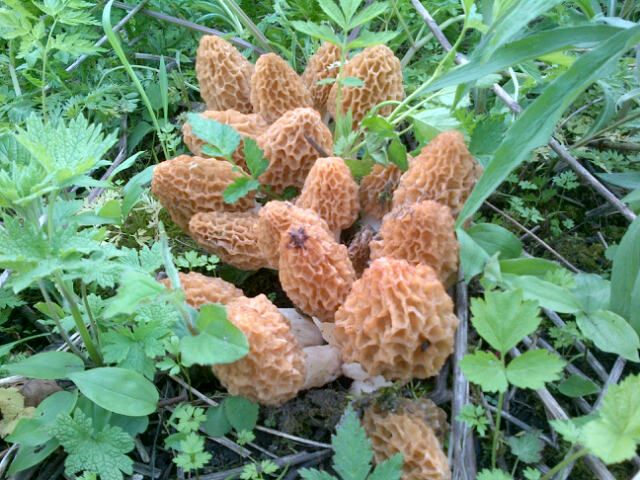 exceptional morel cluster like no one (we know) has ever seen
exceptional morel cluster like no one (we know) has ever seen
Fiddleheads, for once and for all
What to do with fiddleheads for once and for all
As the fiddlehead season peaks, the same old questions resurface.. Clients hungry for the first local greens are keen, but at the same time half frightened, wanting to know how to cook them all over again; the MAPAQ is at our door worried about intoxications..
Although there never has been an incident with our fiddleheads, it appears that every spring in recent years, there have been several cases of ‘food poisoning’ Quebec wide– we’re talking stomach pain here, not death by the way. Probably because a few fools ate a whack of unwashed, raw specimens, perhaps even old and/or from a polluted source, if they were even from the correct fern in the first place..

Sadly, many people are scared of fiddleheads for no good reason. It seems that the government campaign warning about a fiddlehead ‘toxin’ has been effective. In a way, maybe that is a good thing because there are customers who show up at our booth and pop raw fiddleheads into their mouths off the counter, or want to pick their own without a clue, not to mention the growing number of raw-foodists who are determined to eat them raw despite our warnings. Nonetheless, I like to think that most people are not them, and a touch wiser.
The thing is we all agree that uncooked fiddleheads are a bad idea. Toxin or not, there is something in there that makes them hard to digest in the raw state, that animals in the wild are aware of too (they don’t eat them), and besides, they simply do not taste delicious as is or aldente anyway.
It is also important to note that ‘we’ in the New World, have been eating cooked fiddleheads for a long time without a problem – tis a natural, local, traditional rite of spring in Quebec (as well as in New Brunswick, Ontario..). François’ family has been picking in the same sites and eating the same crop that supplies our market stand for over 50 years; François has been harvesting them and selling them for 25 years. And I repeat, never an issue.
After a wave of sore stomachs somewhere in Quebec in the spring of 1999 (60 cases), Govt warnings about a toxin became prevalent. All for a toxin that no one, not even the govt agency seems to be able to identify.
I couldn’t help but wonder about this unidentified ‘toxin’, and how it has eluded us and so many others for decades. Was it really proper to the fiddlehead or in the water? Could the few cases of poisoning have been due to a single source, age or improper storage? I needed to know, but no one has ever been able to answer my questions completely to this day.
A couple of years ago, I went really digging, govt. documents, newspaper articles, scientific journals, to find all sources leading in circles. I even stumbled upon a Santé Canada document that stated there was no toxin in fiddleheads, ha.
Upon consultation with plant scientists at the University of Guelph (the reference wrt food science & agriculture), it seemed likely that the fear might be more bacterial than a toxin persay. Which makes sense given that they grow in dirt and water. And that would explain the govt directives to boil for an extended amount of time; in the case of a ‘toxin’ useless. So, as I suspected, the few cases of intoxication were probably due to a contaminated source eaten raw. But of course, that is too complicated to explain, much easier to issue severe warnings until they figure it out. And without the likes of me pressuring them, I’m not even sure they’re working on figuring it out, preferring to enforce fear and a 15-20 min cooking regimen.
A scientist explained to me how they come up with these numbers in the first place given any threat, ie completely theoretical. They are ultra conservative since they use the most resilient enzyme and the least acid vegetable (not even actual fiddleheads say) for their tests. For eg. at 120C (steam), after 3 min, 10% remains; at 5 min, zero. After 5 min even at 100C, there is not much chance of anything, but to be safe, might as well say 10-15 or why not 20 min, just in case there is the worst ever bacteria in given foodstuff.
Which is fine I suppose; I understand that the government has to protect every person (stupid or not, fragile constitution or not) from every bug and fiddlehead out there (quality or not, fresh or not, from any source, polluted or not). But for us, this is very frustrating on principle; especially that it directly affects our business. After all, this is a super nutritious local vegetable with a long tradition, that is readily accessible and not dangerous at all if fresh and properly cooked. Certainly much safer in the big picture than all the sterile non-food crap coming out of the industrial system that clears all the government lights but is slowly making everyone sick and allergic to nature. Don’t forget that a bowl of berries or a plate of asparagus or a spinach salad might give you a belly ache and send you running to the bathroom if you daily feed off processed food and never eat fruit and vegetables, but then perhaps a cleanse was in order, but I digress.
In particular, we know where our fiddleheads come from, taking care of every detail from A to Z – picking only tightly curled, young specimens barely breaking ground, washing them thoroughly, storing them properly, selling fresh quality, offering up cooking instructions and everything. We have a solid record and reputation. Yet, we still have to defend ourselves year after year.
Meanwhile in supermarkets and via big distributors, there are loads of sketchy fiddleheads being dumped at a low price from un traceable sources, often obviously picked at an advanced stage (easier picking, ie cheaper), and old from being kept too long (from picking time through distribution to package).. I imagine this is the source of any sore stomachs, paired with a handful of mis-informed dopes hitting a bad batch, then not washing them and eating them insufficiently cooked.
Go to any restaurant, or to any home that has had fiddleheads on the menu for generations. No one is boiling them for 15 minutes. They turn to mush in 15 minutes. 5 minutes in boiling water is plenty if you have good fiddleheads and wash them first. Most often, they are given a second cooking anyway, be it pickling or stewing or for a sauté.
I know of one good recipe where they are overcooked and still yummy, from the Bas du Fleuve. Simmered in a salt lard onion broth for 20 minutes, there are left to sit overnight and reheated. Pale green and mushy, they are not aesthetically pleasing this way but delicious, reminiscent of slow cooked collard greens..
However, especially in spring when the body craves it, it is nice to be able to retain some small resemblance of green and crunch along with a thorough cooking. For detailed instructions, see below to see how we tell people to cook fiddleheads..
It all comes down to washing them and boiling in lots of salted water until they are cooked through, period. Depending on the quantity, the size of your pot and water, this could be 5-10 min, even less if the water doesn’t stop boiling. With good fiddleheads properly flushed, your water should be reddish after, not black. I used to stand by a double blanch for less time, but this was with a restaurant setting in mind when you want to optimize color and crunch while ensuring sufficient water flushing and minimal cooking time. But it’s completely unnecessary! It just allows for a touch more texture and colour with equivalent exposure to heat and water. My perfectionism while wanting to cover all bases and please the MAPAQ ended up biting me in the butt because this procedure was propagated and I feel that it ultimately made people even more afraid. I would later hear foodies say, ‘oh don’t you know you need to cook them twice’ and I would inwardly groan; I even heard it from a government official once. Geez, I started it - shut up. I take it all back – just source well, and cook them for a few minutes in lots of water for god’s sake.
They are delicious sautéed with garlic afterwards, with a splash of tamari and lemon, salt and pepper. The oriental treatment with garlic, ginger, chilli, and sesame is winner too. Better yet with bacon, shallots and a touch of cider/sherry vinegar and meat jus. With potatoes and braised meat, in an omelette or with anchovies, pasta and tomato sauce, the options are endless..
The season is in full swing here, about to wind down, but is only getting going in the Outaouais, still weeks away in the Gaspesie.. So there are Quebec fiddleheads to be had for the next month or more for sure..
No need to be afraid. Just don’t be stupid, and Enjoy.
 Here in warm bacon dressing, with wild greens (linden, stonecrop, violet), pickled hen of the woods, crinkleroot eggy potato
Here in warm bacon dressing, with wild greens (linden, stonecrop, violet), pickled hen of the woods, crinkleroot eggy potato
JS Cooking Instructions below..
Cooking Fiddleheads
Wash well and Blanch before adding to a dish: Use lots of salted water, cook for 5 minutes after returning to a boil
*Or Boil twice for less
to optimize colour and texture - Add to boiling, salted water for 2. Change the water. Repeat. Refresh in ice water.
and then sauté
or add to any preparation..
To serve hot :
Sweat with butter or olive oil, salt, pepper, garlic or seasonings of choice (tamari, chili pepper, ginger, citrus zest, bacon, herbs, ie. dill, chives..
To serve cold :
Pickle or Dress with vinaigrette, add to composed salads, pasta or potato salad, greens.
Bon appétit!
*The important thing is that the fiddleheads are of good quality from a traceable source,
that they are washed and fully cooked through.
Les Jardins Sauvages
17 Chemin Martin, St-Roch de l’Achigan
(450)588-5125 www.jardinssauvages.com

